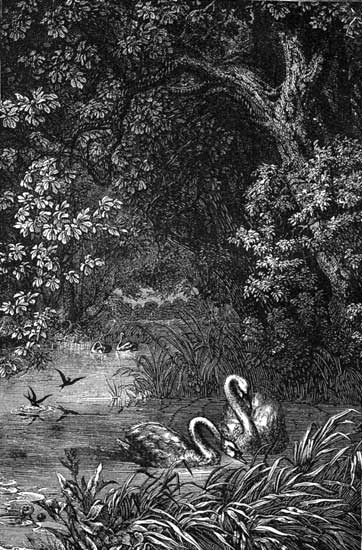 Away from the Haunts of Men.
Away from the Haunts of Men.
 Away from the Haunts of Men.
Away from the Haunts of Men.
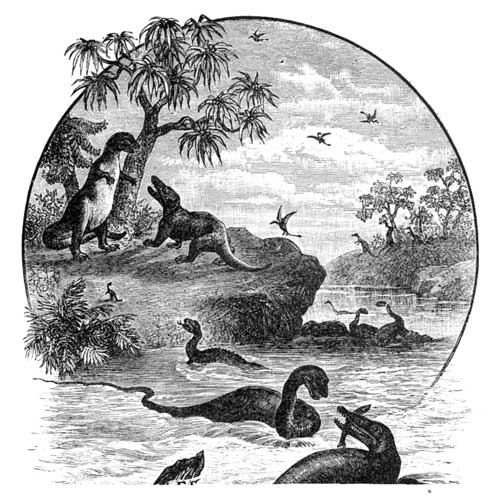
NEW YORK
D. APPLETON AND COMPANY
1887
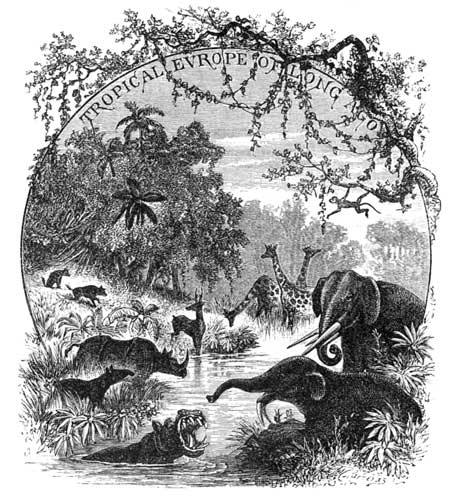
Copyright, 1887,
By D. APPLETON AND COMPANY.
The reasons why this book appears as appended to the series of the Natural History supplementary readers are as follows:
In preparing the third and fourth books of the series, much more matter accumulated than could be contained in the volumes of the size contemplated; and the only alternative was either to cut down the chapters by leaving out a large share of the story part, or to drop whole chapters, thus omitting the notice of many orders of animals, and marring the original plan of the work. After deliberation, the latter method was adopted, and reluctantly the four volumes were given to the public with important topics wholly omitted. The amount of this matter was so great that it was at length resolved to make this additional volume, so that our little friends at home and at school may have the story of animals and the simple outline of their description nearly complete.
These books do not aim to take the place of a scientific treatise upon natural history, but rather they are designed to serve as an [Pg 4]introduction to the study of the subject by the way of observations made and interest excited. The method is the same as in the other volumes of the series; in each order of animals the study of home specimens precedes the foreign, and the study itself rises from the observation of facts in a single line of investigation to a perception of the relation of these facts to each other, and the wider relations which they sustain to other departments of thought.
We are not unmindful of the fact that reading-books are supposed to be specially prepared to teach reading; but we are also impressed with the more profound truth that reading implies thought, and hence that reading-lessons must be both intelligible and interesting.
For children, there seems to be a charm about stories of animals that awakens thought, and in their eagerness to give this thought expression they often leap over mere mechanical difficulties, and acquire skill with the ease and rapidity of intuition.
It can not be too strongly borne in mind that the reading of words without understanding the thought must be monotonous and vicious in style, and that all effort on the part of parent and teacher to correct such habits, while the causes continue, must prove abortive. The remedy will come from the use of matter which reaches the understanding and [Pg 5]furnishes positive instruction.
| CHAPTER | PAGE | |
| I. | —The Scavenger Bird | 9 |
| II. | —Birds of the Past | 13 |
| III. | —The Shag | 22 |
| IV. | —Our Slow-footed Neighbors | 24 |
| V. | —The King of Tropical Waters | 30 |
| VI. | —Scaly Tenants of the Wild | 36 |
| VII. | —Animal Life in Madagascar | 45 |
| VIII. | —Birds in Spring. | 50 |
| IX. | —About Eels. | 53 |
| X. | —Frank Buckland at Home. | 62 |
| XI. | —Tom. | 69 |
| XII. | —The Dog who attended Fires. | 71 |
| XIII. | —Crawling Occupants of Grass and Woodland. | 73 |
| XIV. | —Poisonous Creepers of the Wilds | 81 |
| XV. | —Wings of Gossamer and Gold | 90 |
| XVI. | —Wings, Busy and Sober | 99 |
| XVII. | —Flying-Bugs and Walking-Sticks | 108 |
| XVIII. | —Fruit and Grain Destroyers | 115 |
| XIX. | —Spinners of House and Garden | 123 |
| XX. | —Spider Ways and Spider Stories | 129 |
| XXI. | —Locusts in the East | 136 |
| XXII. | —The Birds must Know | 142 |
| XXIII. | —Tigers of Copse and Hedge | 144 |
| XXIV. | —Diggers for Grubs and Beetles | 154 |
| XXV. | —Grubbers for Ants | 161 |
| XXVI. | —Plantigrade Rangers of Field and Forest | 171 |
| XXVII. | —The Pouched 'Possum and its Kin | 180 |
| XXVIII. | —The Leviathan of the Deep | 190 |
| XXIX. | —The Sea-Monster of the Amazon | 198 |
| XXX. | —Dwellers of Sea-shore and Ice | 204 |
| XXXI. | —The Flying Mouse | 213 |
| XXXII. | —My Dog Fido | 222 |
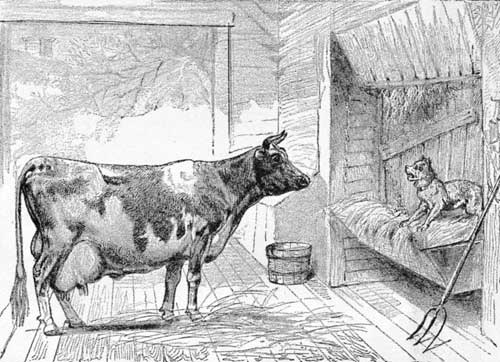
A dog was lying upon a manger full of hay; a cow, being hungry, came near and offered to eat of it; but the envious, ill-natured cur, getting up and snarling at her, would not suffer her to touch a morsel; upon which the cow, in the bitterness of her heart, said, "Thou art a very malicious wretch, who will neither eat the hay thyself nor suffer others to do it."
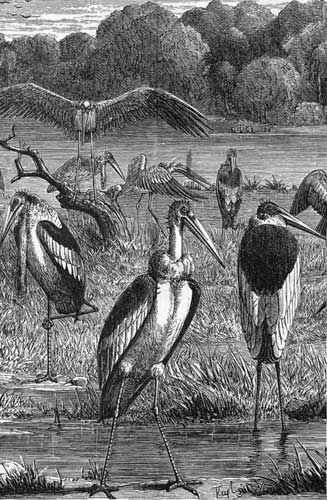 The Adjutant-Bird.
The Adjutant-Bird.
1. The wading birds, living in swamps and along the margin of lonely lakes and bayous, perform a work serviceable to man by keeping down to a bearable limit the vast reptile horde, which would otherwise overrun the country. Frogs, snakes, lizards, and young alligators are all devoured in incredible numbers, and the strange, silent bird, with his long legs and enormous bill, disputes with the alligator the sovereignty of the swamp.
2. Some of these waders have taken up their abode near the homes of men, becoming nearly as tame as the common tenants of the farm-yard. In Holland the stork is a welcome visitant to castle and cottage alike, and, when it builds its nest on the thatched roof of dwelling or stable, the event is regarded as a good omen, bringing health and happiness to the members of the household. Besides being the harbinger of good luck, and a pattern of filial duty, the stork performs a real service in waging war upon reptile and vermin, and so[Pg 10] saving the people from many troubles and discomforts.
3. In South Africa, the secretary-bird, a cousin of the stork, is looked upon as one of the best friends of man. This bird seems to have a special animosity against poisonous snakes, and will attack and kill them whenever they are found. When tame, it becomes a peaceful inhabitant of the farm-yard, and very useful in protecting the weaker members of the community from the attacks of vermin and birds of prey. It associates little with its neighbors, and never interferes with them, except to prevent a fight, and cocks and turkeys soon learn to respect the power that is exerted in the interest of peace.
4. Another member of this family of birds, and the largest of them all, is the marabout of tropical Asia and Africa. This immense bird is nearly as tall as a man, and its outspread wings would reach from side to side of a good-sized room. It stands on sturdy legs and strong feet, with toes wide-spreading and partly webbed, so as not to sink easily in the mud. Its feathers are of a dusky ash color above, with somewhat changeable tints, and white below. The side and under tail-feathers are long, white, light in texture, wide-spreading and delicate, rivaling those of the ostrich in form and beauty.
5. The neck and the head of this bird are large, nearly bare of feathers, and are covered with a red[Pg 11]dish, warty skin. In front, from the lower part of the neck, a fleshy wattle, like that of the turkey-gobbler, hangs down several inches in length. The bill is yellow, broad at the base, and tapering to a point, and as long as a man's arm. It opens so wide that the bird can take in a cat or a quarter of lamb and swallow it whole. At a distance it resembles an officer in light-colored waistcoat and breeches, and hence the English have given to it the name of the adjutant-bird.
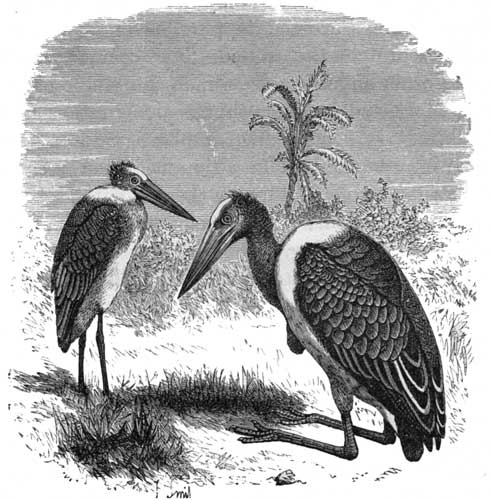 The Adjutant-Bird. Showing the Foot resting from Heel to
Toe upon the Ground.
The Adjutant-Bird. Showing the Foot resting from Heel to
Toe upon the Ground.
6. The first joint on the leg of a bird above the ground does not bend forward like a knee, but it turns back like the similar joint in the leg of the cat. This joint is the ankle, and all birds and many animals are toe-stepping, never resting the whole foot upon the ground. The bear, as well as some other animals, treads upon the whole length of its feet, and seems to shuffle along rather than walk. It is hence called a plantigrade or foot-stepping animal. The adjutant, when resting, places its whole foot upon the ground, like the plantigrade animals, and seems to be squatting rather than standing.
7. In its wild state, the marabout lives in lonely marshes, on frogs, fish, and such other inhabitants of the water as it can pick up. It does not hesitate to attack poisonous reptiles; and in India, where the cobra is so dreaded, this bird is regarded as a friend of man, and is protected both by law and by the general sentiment of the people. It is easily domesticated, and in Calcutta and other cities of India it roams unmolested through the streets, eating up everything in the form of garbage, and effectually performing the service of a scavenger. At meal-times these birds draw themselves up in line in front of the barracks, to eat the refuse thrown out by the soldiers, including enormous bones, which they swallow whole.
8. When tamed and kindly treated, the marabout attaches itself to its owner—sometimes, in[Pg 13]deed, becoming very troublesome in its familiarity. It is related that one of these birds was accustomed to stand behind its master's chair at dinner-time and take its share of the meal. It was, however, a great thief, and was always looking out for an opportunity to steal the food on the table, so that the servants were obliged to keep watch of him with sticks in their hands. In spite of their vigilance, it was often too quick for them, and once it snatched a boiled fowl off the dish and swallowed it on the spot.
1. As civilized man advances and takes possession of forest and plain, the larger wild animals that formerly inhabited the region must either come into his service or be destroyed. The wolf has disappeared from the eastern forests of America, and the bear is found only in the most remote places. In Asia and Africa, lions and tigers retreat as the wilds become settled, and take up their abode in inaccessible mountains and jungles; and the rhinoceros and giraffe are rapidly disappearing, as they demand a wide range for their food, and must be destroyed to protect the crops of the farmer. The elephant is made a servant of[Pg 14] man, and will probably survive in a domesticated state, long after his wild kin have disappeared from the forests.
2. The same fate awaits the larger birds. Most of the feathered tribe have special means by which their lives are protected. Rapid flight carries them beyond the reach of man; and beauty of plumage and song renders them objects to be preserved rather than destroyed. But the birds without the power of flight can not escape from the advance of the settler, or from the keen eye of the hunter. If they can be made to serve man, their existence may be prolonged; but if not, they must perish from the earth.
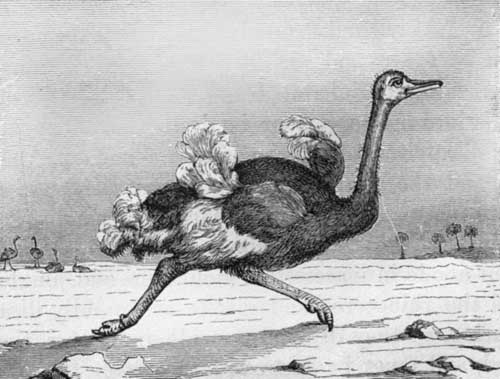 The Ostrich at full Speed.
The Ostrich at full Speed.
3. The ostrich is as well equipped for living in[Pg 15] semi-desert regions as are any of the larger animals. It has great strength and speed, and will fight or run as the occasion requires. While it can not fly, it is bird-like in its whole structure, with boat-shaped body, light, hollow bones, and soft, light feathers. Its wings, too small for flying, aid in running by performing the office of sails. Its feathers, also, having no need of being compact to resist the air like those of flying birds, have no little hooklets binding the parts together, but are loose and downy so as best to catch the wind.
4. Miss Buckley says: "There are soft pads inside of the two toes of each foot, and these rebound from the yielding sand as the well-bent legs straighten with a jerk one after the other, making his body bound forward at full speed. Then he raises his wings, sometimes on one side, sometimes on both, to balance himself, and to serve as sails to help him; and with this help his stride is sometimes as great as twenty feet, and he dashes along at the rate of twenty-six miles an hour, rivaling the rail-cars in speed.
5. "If we go back to long by-gone times, before the lion, the leopard, and other ferocious animals found their way into Africa, we can imagine how this great running bird took possession of the land, and, finding food in plenty, soon became too heavy for flight; while, as time rolled on, it gained that strength of body and leg which afforded it protection from enemies of all kinds. It could[Pg 16] travel over wide distances from one oasis to another, feeding on seeds, fruits, beetles, locusts, and small animals, and fighting fiercely with leg and beak if attacked."
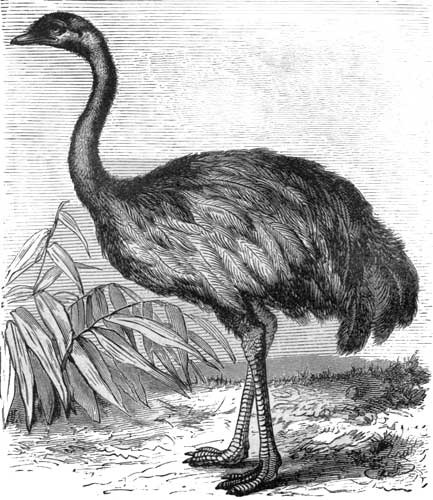 The Ostrich at Rest.
The Ostrich at Rest.
6. But the protection which nature has afforded the ostrich in its struggle for existence against wild beasts and savage men, is of no[Pg 17] avail against the arts of the practical hunter. The speed of the bird is no match for trained horses in relays, so that a fresh one is ready to continue the chase when the last one gives out; and its strength is useless as against gunpowder and the rifle. From year to year, as explorations are made and settlements spread, the wild flocks of this bird retire farther into the interior of the continent, and, in the natural order of events, it is on the high-road to extermination.
7. One peculiarity in regard to its plumage, however, and one in regard to its disposition, serve to prolong its existence. The light, graceful feathers on wing and body are highly prized as ornaments for ladies' wear, and the bird is easily domesticated. So, the ostrich is now rapidly changing from the wild tenant of the desert to the peaceful occupant of the farm-yard, where it enters into the service of man as the fowls and turkeys have done in the time gone by.
8. The cassowary of New Guinea and adjacent islands is a cousin of the ostrich, and but little inferior in size. It is a stupid, gluttonous bird, devouring fruits, herbs, and small animals in great numbers. Its flesh is coarse and unsavory, and there is nothing graceful or beautiful in its coat of black, hair-like feathers. It has no qualities to render it serviceable to man. A few pairs are usually found in the principal zoölogical gardens, but the birds are too wild for domestication, and in[Pg 18] their native regions they are becoming scarce. When New Guinea becomes the center of a civilized community, the cassowary will probably be numbered among the birds of the past.
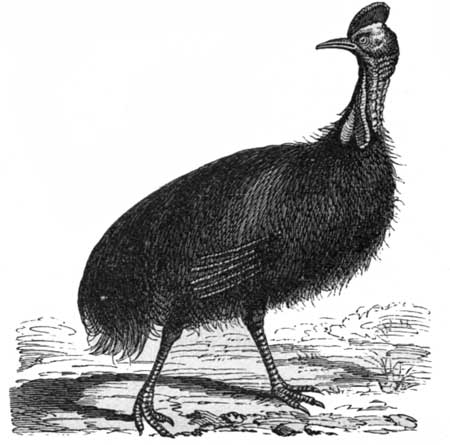 The Cassowary.
The Cassowary.
9. The emu of Australia, belonging to this same family of birds, is nearly as large as the ostrich. It is wild and timid, running away from danger with the speed of the wind. It is much like the ostrich in structure, but has no ornamental plumage. It shuns the presence of man, and has entirely disappeared from the settled regions of Australia. It is probably destined to extinction at no distant day, for, though its flesh is esteemed as an article of food, its appetite is too voracious to make its preservation profitable.[Pg 19]
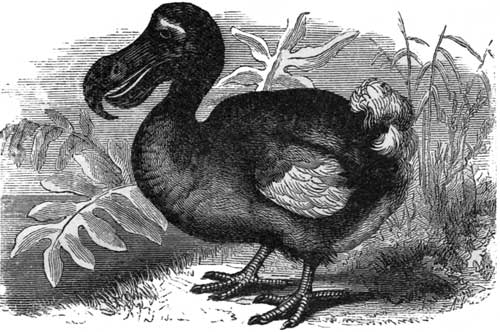 The Dodo.
The Dodo.
10. When the Mauritius Island was discovered by the Portuguese, in 1505, among the native birds was one with an enormous hooked bill and curious structure called the dodo. In shape it was somewhat like a duck, but its wings were too short for flying; it had only the rudiments of a tail, and its toes showed that it belonged to the scratchers. It was a fat, stupid bird, and could only waddle along at a slow gait upon its short legs. It had survived on the lonely island because it had no enemies.
11. Its flesh was good for food, and when the island became colonized this bird fell an easy prey to the inhabitants. Its eggs and young were also destroyed in great numbers by dogs, cats, and[Pg 20] rats. In the course of a hundred years it had entirely disappeared, and the dodo is now reckoned as among the birds of the past. From specimens preserved, and from the descriptions left by the early settlers, the dodo is regarded as belonging to the family of the pigeons, and as a connecting link between the birds of the present and those of past geologic ages.
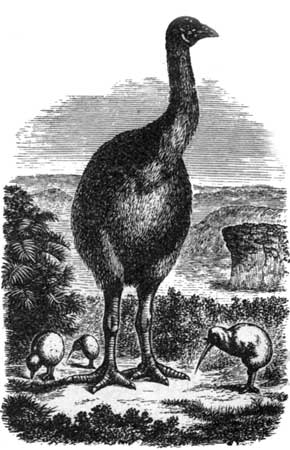 Wingless Birds of New Zealand.—The Giant Moa.
Wingless Birds of New Zealand.—The Giant Moa.
12. The natives of New Zealand have traditions of the existence of a gigantic bird that once roamed over the islands, and with which their ancestors had fierce fights. These birds were represented as much taller than men. These stories were regarded as fabulous until bird-bones of enormous size were discovered in various places. Naturalists now tell us that at no very remote period the moa or dinornis inhabited New Zealand; that it stood sixteen feet high; that it was without wings and tail; and that it had a covering which was a cross be[Pg 21]tween feathers and hair. The moa evidently belonged to the same general family as the ostrich, and it may be regarded as the big brother of the apteryx, the wingless bird which is still found on the islands. It is believed by many that the moa still exists in the unexplored regions of New Zealand, and many stories are told of their having been seen by hunters at different times.
13. Such are some of the great birds that are extinct, or are rapidly passing away. Having served the purpose of their existence, they are no longer needed. When we leave geography for geology, and the study of what is for that of what was, we find evidence that the earth was once peopled by birds even greater than the gigantic moa, and that, at one time in the earth's history, monsters which seem to be a cross between a bird and a reptile held sway over all other animal life. From these terrible creatures we have happily escaped, and bird life now, with its beauty and song, has to us become a source of perpetual delight.[Pg 22]
1. "What is that great bird, sister, tell me,
Perched high on the top of the crag?"
"'Tis the cormorant, dear little brother;
The fishermen call it the shag."
2. "But what does it there, sister, tell me,
Sitting lonely against the black sky?"
"It has settled to rest, little brother;
It hears the wild gale wailing high."
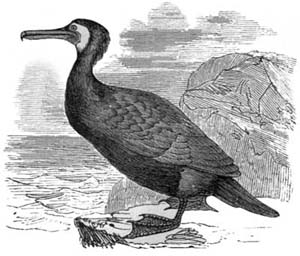 The Cormorant.
The Cormorant.
3. "But I am afraid of it, sister,
For over the sea and the land
It gazes, so black and so silent!"
[Pg 23]"Little brother, hold fast to my hand."
4. "Oh, what was that, sister? The thunder?
Did the shag bring the storm and the cloud,
The wind and the rain and the lightning?"
"Little brother, the thunder roars loud."
5. "Run fast, for the rain sweeps the ocean!
Look! over the lighthouse it streams;
And the lightning leaps red, and above us
The gulls fill the air with their screams."
6. O'er the beach, o'er the rocks running swiftly,
The little white cottage they gain;
And safely they watch from the window
The dance and the rush of the rain.
7. But the shag kept his place on the headland,
And when the brief storm had gone by,
He shook his loose plumes, and they saw him
Rise splendid and strong in the sky.
8. Clinging fast to the gown of his sister,
The little boy laughed as he flew:
"He is gone with the wind and the lightning!
And I am not frightened—are you?"
Celia Thaxter.
[Pg 24]
1. In the country, every school-boy knows the turtle, and very likely has made a pet of it. It is so curious in its shape and ways, and so different from other animals, that every one found is taken home as a valuable prize. The captor's interest is excited in examining the shell with its curious markings, the openings upon the sides between the upper and lower plates for the head, tail, and four legs, and the valves which shut down over these openings when the limbs are pulled in. He finds the little fellow harmless, but if teased he may feel a sudden grip that is not pleasant to bear.
2. Turtles are found in great variety all over the world, and they vary in size from the little creature, which the boy carries in his pocket, to monsters weighing many hundred pounds. They are all slow of foot, and, as they can not run from danger, they draw themselves within their shells, and are safe from nearly every kind of foe. Few animals can do anything with a live turtle, and the hungry boa can manage it only by swallowing it whole, and, after digesting the softer parts, rejecting the shell.
3. In the tropical regions of South America turtles are found in incredible numbers. The fol[Pg 25]lowing account is taken from the narrative of Father Gumilla, an early Spanish missionary to the upper Orinoco. In his travels Humboldt fully corroborates the story of the good father:
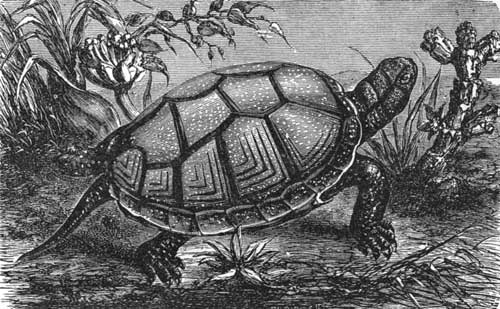 Mud-Tortoise, or Mud-Turtle.
Mud-Tortoise, or Mud-Turtle.
4. "So great is the number of turtles in the Orinoco River, that whatever I may say on this subject will fall far short of the actual truth; and I even fear that many, in reading my authentic account of what I myself have seen, experienced, and touched with my own hands, will accuse me of exaggeration; but it is a fact that it would be as difficult to count the sands of the banks of the Orinoco, as to compute the number of turtles which it harbors on its borders and in the depths of its currents.[Pg 26]
5. "Some idea may be formed of the enormous consumption of these creatures, when we say that all the tribes from adjacent countries, and even from those farther off, frequent the Orinoco with their families to secure the harvest of turtles; for they not only maintain themselves therewith during the months that it lasts, but also carry away a large supply of turtle-meat dried by the fire, and a still greater number of baskets of dried eggs. But what principally attracts these people is the oil which they gather from the eggs of the turtles, to anoint themselves twice a day throughout the year, and to sell to more remote tribes.
6. "As soon as the river begins to fall, and to display its first sand-banks, in the month of February, the turtles begin to show themselves, in order to deposit their eggs in the sand; those that appear first are the smaller turtles, called in Spanish terecayas, weighing about twenty-five pounds each; these lay twenty-four eggs, like hen's eggs, but without the shell, instead of which they are covered with two membranes, one tender and the other tough.
7. "Soon other turtles also appear, who in the previous year found no sand in which to deposit their eggs, or were prevented from so doing by the great number assembled there. These large turtles, weighing fifty pounds each, deposit sixty-two or sixty-four round eggs, larger than those of the terecayas, with stronger membrane, and with[Pg 27] which the Indians play ball on shore, or egg each other in sport. In each nest there is one larger than the rest, from which the male is hatched; all the others are females.
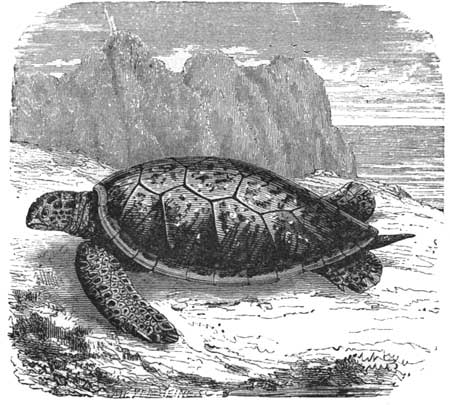 Green Turtle.
Green Turtle.
8. "About this time the Indians begin to arrive. Some of them build straw huts; others content themselves by driving poles in the sand from which to swing hammocks. A multitude of tigers also appear, to feed upon turtles, which they devour in spite of their strong shell; a circumstance which by no means adds to the pleasure of the Indians, who have no other mode of keeping them off than by fires at night; but, in spite of[Pg 28] all precautions, some Indians are devoured every year.
9. "Fearing the heat of the sun, which often kills them on the sand-banks, the turtles at first come out only at nightfall to lay their eggs; but, as the season advances, the gathering is so great, that the multitudes already out prevent the passage of still greater numbers, which, with their heads above water, are waiting a chance to pass on; and, so soon as an opportunity presents itself, they hasten to lay all their eggs at once—the burden of which they can not support without great inconvenience—regardless of the heat of the sun, which often costs many of them their lives.
10. "I have noticed three curious facts with reference to these turtle-visits. The first is that, after laying their eggs in holes which they dig for the purpose, they carefully cover them again, leaving the sand level as before. To prevent their tracks leading to the discovery, they tramp all around the nests, so that a large track looks all alike. But these precautions are vain, however, as against man, for the sand remains quite loose, and gives way under the foot, and by this means the eggs are found in the early part of the season; but in the height of the harvest there is no need of looking for signs, for in the same sand scores of turtles lay their eggs successively, and in such prodigious quantities that wherever the Indians may dig they find them in heaps, the animals them[Pg 29]selves scattering them all over the ground while digging their own nests.
11. "The second fact which I have observed is that so great is the heat of the sun that the young turtles come out in about three days' time, and are then about the size of a half-dollar. The third point is that the young turtles, on coming out of their shells, do not leave their nests by daylight, instinct having taught them that the heat of the sun will kill them. They come forth, therefore, in the silence and cool of the night; and what excited my admiration is that, although the nest may be half a mile or more from the river, they never mistake the road, but go in a direct line to the water. I have often carried them to a great distance, and turned them about, but whenever they were free they made straight for the water.
12. "About this time the Indians, both men and women, rise very early, and the former turn over as many turtles as they please, leaving them on their backs in such a way as to render them incapable of resuming their natural position; for, although they strive with their paddles to right themselves, their backs are so high that they can not touch the ground in order to obtain a foothold. They are then carried to the ranches and left upon their backs. Meanwhile, the women and children occupy themselves in filling and carrying baskets of eggs and little turtles to the ranches,[Pg 30] making large heaps of the former, and keeping the latter in baskets to prevent their escape to the river.
13. "The men dig holes in the sand, down to the level of the river, which are quickly filled with water, and place therein baby turtles to be eaten when wanted; each of which makes a delicious mouthful, free from bones, the very shells being soft and tasty. The number of young turtles eaten daily by these hundreds of families is incalculable. But the quantity of eggs consumed is even greater, both for food and for the extraction of oil; so great, indeed, that, notwithstanding the size of the Orinoco River, it is the opinion of those who have studied the matter that if it were not for this yearly destruction the river itself would soon be unfit for navigation, for the great numbers of turtles that would appear."
1. The Matiyure River is celebrated for the number and size of its crocodiles. As I sat sketching on the banks, I could perceive them gliding slowly under the still waters, the upper part of the head alone visible, and seeming to watch me with an evil eye. The beach being[Pg 31] strewed with their egg-shells, I concluded this to be a favorite resort with them during the breeding-season. The female lays about forty eggs in a hole which she digs in the sand, leaving to the hot sun the care of hatching them. These eggs, twice as large as those of the turkey, are considered a great delicacy by the Indians and jaguars, who frequently purloin them before they are hatched.
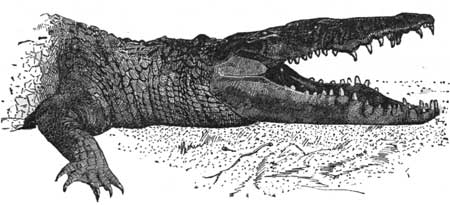 Head of Florida Crocodile, from Life.
Head of Florida Crocodile, from Life.
2. There is another enemy of young crocodiles, attacking them as they come out of the shell. After they betake themselves to the water, the older ones, prompted, no doubt, by motives of family pride to keep them within their own circle, swallow these tender members—thus preventing all other intimacies. Notwithstanding this admirable provision of Divine Wisdom, and a constant war maintained by man and beast against them, they are so numerous in some parts of the river[Pg 32] that, if stationary, their bodies would completely bridge its surface from bank to bank.
3. Despite their great voracity, the mother exhibits some degree of tenderness toward her offspring. Possessed, in this case, with an instinct almost infallible, she returns at a period when incubation is completed, and assists her young in extricating themselves from the shell. Unlike the eggs of birds, crocodiles' eggs are soft and pliable as those of the turtle, yielding, when handled, to the pressure of the fingers, yet so tough that it is difficult to break them, and in appearance resembling white parchment.
4. At the very moment of liberation, the young crocodiles display their savage nature in a wonderful degree, biting at every object within reach; also the same vicious propensity is exhibited by those extricated even before the completion of incubation.
5. I was once greatly amused in watching a struggle between two—and one of these youngsters not larger than a good-sized lizard. Each time the birds made a dash at him, this little saurian, grunting savagely, darted forward with wide-open jaws, looking for all the world like a young dragon. During ten minutes the struggle continued without decided advantage on either side, when one of the assailants, changing his tactics, suddenly seized the crocodile by the neck with his sharp claws and soared triumphantly with him[Pg 33] into high air. There loosing his hold, the bird followed his descent with wonderful rapidity, prepared, when he reached the ground, to repeat the blow; but, already half stunned, the victim soon yielded to superior cunning.
6. When the savannas are overflowed, these carnivorous and malicious reptiles spread themselves over the face of the country, committing great havoc among young animals. So destructive have they proved to the calves and foals on this estate, that the owner offered, on one occasion, a reward of half a dollar a head for every crocodile killed upon his lands, it being sufficient for the claimant to produce, in evidence of success, the two great tusks of the upper jaws. The result of this ukase was, that before the expiration of a month more than four hundred crocodiles had been destroyed, yet no sensible diminution was observable, neither did the persevering dragonade against them quench in the least their boldness.
7. This expedient proving useless, they had been suffered to remain unmolested until our arrival at Los Laureles, when we determined to exterminate those at least which infested that pass of the river where we performed our daily ablutions and watered the horses. Accordingly, one day a party of us started for a bend of the river where the water appeared to be very still and deep. None of the usual angling implements[Pg 34] were required in this sport; we used only a strong lasso and a hoop about three feet in diameter made from a light vine common on the banks of these rivers. Around this hoop the fresh lungs of a bullock, cut in thin strips, were twisted and securely fastened. The running noose of the lasso was then laid over the bait and tied there with tendrils from the same vine.
8. All being ready, this simple decoy was launched in the middle of the stream, we retaining on shore the other end of the lasso. Aroused by the splash, two large crocodiles appeared and rushed for the bait with open jaws. The successful one, in his eagerness to escape with his prize, burst the slender vines that secured the noose to the hoop, which last projected beyond his snout, and the noose on its recoil sliding over, firmly lassoed his upper jaw. With shouts of exultation we hastened to the assistance of the man who held the lasso, seeing him unable to cope with the monster, more than a match for half a dozen men.
9. By our united efforts we finally succeeded in dragging him to within a few feet of the embankment; when, catching sight of our earnest faces watching him over the cliff, he tossed up his head with such sudden violence as to pull the thong through our hands to its full length, and retreated in triumph to the middle of the stream. The tough hide, however, from which the thong[Pg 35] was twisted, proved equal to the emergency, and with one more strenuous effort we succeeded in landing him upon the beach.
10. The Indians of the Orinoco River, where the crocodiles are said to be still larger and more savage than those of its tributary streams, make use of other devices for ridding themselves of those at least that infest the places frequented by them. One of these contrivances is as novel as most of the productions of their fertile imaginations for ministering to their wants, and consists in shooting at the monster's eyes arrows tipped with a wild cane, said to be very poisonous to crocodiles—so much so that, a few minutes after, they are seen floating on the water quite dead. Another device, equally effective, consists in securing a strong rope, or lasso, to the middle of a stout stick of hard wood, which is then covered up with a large fish or piece of meat, and thrown in the water; not many minutes elapse before the crocodile seizes and swallows the bait, stake and all, when it is quickly hauled on shore by means of the lasso in the hands of the Indians.
11. By way of sport, these people avail themselves of the same artifice to capture a crocodile on shore, when sunning itself; but this time without bait, as the man alone is sufficient allurement to rouse the monster's appetite, especially if it is a man-eater; the only improvement made on the stake being that of sharpening it at both ends.[Pg 36] The Indian now seizes the stick by the middle and fearlessly approaches the crocodile, which at once makes a dash at its antagonist, with its jaws wide open; but the native easily evades the onset by stepping aside a little, as the reptile, on account of the configuration of its spine, can not turn round upon him, except after describing a long circle; a second and a third onset are equally unsuccessful, as the sportsman purposely avoids the collision by moving off when the animal comes up close to him. Having by this time proved his dexterity, the Indian gives it the final blow by plunging the stick in a vertical position into the ghastly jaws of the fierce monster, which, feeling confident of crushing its enemy this time between its powerful tusks, shuts them with a crash, which only assists in forcing both ends of the stake into the upper and lower jaws; thus transfixed, the once terror of the river becomes the sport of the Indian boys, who eagerly seize upon the thong, and ignominiously drag the reptile powerless over the sand.
1. In country places, children, when rambling through the fields and woods, sometimes find a little creature crawling out of some secret place,[Pg 37] which at first excites their curiosity, and fills them with a vague fear. It is neither a snake, nor a frog, nor a fish, yet it has features which recall all three. It has a long, round body like the snake, four legs placed upon its sides like a frog, and is covered with scales like a fish. It is about six inches long, and travels over the ground at a smart pace. This is a timid, harmless little lizard, and it is probably much more frightened than the children who have discovered him.
2. Now do not kill this queer fellow, but let us study him a little closer. We see that in shape it is like the pictures of alligators we have seen in books. Its head, with its enormous mouth, resembles that of a frog. Its legs are placed so high up on its sides that in running it partly drags its body on the ground, and its feet are armed with five long, pointed toes. Its tail is thick and tapering, and is often longer than all the rest of the body. It is covered with curious little scales, usually dark-colored above and lighter below.
3. If we watch this new friend of ours we shall see how it lives and moves. It crawls slowly along the ground, or over the prostrate trunks of old trees. Should some enemy appear, or in any way it become frightened, then it opens its huge mouth and thrusts out its red, forked tongue after the manner of serpents. In no way can it hurt anybody, but it succeeds in scaring most animals and men before they learn that the show of the[Pg 38] tongue and the hiss which goes with it are as harmless as the "faces" which school-children make at each other. Like the frog, it catches insects for its prey. It lays eggs covered with a tough membrane, but without shell, on the ground or in hollow trees. Most lizards are nocturnal, coming out for their food only in the night.
4. These little creatures have the power of sustaining life a long time without food. In the North are several varieties, all small, but of different colors, red, green, and brown. As winter approaches the lizard crawls away to some secret and sheltered place, beneath an old log, in a hollow tree, or under a heap of leaves, and there it lies dormant and motionless until spring. In the coldest weather it is frozen stiff, but this does not put an end to its life, for in the spring it comes out and goes about its old business of catching flies.
5. The horned lizard of Mexico and the Western States is covered with spines. It runs swiftly, and is of the color of the ground, so that it can not readily be seen; but, whether covered with scales or warts, once a year the lizard crawls out of his old skin and appears in a new coat, without apparently feeling proud. While some lizards lay eggs in hollow trees, in warm regions most varieties lay eggs in the sand, where they hatch out by the heat of the sun.
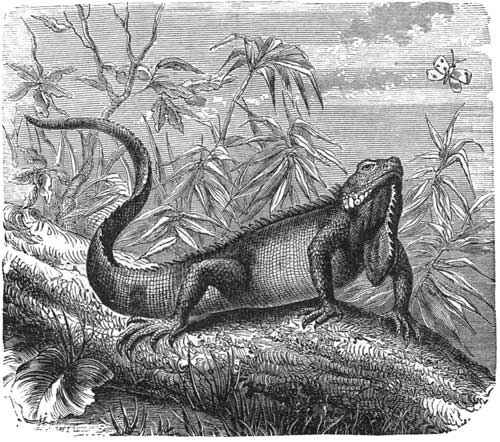 Common Iguana.
Common Iguana.
6. The iguana is a monster lizard, found in tropical America. It attains a length of five feet,[Pg 39] and can strike a powerful blow with its tail. Its tongue is long and horny on its point, for the purpose of assisting in eating the vegetables which it lives upon. Its home is among the trees, and, being an exclusive vegetarian, its flesh is good for food, and in some parts of South America it is considered a great luxury. The anolis of the Southern States belongs to the same family as the iguana, and is a vegetable-eater. It has the remarkable power of changing its color, like the[Pg 40] chameleon of Asia and Africa, another lizard which has its home on trees, but catches flies for food. All these can appear green, blue, gray, or black, according to the color of the things that surround them.
7. The gecko is a species of lizard very common in India. It has a peculiar clucking sound, like the cry which riders use to urge forward their horses, and hence its name, geck-o. The back is covered with brown scales, and on each side of its tail are rows or fleshy protuberances like fingers. This creature climbs perpendicular walls with ease, and is a very common visitant to houses in pursuit or flies. After an absence of a few days, the owner of a house returns and finds these lizards by hundreds hanging from the ceiling, digesting the game that they have just bagged. Its movements are so rapid and silent that the natives regard it as something supernatural.
8. One of the most curious of the lizards is an odd little fellow called the "flying dragon." It is a native of the East India islands, and is an insect-eater. This singular creature has wings on each side of its body, which it can spread out like the expanded fins of a fish, and which support it in its leaps from branch to branch. It has been known to leap the distance of ninety feet. When the dragon is at rest, the wings fold up close to its side, but when preparing to leap they expand like those of a bird fluttering in the air. From a high[Pg 41] point it takes its daring leap, and gently reaches the ground. The dragon, in spite of its name, is perfectly harmless, but it wages war on flies, insects, and creeping vermin. In some parts of the East it is protected by the public sentiment for the good it does.
9. The basilisk, a lizard of the Libyan Desert, was supposed to possess supernatural powers. It was the king of serpents, and before it all other animals were forced to fly. Its eye was so keen that even a man would fall dead from a single glance. While most lizards have four feet, there are species with only two; in some cases the fore-legs and in others the hind-legs are wanting. The glass-snake is a lizard with only rudimentary legs, which when struck break up in pieces. There are between seven and eight hundred species of lizards, the most of them inhabitants of tropical regions. In the rocks are found specimens of lizard-like forms sixty feet long, fit companions of the mastodon and other huge animals that formerly inhabited the earth.
10. One of the terrors of the prospector and cow-boy in Arizona is the so-called Gila[A] monster, a large, beautifully marked orange and black lizard, sometimes attaining a length of twenty inches, and having quite long legs, so that, when running, the body entirely clears the ground. The bite of this creature is said to be most venomous; and,[Pg 42] moreover, many people firmly believe that, should by any chance its breath be inhaled, a total paralysis of the body will follow.
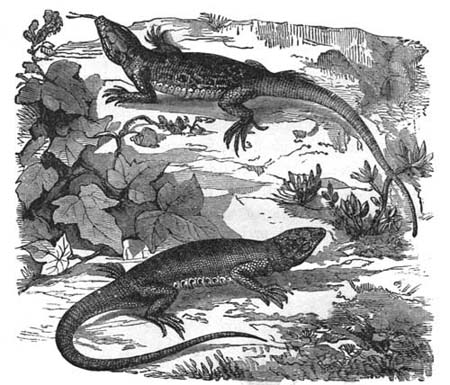 Green and Spotted Lizards.
Green and Spotted Lizards.
11. These lizards are usually met with in arid, sandy places, frequently crawling along the traveled roads and tracts. They are sluggish of movement, easily captured, and not in the least aggressive. None the less they fall a prey to the ignorant superstition which calls for the destruction of all creeping things.[Pg 43]
12. While living for a time in Tucson, Arizona's largest town, there came to us one day, by express, a package from a friend in another part of the Territory. Knowing him as a collector of all sorts of queer bugs and beasts, we were not surprised, on opening the box, to discover the odd-looking saurian curled snugly away in one corner. On first sight we were inclined to give the stranger a rather cold reception, his looks were so uncanny; and then, when alarmed, he darted out a long, forked tongue in a truly menacing manner. As Mr. T——, however, had vouched for his good behavior, we opened our hearts and adopted him as one of our pets. At first he was given the freedoma of one room, about which he crawled rather timidly, at last taking refuge behind a huge Indian water-jar or olla, which stood by the fireplace.
13. This corner he made his retreat, and here he spent his hours of retirement. We finally discovered that during these periods he, like many other prisoners, attempted to tunnel his way out, and indeed succeeded in making a large excavation in the soft adobe wall, by means of his fore-feet. Our two dogs, in the beginning, eyed Monster with aversion, and sniffed at him suspiciously. If they came too near, he would hiss fiercely, shooting out his wicked-looking tongue, when they would wisely retreat.
14. We were at a loss to know what food our[Pg 44] lizard required, until our kind Mr. T—— suggested an egg-diet, and this proved most acceptable. The egg was first broken into a saucer and placed before Monster, who, having been induced to take one taste, eagerly continued to lap, in cat-fashion, until the dish was emptied. At intervals water was taken, but never in large quantities.
15. In time our pet had the run of the house, and went about where he wished; occasionally taking a turn out in the corral, where among the grass-roots he found food to his liking. At night we frequently heard him prowling about. He became entirely accustomed to the various members of the family, and would permit us to scratch his back, evidently greatly enjoying the sport.
16. One morning, while he lay basking in the sunshine in our alameda, or inclosed veranda, in an ill-advised moment an inmate of the house was impelled to tickle his nose. The poor creature was rudely awakened, and, in his fright, seized the offending finger. As a result a deep wound was inflicted by the sharp teeth. An hour or more passed before the fact was mentioned, and then it came about incidentally, for the inquiry about the bandaged hand being evaded, "my lady" said jokingly, "I believe the Gila monster has bitten you." The late discovery that this was the case caused some alarm; strong ammonia was applied, but no serious results followed, nor was the finger so sore as is usual with a cut.[Pg 45]
17. Soon after, our pet was missing; he had been tempted to stray through the open gate, and to wander into a neighboring corral. Our search revealed his untimely fate, for a hard-hearted baker discovered him, and, following the fashion of the country, had ruthlessly killed our harmless little friend.
1. In the solitudes of Madagascar, where the forests are immense, and where animals can multiply without fear of man, the fauna possesses some singular features. The traveler can pass along without fear of the lions, leopards, and panthers of Africa and Asia; neither do zebras and quaggas gallop over the plains. In other countries, wherever the climate is hot enough, monkeys enliven the woods; here not a species is to be found.
2. It is true that there are large herds of cattle, which constitute the principal riches of the natives, but these have been imported from Asia. This species is remarkable from the lump of fat on its back, and is strikingly beautiful when seen in large herds wandering over the plains. The sheep, too, are peculiar, from their enormous tails, which consist of a mass of fat—a common feature in those belonging to the African Continent. Goats[Pg 46] abound, as well as wild pigs, which ravage the plantations; but these are all supposed to have escaped from vessels, and not to be indigenous to the island.
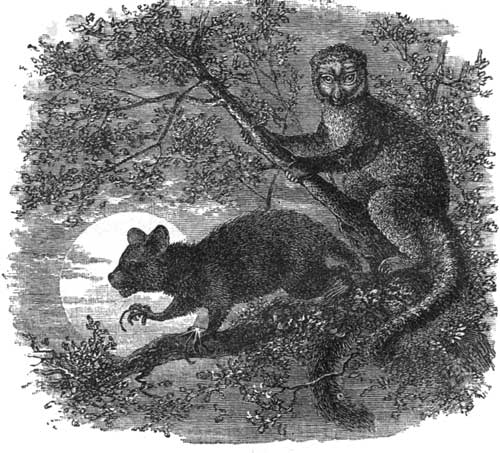 The Aye-Aye and a Lemur in the forests of Madagascar.
The Aye-Aye and a Lemur in the forests of Madagascar.
3. The monkeys of other lands are, however, replaced by the lemurs—graceful little creatures of many varieties. There is a great resemblance in their attitude and manner of life to the ape, so that they have been styled monkeys with the fox's head. Their agility is marvelous; they leap through the air to a great distance, settling on a branch, which perhaps bends under their weight,[Pg 47] and dart off again in evolutions of astonishing rapidity. The largest kind are about three feet long; the smallest are not larger than a rat.
4. In the most solitary parts of the southwest region lives that strange creature, the aye-aye. A nocturnal animal, gentle and timid, it is about the size of a cat, with a large head, round full eyes much like those of an owl, an enormous tail, and most curious formation of the fore-paws, the middle finger being long and slender. This, which looks like a deformity, is, in truth a wonderful arrangement of Nature for its special way of life. As it lives on the larvæ hidden in the trunks of trees, the finger can be easily introduced into the fissures from which it tears the coveted prey. Naturalists think it forms a link between the squirrel and monkey. The natives seem to have a superstitious dread of the animal, owing to its sleeping all the day in the most secret haunts; nor do they ever molest it, astonished as they seem to be by its peculiar form and movements.
5. There is another class of mammals peculiar to this island, called by the natives tendraks. They seem to be closely allied to the hedgehog, and are covered with spines. But the teeth differ and the tail is wanting; neither do they roll themselves into a ball, but, when frightened, hide the head between the paws. Seven or eight species have been discovered, in some of which the spines are soft and cover only a part of the body. They[Pg 48] are all nocturnal in their habits, and their flesh is very good to eat. The flesh-eating animals are all small. The wild cat is a pretty creature. Its back is fawn-colored, with four stripes of reddish brown, and yellowish white under the body and paws. The ichneumon, with its long, thin body and shaded skin, is only half the size of its cousin of Egypt. It is a fearful enemy of all small animals, as rats, mice, and snakes, and one species feeds greedily on honey. The only plantigrade is of the size and appearance of a cat, but with feet formed like those of a bear.
6. It is very different in regard to birds; they can fly far, and so the tern, the petrel, the albatross, and many other well-known birds, abound on the island. One large species of duck, with bronze and violet reflections like metals, its white head and neck spotted with black, is a great favorite with the natives. In the marshes stalks the proud sultana-hen, with its magnificent blue body, a red patch on its head, and coral feet adorned with a tuft of white feathers. The jacana, a bird of the water-hen family, is also peculiar to this place; mounted on legs like stilts, and extremely long feet, it runs through the tall grass, or upon the floating water-leaves, with great rapidity. Its food is the leaves and roots of water-plants, and such insects and frogs as it can readily swallow.
7. The sacred ibis of Egypt is found in large flocks. The crested ibis is peculiar to the coun[Pg 49]try—a beautiful bird, bright-eyed, with yellow beak and claws, and a green head from which the long plume of white and green feathers lies back. The beautiful cardinal, in its bright scarlet robe, black spotted on the back, haunts the open glades of the forest; and on the banks of streams are numerous linnets, wagtails, and humming-birds.
8. As for the reptile class, it is pleasant for the traveler to walk through the forests, knowing that the poisonous species are unknown. Beautiful lizards, covered with brilliant scales of olive or fawn, hide themselves under the stones or in old trees. But the chameleon is the most common of all the lizards; in the heart of the forests it may be seen crouched on the branches, calm and immovable, but rolling its large eyes in all directions to look out for insects. The crocodile is the only creature to be feared, and the natives have learned to shun the water which it inhabits.
9. There was a time when much more remarkable animals lived upon Madagascar. In the marshes near one of the principal rivers, the bones have been found of the hippopotamus, and immense tortoises; and near by have been discovered the feet and eggs of gigantic birds. These remains were so fresh that it was thought that living specimens of the bird might still be found in the interior; but this hope is now abandoned, though it is evident that they existed in large numbers at a very recent period. They probably[Pg 50] disappeared before their cousin the dodo of Mauritius. Their eggs are six times as large as those of the ostrich.
1. Listen! What a sudden rustle
Fills the air!
All the birds are in a bustle
Everywhere.
Such a ceaseless croon and twitter
Overhead!
Such a flash of wings that glitter
Wide outspread!
2. Far away I hear a drumming,
Tap, tap, tap!
Can the woodpecker be coming
After sap?
Butterflies are hovering over,
Swarms on swarms,
Yonder meadow-patch of clover
Like snow-storms.
3. Through the vibrant air a-tingle
Buzzingly,
Throbs and o'er me darts a single
[Pg 51]Bumble-bee.
Lissom swayings make the willows
One bright sheen,
Which the breeze puffs out in billows
Foaming green.
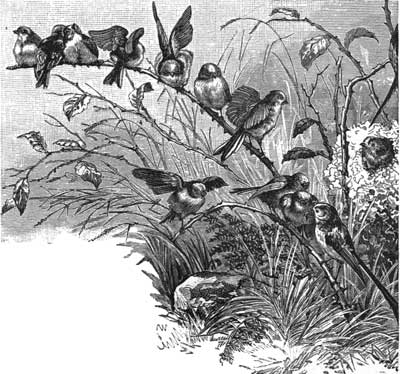 Birds in Spring.
Birds in Spring.
4. From the marshy brook that's smoking
In the fog,
I can catch the crool and croaking
Of a frog.
Dogwood stars the slopes are studding,
[Pg 52]And I see
Blooms upon the purple-budding
Judas-tree.
5. Aspen-tassels thick are dropping
All about,
And the alder-leaves are cropping
Broader out;
Mouse-ear tufts the hawthorn sprinkle,
Edged with rose;
The park-bed of periwinkle
Fresher grows.
6. Up and down the midges dancing
On the grass:
How their gauzy wings are glancing
As they pass!
What does all this haste and hurry
Mean, I pray—
All this out-door flush and flurry
Seen to-day?
This presaging stir and humming,
Thrill and call?
Mean? It means that spring is coming;
That is all!
Margaret J. Preston.
[Pg 53]
1. Eels are among the mysteries of this world. In spite of the way in which Dame Science has persistently poked her nose into most things, and has harried them and laid them bare, she has succeeded in finding out but little about eels and their mode of life. However, it would be rash to go as far in our confession of ignorance as a contemporary recently did, and declare that "we know next to nothing of eels beyond the periods of their migration." If we knew nothing more than that, we should indeed know but little, as in many places eels never migrate at all, but grow fat and flourish from year to year in the pond or lake where they were born, without ever leaving it to seek the brackish water of estuaries which some authorities deem necessary to their existence.
2. The same writer who made the above remark asserts that the distinction between "shovel-nosed" and "pointed-nosed" eels is purely "fanciful," and accounts for the difference by saying that "most fish develop a shovel-nose when they are working up-stream." If this were the case, an eel would have a shovel-nose in the spring and a sharp nose in the autumn! Such a capability of altering his features would be certainly open to envy; but, unfortunately for this theory, the structure of the[Pg 54] two fish is materially different, and the single fact that the shovel or broad-nosed eel has one hundred and fifteen vertebræ, while his sharp-nosed relative only possesses one hundred and thirteen, is sufficient to prove the fallacy of the idea that the two fish are identical.
3. Of fresh-water eels, as apart from their mighty cousin the conger, there are three distinct kinds—the sharp-nosed eel, the broad-nosed or frog-mouthed eel, and the snig. Of these three, the sharp-nosed eel is both the largest fish and the best eating, though some prefer the snig eel as having a superior flavor. The snig, however, in spite of its excellence, has not the same value as the sharp-nosed eel; for it seldom, if ever, attains more than half a pound in weight. The sharp-nosed eel, on the contrary, attains an enormous size. One on record that was taken weighed thirty-four pounds, measured six feet in length, and had a girth of twenty-five inches. Another eel weighed forty pounds and measured five feet nine inches. But these instances, though not to be regarded as apocryphal, are still very exceptional; and a very fair average weight for sharp-nosed eels is six pounds. Eels of even ten pounds weight are not common, and Mr. Frank Buckland speaks of one of that size as being the largest he had ever seen.
4. From time immemorial eels have always been much esteemed by epicures, more perhaps in ancient days than they are now. By the Egyp[Pg 55]tians eels were regarded with great abhorrence, as the embodiment of an evil demon; but other nations did not share the prejudice, for the Bœotians, who were celebrated for their eels, used them as sacred offerings. Misson, in his "Travels," tells of a vow made by the inhabitants of Terracina, a seaport of Italy, when besieged by the Turks. They vowed to offer twenty thousand eels a year to St. Benedict if he would deliver them from their peril. Whether a fond memory of stewed eels touched the saint we do not know, but the siege was raised, and the Benedictine monks got their eels every year from the virtuous and grateful inhabitants.
5. The Venerable Bede mentions the eel-fisheries of Britain in his "History of the Anglo-Saxon Church," and an instance is quoted of the magnificence of the famous Archbishop Thomas à Becket that, when he traveled in France, "he expended the large sum of a hundred shillings in a dish of eels." Anyone who could now sit down to cope with a dish of eels of the value of five pounds would indeed have gastronomic capabilities likely to make an alderman die of envy. But, in the eating of eels, excellent as they are, it is well to remember the advice given in the ancient medical book:
"Who knows not physic should be nice and choice
In eating eels, because they hurt the voice.
Both eels and cheese, without good store of wine
Well drunk with them, offend at any time."
[Pg 56]
6. For a long time the most extraordinary theories were accepted regarding the birth of young eels. Aristotle believed they sprang from the mud, wherein he was not far wrong, as eels deposit their spawn in mud and sand; Pliny maintained that young eels developed from fragments separated from the parents' bodies by rubbing against rocks; others supposed that they proceeded from the carcasses of animals; Helmont declared that they came from May-dew, and gave the following receipt for obtaining them: "Cut up two turfs covered with May-dew, and lay one upon the other, the grassy side inward, and then expose them to the heat of the sun; in a few hours there will spring from them an infinite quantity of eels." Of that ancient superstition of one's childhood that horse-hairs cut up and deposited in water would turn into eels it is hardly necessary to speak, for who can not remember those unpleasant little bottles, erst used for medicine, which garnished one's nursery, in which the propagation of eels from horse-hair was carried on with the profound faith of childhood?
7. Eels generally shed their spawn in April, and, when not hindered, they almost invariably choose an estuary, where they scatter the spawn loosely in the sand or soil. But that an annual visit to the sea is by no means necessary to their existence is proved by the fact that many eels that inhabit inland ponds and lakes never visit the sea[Pg 57] at all. A gentleman digging in the month of October in the gravel-banks of the river Stour found the place "alive with young eels, some of them scarcely hatched, at the depth of from five to fifteen inches"; and at one of the meetings of the British Association for the Advancement of Science a member stated that he had seen a considerable number of young eels rise up through a small opening in the sand at the bottom of a small stream, the Ravensbourne. The greater number of eels, however, do visit the sea, and the "passing up" a river of the young eels is one of the most curious sights of natural history.
8. This passage of young eels is called eelfare on the banks of the Thames; and it has been thought by some that the term elver, which on the banks of the Severn is used indiscriminately for all young eels, is a corruption of the word eelfare. In the Thames this eelfare takes place in the spring, in other rivers in the summer; and some idea of the numbers of these young eels, each about three inches long, may be gathered from the record of Dr. William Roots, who lived at Kingston in 1832. He calculated that from sixteen to eighteen hundred passed a given point in the space of one minute of time. These baby-eels travel only by day and rest by night. In large and deep rivers, where they probably find the current strong, they form themselves into a closely compacted company, "a narrow but long-extended column," as it has been[Pg 58] described; but in less formidable streams they abandon this arrangement and travel, each one more or less at his own sweet will, near the bank.
9. The perseverance of these little creatures in overcoming the obstructions they may encounter is quite extraordinary. The large flood-gates, sometimes twenty feet high, that are to be met with on the Thames, would be sufficient, one would imagine, to bar the progress of a fish the size of a darning-needle. But young eels have a wholesome idea that nothing can stop them, consequently nothing does. As one writer says, speaking of the way in which they ascend flood-gates and such like barriers: "Those which die stick to the posts; others, which get a little higher, meet with the same fate, until at last a sufficient layer of them is formed to enable the rest to overcome the difficulty of the passage." The mortality resulting from such "forlorn hopes" greatly helps to account for the difference of number between the upward migration of young eels and the return of comparatively few down-stream in the autumn.
10. One of the greatest peculiarities possessed by eels is that they have a second heart situated in the extremity of their tails; of course, in the transparent elvers the action of this heart can be more easily noted than in the ordinary eels. In all, however, its action is plainly manifest; especially if the fish has been out of water any time or exhausted, a fact known to the street venders[Pg 59] of live eels, who therefore are careful to cover their eels with sand to hide the caudal pulsations. Dr. Marshall Hall, who in 1831 discovered this secondary heart of the eel, says of it that "the action of this caudal heart is entirely independent of the pulmonic heart; while the latter beats sixty the former beats one hundred and sixty times in a minute. It continues a very long time after the influence of the pulmonic heart is entirely removed." It is probably owing to this caudal heart that the eel's tail is so highly sensitive and so strong. Eels can almost use their tails like hands; as, for instance, if confined to a tank or bucket, they will grasp the edge with this handlike tail, and by its help lift themselves bodily over. Eels are very clean feeders; if possible, they like their food alive, and in all cases it is most essential that it should be fresh. Even the slightest taint is too much for their keen sense of smell and taste. They are sometimes seen cropping the leaves of water-cresses, and other aquatic plants, as they float about in the water; but as a rule their food is altogether animal.
11. There are a good many ways of catching eels; the commonest, of course, being by the eel-bucks which are so often to be met with on the Thames. Eel-bucks that are intended to catch the sharp-nosed or frog-mouthed eels are set against the stream, and are set at night, as those two descriptions of eels feed and run only at night. The[Pg 60] snig eel, which is chiefly found in Hampshire, feeds by day; and fishermen have found by experience that snigs are only taken in the eel-bucks if they are set with the stream, instead of against it. In Norfolk, where immense quantities of eels are caught every year, the capture is mostly effected by eel-sets, which are nets set across the stream, and in which the sharp-nosed eel is the one almost invariably taken. Besides these eel-sets, however, the Norfolk Broadmen also fish for eels with "babs," which can hardly be called sport in any sense of the term. The "bab," or "clod," as it is sometimes called, is a number of lob-worms threaded on pieces of worsted, and all tied up in a bunch not unlike a small mop. The bab is then tied on to the end of a cord attached to a stout pole. The eel's teeth get entangled in the worsted as soon as he attempts to take the bab, and he can then be lifted out of the water either into the boat, if the angler be in one, or else allowed to drop off the line into a pail, which the angler should place on the bank at a convenient distance from his standing-place. Norfolk "babbers" frequently catch four stone weight of eels to a boat per night, especially in the spawning-grounds.
Night-lines are also much used for catching eels. These are long lines, weighted heavily at each end and in the middle, and garnished with baited hooks one yard apart. "Sniggling," immortalized by Mr. Burnand in his "Happy Thoughts,"[Pg 61] is one of the most favorite ways of catching eels; and "stichering," a Hampshire method, is perhaps one of the most amusing, though the sticherer probably catches fewer eels than any other eel-hunter. The only apparatus used is an old sickle, worn short and chipped so as to present something of a saw-like edge; this is tied firmly on to a light pole about twelve feet long. Armed with these the sticherers betake themselves to the water-meadows. In the wide, deep drains used for irrigation eels abound, and the object of the sticherer is to thrust the sickle under the eel's body, and, with a sudden hoist, to land him on the bank, from which he is transferred to the bag. That there is every chance, when on a stichering party, of having your eye poked out, or your ear sawn off, of course only adds the necessary amount of danger and pleasurable excitement, without which all sport is tame.
12. Of all forms of eel-capture, there is none to compare to spearing, of which there are two methods. The Norfolkmen mostly use "picks" formed of four broad blades, spread out like a fan, between which the eels get wedged. These are mounted on long, slender poles, to enable them to be thrust into the mud, where the "picker" notices the tell-tale bubbles rise which denote the presence of "Anguilla." Eel-spearing of this kind takes place chiefly in winter, but there is another form of this sport called "sun-spearing," which is[Pg 62] much sought after in the Irish loughs during the months of June and July. In the early sunny mornings at that time of the year, when the water seems to be principally composed of sunbeams, with a little hydrogen and oxygen added, the sun-spearer sallies forth in any little boat he can lay his hands on. Standing up in the bows, and, if alone, using his spear to propel the boat gently along, he steals over the crystal waters of the lough. Presently he sees the gleam of the "silver" eel as he lies quietly at length on the sandy bottom. The spearer takes aim; there is a sudden "splitting of the atmosphere," as Mark Twain would say, a splash, and either Anguilla comes up writhing on the twelve close-set teeth of the sun-spear, or the spearer has taken a header into ten feet of water. If the latter is a tyro at the apparently simple art of sun-spearing, it may safely be predicted that, if he makes acquaintance with the eel he is after, the meeting will be more likely to take place under water than above it.
1. Frank Buckland lived in London. He was the son of Dr. William I. Buckland, the great geologist of Edinburgh. He was a naturalist, and[Pg 63] took great interest in everything that had life. He studied animals, and soon every living creature in his care came to regard him as a friend. His house was a perfect curiosity-shop; the rooms filled with living animals, loose or in cages, and with dead ones stuffed, and laid up on shelves.
2. Mr. Buckland, for a long time, was editor of the natural-history department of "Land and Water," and his contributions of the results of personal observation are always valuable and interesting. A few years before his death, one of his fellow-editors called at his home, and gives this very graphic sketch of what he saw and heard:
3. As we entered the hall, we saw, through an open door, a full-grown jaguar loose in the room, which caused us to come to an abrupt halt. "It's a jolly little brute and won't hurt," exclaimed Mr. Buckland, as we were about to retreat from his threshold. The monkeys had seized the jaguar's tail, and, lifting it with its hind-legs bodily to the altitude of their cage, were rapidly denuding it of fur. No animal, with any feeling of self-respect, could submit silently to such humiliation, and the jaguar was making the place hideous with his yells. Hearing the cries of her pet, Mrs. Buckland came to the rescue; and it was amusing to see this child of the forest, with gleaming eyes and frantic yelps, cast itself at her feet and nestle meekly in the folds of her dress.
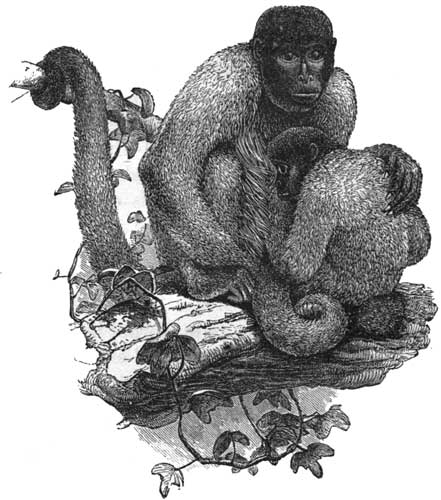 Woolly Monkey and Child.
Woolly Monkey and Child.
4. She had nursed it through a very trying[Pg 64] babyhood, when Mr. Bartlett had sent it from the Zoo, apparently dying and paralyzed in the forelegs, with a promise of fifteen pounds reward for a cure. That sum has long since been swallowed up in damages for clothes destroyed and boots devoured, as the invalid's health and appetite returned. Hard by a laughing jackass was sportively chasing live mice up and down a glass jar, as an appetizer be[Pg 65]fore eating them; and below, solemnly weighing the doctrine of chances, a battalion of cats waited patiently what might befall.
5. At a front window an intelligent parrot kept calling cabs from the moment we entered, and was equally ready to hail an omnibus if we preferred it. A peaceably disposed piebald rat was enjoying gymnastic exercises on a pole, until seized by his master and told to "sing up, old boy." Held suddenly to our ear, melodious notes were heard issuing from the diaphragm, which Mr. Buckland considers as good as the carol of a lark, whether it arises from a parasite in the liver or not.
6. All around the walls were covered with the heads of curious hybrids and horns of extinct animals; and, indeed, there was everything in this wonderful museum to fascinate the mind, from a shoe, left as a keepsake by Brice the giant, to a "lady's slipper," floating about in a wineglass of water. The latter was a beautiful little object, like a fairy glass slipper, about an inch long, without heels, and exquisitely fringed and finished off. It belongs to the jelly-fish tribe, and was alive and well when we saw it.
7. The "happy family" life, of which Mrs. Buckland is the center, is carried on in an ordinary London house. The dining-room is the one room preserved, but with difficulty, for the sole use of man. It is held, so to speak, at the sword's point against the incursions of animals from the neigh[Pg 66]boring jungle. Sometimes the rule is relaxed in cases of sickness, or on the arrival of a welcome little stranger like the jaguar. It is to this room that all good animals expect to go—in a stuffed form—when they die. It is regarded as a poet's corner for the great; while the bodies of the less distinguished are consigned to honorable burial in the back green. Mr. Buckland was informed lately that there was no room to bury so much as a bird there now.
8. Some excellent pictures adorn the walls of this room; one of Master Frank, himself, "aged three, born at Christchurch, Oxford, December 17, 1826." He is characteristically portrayed hugging a rabbit in his pinafore. Below all this we come upon the practical workings of the scientific mind. Next to the kitchen and accessible to the area is the casting-room, to which everything extraordinary, whether from the depths of the sea or the bowels of the earth, sooner or later gravitates. It is here that a prodigious amount of work is done, and goes forth in a finished state to adorn the South Kensington and other great museums for the advancement of science and education of the people. Round the walls are ranged bottles, casks, and jars, containing specimens in every stage of what the naturalist might call preservation and the ignorant decay.
9. Enjoying the rare art of imparting his knowledge to others, Mr. Buckland delights in showing[Pg 67] his treasures. Regardless of fearful odors, he will plunge up to his elbows into a deep, dark tank, draw forth a slimy, dripping reptile, and ask, cheerfully, "Is he not a beauty?" It requires a strong stomach and no small diplomacy to know how to act, for he is ready on a word of encouragement to make another fatal plunge and bring up the other seven. But another joy awaits you—if you can bear it—in a jar, when he carefully hauls out a ribbon-fish, and tells you it is the next of kin to the great sea-serpent.
10. At that moment you heartily wish the great sea-serpent would bury its own relations; but Frank does not, and anyone who would bring him the head of the family would be his friend for life. On the whole, Mr. Buckland prefers live snakes about him, but he has not yet succeeded in getting his household to agree with him. A live snake is considerably worse than a pickled snake, seeing that the latter, they find, is not so likely to be found under their pillows.
11. Perhaps the worst moments for the family are those when the parcels-delivery van drives up to the door. On these occasions there is a general closing of windows observable in the neighborhood, and the only light-hearted creature within the zoölogical circle of Frank Buckland's home just then is the persevering parrot, who takes the credit of the van's arrival to himself. The naturalist steals out to survey the state of things, and,[Pg 68] if likely to be very odorous, feels uneasy; while the husband, deep and treacherous, drops a propitiatory sovereign into his wife's hand, and recommends her to try a little shopping in some distant region. Once it was a gorilla in a cask; and when his unfortunate wife returned to her home, she found Frank in high spirits and the gorilla in even higher.
12. Mr. Buckland's chief domestic grievance is the duster, which he regards as a mischievous invention of women. Household operations have consequently to be conducted by stealth, and usually in his absence on official rounds as Government Inspector of Fisheries. Not long ago he returned home to find the giant's autograph white-washed off the dining-room ceiling, and was in despair; but discovering the row of postage-stamps a foot or two above the door marking the giant's height, he was in a measure consoled, and fell back for comfort on the shoe still safe in the museum. Mr. Buckland makes the scullery his chief workshop, and shares the kitchen, when she will let him, with the cook.[Pg 69]
1. Yes, Tom's the best fellow that ever you knew.
Just listen to this:
When the old mill took fire, and the flooring fell through,
And I with it, helpless there, full in my view
What do you think my eyes saw through the fire
That crept along, crept along, nigher and nigher,
But Robin, my baby-boy, laughing to see
The shining? He must have come there after me,
Toddled alone from the cottage without
Any one's missing him.
2. Then, what a shout!—
Oh, how I shouted, "For Heaven's sake, men,
Save little Robin!" Again and again
They tried, but the fire held them back like a wall.
I could hear them go at it, and at it, and call,
"Never mind, baby, sit still like a man!
We're coming to get you as fast as we can."
They could not see him, but I could. He sat
Still on a beam, his little straw hat
Carefully placed by his side; and his eyes
Stared at the flame with a baby's surprise,
[Pg 70]Calm and unconscious, as nearer it crept.
The roar of the fire up above must have kept
The sound of his mother's voice shrieking his name
From reaching the child. But I heard it. It came
Again and again.
3. O God, what a cry!
The axes went faster; I saw the sparks fly
Where the men worked like tigers, nor minded the heat
That scorched them; when, suddenly, there at their feet
The great beams leaned in—they saw him—then crash,
Down came the wall! The men made a dash,
Jumped to get out of the way—and I thought,
"All's up with poor little Robin!" and brought
Slowly the arm that was least hurt to hide
The sight of the child there; when swift, at my side,
Some one rushed by, and went right through the flame,
Straight as a dart—caught the child, and then came
Back with him, choking and crying, but—saved!
Saved safe and sound!
4. Oh, how the men raved,
[Pg 71]Shouted and cried and hurrahed! Then they all
Rushed at the work again, lest the back wall,
Where I was lying away from the fire,
Should fall in and bury me.
5. Oh! you'd admire
To see Robin now; he's as bright as a dime,
Deep in some mischief, too, most of the time.
Tom, it was, saved him. Now isn't it true,
Tom's the best fellow that ever you knew?
There's Robin now! See, he's strong as a log!
And there comes Tom, too—
Yes, Tom was our dog.
Constance Fenimore Woolson.
1. A few years ago, the public were amused with an account given in the newspapers of a dog which possessed the strange fancy of attending all the fires that occurred in London. A gentleman residing a few miles out of town was called up in the middle of the night by the intelligence that the premises adjoining his house of business were on fire. "The removal of my books and papers," said he, "of course claimed my attention, yet, notwithstanding this, and the bustle which prevailed, my eye every now and then rested on a dog which,[Pg 72] during the hottest progress of the fire, I could not help noticing running about, and apparently taking a deep interest in what was going on, contriving to keep himself out of everybody's way, and yet ever present in the thickest of the stir.
2. "When the fire was got under, and I had leisure to look about me, I again observed the dog, which, with the firemen, appeared to be resting from the fatigues of the day. 'Is this your dog?' I said to a fireman. 'No, sir,' answered he, 'he does not belong to any one in particular; we call him the fireman's dog. He calls none of us master, though we are all willing enough to give him a night's lodging and a pennyworth of meat. But he won't stay long with any of us; his delight is to be at all the fires in London; and far and near we find him on the road as we are going along, and sometimes, if it is out of town, we give him a lift. I don't think there has been a fire for two or three years past which he has not been at.'"
3. For many years "Tyke" continued to live with the firemen and attend fires. He would stay in one place but a day or two. Day or night, it was all the same to him; if a fire broke out, there he was in the midst of the firemen; and, though pressed upon by crowds, yet he always escaped accidents, only now and then getting a ducking from the engines, which he rather liked. He lived to a good old age, and kept up his interest in fires to the very last.[Pg 73]
1. From the birds that fly to the snakes that crawl seems a long distance down the scale of being; but the way is a natural one, for birds and reptiles show at least a distant relationship. Though obscure and quiet, snakes have created a great stir in the world. Nearly all people have a dread of them; and the first impulse awakened by the sight of one of these animals is to fly from or kill it. If the little garter-snake, that can not do as much harm as a mosquito, has half the wit it is supposed to have, it must greatly enjoy the commotion it creates when creatures a hundred times as large as itself run from it as from the evil-one.
2. Snakes have not always been simply hated or feared; in the earliest times they were worshiped, and the serpent was an emblem of wisdom. We may wonder why they should have been both despised and honored; but the reason is, perhaps, that men knew so little about them. That some snakes inflict a mortal wound they knew; but the true nature and the habits of these animals they did not know. They feared what was unknown, and they worshiped what they feared, hoping to please it, and thus turn away the harm which they were afraid it might do.[Pg 74]
3. But the ancients, even, saw something beautiful in the serpent, for they adorned their works of art with its winding, graceful folds. And we of to-day, who know so much more about this generally detested animal, should be inclined to admire its beauty, and to cast away needless fear. Snakes have their rights, and we shall not trample on these rights if we do not trample on the snakes. The most of them are as harmless as doves, while those that are deadly will do us no injury if we will let them alone.
4. The body of the snake is a curious structure, and wonderfully adapted to its life and habits. When we see with what soft and noiseless motion it creeps on the ground, gliding through narrow places, and tangled thickets, or how readily it swims in the water, we may well wonder. But if we strip off its skin and flesh, the secret of these easy motions is laid open. Here is a backbone composed of a great many parts, or vertebræ, as they are called. These parts are joined by a ball working in a socket, so that the snake can easily turn in every direction; and to each of the parts is connected a pair of ribs.
5. The snake uses its ribs for legs, and the scales on the under side of its body for feet. It can work the ribs forward and backward like legs, and with each motion of these bones the scales move and catch on the ground, pulling or pushing the whole body. The ability of the snake to[Pg 75] swallow bodies many times larger than itself is understood, if we examine its head. The jaws are loosely joined by elastic gristle, so that they can spread immensely; and a small mouth, that seems only large enough to take in a cricket, can stretch wide enough to swallow a toad. Between these jaws plays the tongue, a delicate, lively little member, forked, and darting far out beyond the lips. It is the only member by which the animal touches or feels, and it is entirely harmless, even in poisonous snakes.
6. The teeth of the snake, which incline backward, are not used for chewing, but for holding and swallowing its prey. The ears are covered with scales, and do not appear. This may be the reason why the adder is supposed to be deaf. The eyes have no eyelids, but are shielded from harm by the skin that covers them, which is transparent.
7. From time to time during the summer the snake gets a new dress. He grows stupid, eats no food, and the skin loosens about his mouth. Then he crawls through a close passage, in moss or brush, and the skin slips off like a stocking; then in his new skin he feels fresh and hungry, and crawls away to catch a toad. The blood of the snake circulates slowly, and is cold. Snakes like the hot sun, but during the winter they coil up in holes in the ground, or hollow trees, and sleep as if half dead. Their young are produced from eggs, and need little care. The eggs are left to be hatched[Pg 76] by the sun, or by the heat of decaying vegetation. In some species the eggs are hatched while in the body of their mother.
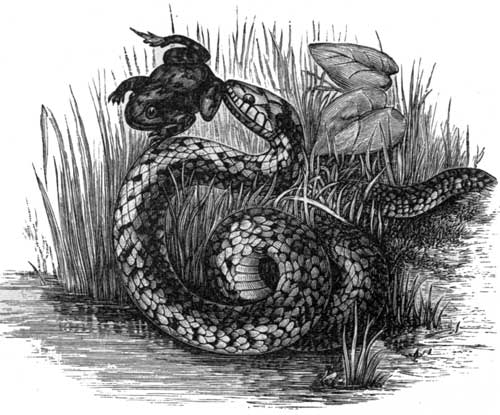 The Common Ringed Snake.
The Common Ringed Snake.
8. Most of the snakes we meet are harmless, and we have no need to molest or kill them. We may easily learn to distinguish them, and thus avoid cruelty to innocent life. The spotted adder is commonly called the milk, house, or chicken snake. It has a slender body, from two to four feet long, and its ashy skin is covered above with large, oval, chestnut-colored spots. Underneath are dark spots nearly square. The head is small, and a reddish semicircular band runs from eye to eye.[Pg 77]
9. The common striped snake is brown or olive-green, with three greenish-yellow stripes, showing spots of black, running the whole length of the body—one stripe on the back, and one on each of the sides. Below it is greenish-yellow. This is the garter-snake, or water-garter, and is stout and clumsy. It feeds on frogs, toads, and mice, and is eaten by hawks, owls, and pigs. Its disposition is peaceful, and its bite is as harmless as that of a common fly.
10. The hog-nose snake wears a gray skin, tinged with yellow, and with three rows of deep-chestnut blotches. Its head is small, of a red color, dotted with brown spots, and turns up like the snout of a pig. When irritated, the head flattens and spreads out to twice its usual width. Hence, it is called the spreading-adder. Its eyes are large, and its tail is short. Its only means of defense is the fierce look it puts on when it spreads, but it can do no other harm.
11. The water-snake is dark-brown above, and its sides are covered with chocolate bands. Its tail ends in a horny tip. It may sometimes be seen lying in a bush near the water, watching for a chub. The chain-snake, known as the blue racer, is from four to six feet long, and is reddish-brown in color, with many narrow yellowish bands over the back, which unite on the sides. It is a beautiful animal, moves swiftly, and feeds on other reptiles. The ribbon-snake is a garter, and creeps[Pg 78] and darts over the branches of bushes and trees, hunting for insects.
12. Of smaller size, there are the ring-snake, that tries to defend itself by sending forth an unpleasant odor; the pretty little green or summer snake, the red-snake, and the little brown-snake, that may be easily tamed. All of these animals, when attacked, will run out and vibrate their innocent forked tongues, and some of them will bite, but the wound is nothing more than the prick of a pin.
13. The black-snake receives much hatred and ill-treatment on account of its large size and bold action. But he is amiable. Occasionally he takes a chicken, or a nest of eggs, that do not belong to him, or robs a bird's nest, but otherwise he is friendly, and considers mice his peculiar property. He is supposed to charm birds, that he may catch and swallow them. But birds are not charmed by any sort of snake; they are only frightened, and exhausted in their efforts to defend their nests, while the little wren is not even scared by these silent foes. The black-snake often attacks and kills the rattlesnake.
14. None of the snakes thus far described have fangs; and no snakes are hurtful or poisonous except such as have fangs. The harmless snakes kill their prey, when it is necessary, by winding and crushing it in their folds. The black-snake, more particularly, is, for this reason, called[Pg 79] a constrictor. The great and famous constrictors, the pythons and the boa-constrictors, are found in the tropical regions of South America and India.
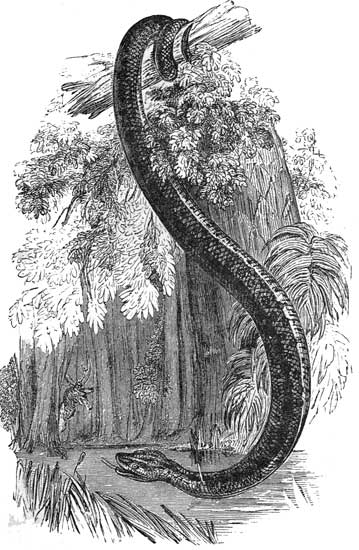 The Anaconda.
The Anaconda.
15. "The pythons of India and the boas of America," says Miss Buckley, "though they have[Pg 80] no poison in their teeth, can work terrible mischief with their powerful joints as they coil round even good-sized animals, such as an antelope or a wild boar, and crush them in their folds. Then it may be seen what a terrible weapon this flexible backbone is, as the muscles draw it tighter and tighter round the animal, breaking its bones in pieces, till, when it is soft enough to be swallowed, the snake gradually forces it down its capacious mouth, moistening it with saliva as it goes."
16. The boa-constrictor is sometimes thirty feet long, and when watching for his prey he hangs from the limb of a tree, like a huge vine, with his head near the water, waiting for some unsuspecting deer to come to drink. These animals have never been known to attack a human being.
17. The snake is a sober, serious animal, and has none of the humor or play which we have noticed in the crane and swallows among birds. But the common snakes are often tamed, and, when they have once become pets, they are fond of being handled.[Pg 81]
"But alas for the joys of this mutable life!
Sir Orpheus lost his beautiful wife—
Eurydice—who vanished one day
From earth in a very unpleasant way;
It chanced, as near as I can determine,
Through one of those vertebrated vermin,
That lie in the grass so prettily curled,
Waiting to snake you out of the world."—Saxe.
1. When we compare snakes with other animals, with our home pets, that we love and trust, or with the little inhabitants of the orchard, that seem so innocent in their life of flight and song, we can hardly help feeling how low and detestable are these crawling creatures of the ground. Indeed, the snake is a low animal, and has less brains than the bird. But he was in the world before we were, and he has his rights, which we are bound to respect. It is our ignorance that interferes with the life of the snake, and it is this ignorance that gives us unnecessary alarm.
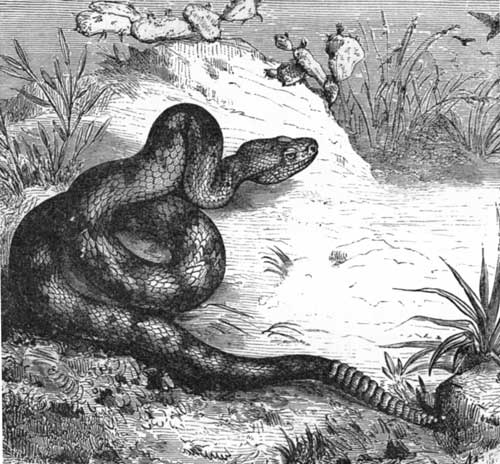 The American Rattlesnake.
The American Rattlesnake.
2. The nature and habits of snakes have been thoroughly found out, and we may easily know all about them. Of harmful or poisonous serpents there are but three in all the broad territory of North America. They are the rattlesnake, the copperhead, and the water-moccasin. And these animals are furnished with the terrible power of[Pg 82] producing death by poison, not that they may hurt human beings, but that they may benefit themselves. These creatures do not seek to injure sheep, or cattle, or horses, or men. They are simply after small animals to supply their table with food. All they ask of the larger ones is to be let alone. The poisonous wound they inflict, for the purpose of securing their prey, is only another way of doing what the constrictors perform with their affectionate hug, when they coil about their[Pg 83] game and crush it to death. And when they are attacked they use this poisonous bite as their only means of defense.
3. The deadly weapon of the venomous snake is not his tongue; this is only the finger with which he feels. The fangs are his instruments of death. These are teeth, about four times as long as his harmless teeth, and they project one on each side of the forward part of the upper jaw. When at rest they are turned back in the mouth, and are only raised to strike the victim. The fang has a groove, or tube, through which the poisonous fluid, stored in a gland in the jaw, flows. The same muscles that throw forward the fangs, press the glands, and send forth the poison. What the poison is, no one exactly knows. It has for ages been used by savage tribes to give the power of death to their arrows.
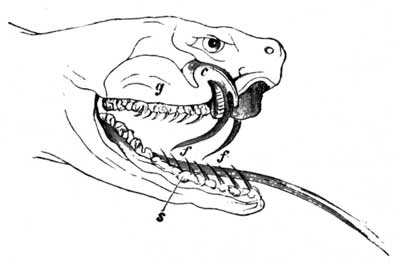 Jaw of a Rattlesnake:
Jaw of a Rattlesnake:4. Much of the horror felt toward harmful snakes arises from the strange and hideous stories people make up concerning them. A foreigner, once writing about one of our reptiles, says: "There[Pg 84] is here, also, a large and horrible serpent, which is called a rattlesnake. It has a head like that of a dog, and can bite off a man's leg as clean as if it had been hewn down with an axe." There is not a child who will not pronounce this a wonderful picture of the imagination. Let us now see what the rattlesnake really is.
5. The rattlesnake is not so large as the common black-snake, being only from three to four feet long. He is light-brown above with two rows of darker brown spots. The prairie rattlesnake, or massassanga, is the same animal, only frequenting more open marshes and prairie lands. The name of the rattlesnake comes from the noisy rattle he carries on the end of his tail. The individual rattles rarely number more than fifteen, and are no indication of the animal's age. He feeds upon young hares, squirrels, and birds, which he secures by lying in wait for them. This snake is a slow, sleepy creature, and never attacks a large animal unless disturbed or annoyed.
6. When after his prey, which may be a bird, or a squirrel, he rolls himself into a coil, gives the victim one thrust with his fangs, and then draws back to wait for the effect. In a few minutes the prey is dead, and is soon swallowed by its captor. Whenever he is approached, the rattlesnake shakes his rattle, as much as to say, "I am here: don't tread on me"; and if his voice is obeyed, he will be as harmless as the pussy-cat in the nursery song[Pg 85]—
"If I don't pull her tail, she'll do me no harm."
The black-snake is the enemy of his poisonous neighbor, as the following story shows:
7. "In the middle of the road lay an ordinary black-snake and quite a large rattlesnake, eying each other fiercely, both ready for an attack. A person stood motionless to see the battle take place; but he waited long, and still the combatants did not move. At length, tired of watching, he slightly shook the bar of the fence, which caused the rattlesnake to look from its opponent to himself. Instantly the black-snake sprang upon the other, twisted itself tightly around its neck, and then its body, and glided off, and there lay the rattlesnake dead."
8. From his general character, one would hardly conclude that the rattlesnake would cultivate social and friendly relations with other animals. But it has been found that he is a cunning friend and fellow of some other creatures, and that he actually keeps house with them. In the far West, prairie-dogs and burrowing owls live together agreeably in the ground-houses they build. The rattlesnake finds here a warm and cozy shelter, and is freely admitted as a boarder. He never troubles the owl, nor does he molest the dog; but the young of the dog soon disappear, and we can easily guess how and where.
9. The copperhead, an inhabitant of the Southern States, is about two feet long, quiet, silent,[Pg 86] and dwells in dark, shady places. Its color is light-chestnut, with darker lines or cross-bars, and its head is deep copper color, whence its name. The harmless hog-nose snake somewhat resembles it, and is sometimes mistaken for the copperhead. The moccasin, or cotton-mouth, of the Southern States, is about the size of the copperhead, of dark-chestnut color, with cross-bars of black. In summer it lies on the low branches of bushes over-hanging the water, watching for its prey, and is more lively than other poisonous snakes.
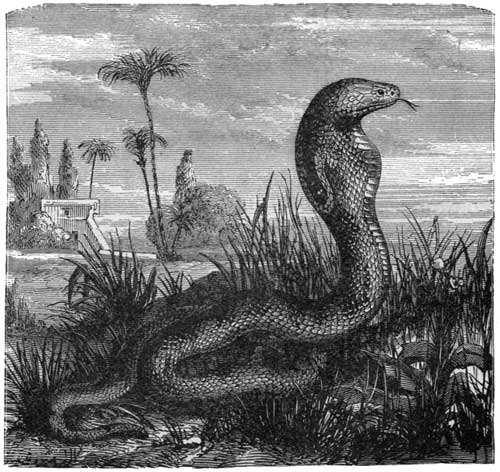 The Cobra de Capello.
The Cobra de Capello.
10. The cobra, which inhabits many parts of Asia, is remarkable on account of the stories that connect it with the Indian jugglers. When at rest, the neck of this snake is no larger than its head; but, when excited, the neck swells to great size, while the animal raises the front part of his body upright, and becomes stiff like a bar of iron. This expanded neck gives it the name of hooded snake. There is also on the back of this hood a figure, like one of the eyes of a pair of spectacles, and hence it is called the spectacled viper. Although the bite of this animal is deadly, the natives regard it with religious veneration. It is said that the Buddhists, when they have caught a cobra, inclose it in a basket of woven palm-leaves, and set it afloat on a river, when it is supposed it will escape and swim to the shore.
11. The cobra in its wild state is more spirited and ferocious than our rattlesnake. During recent years it has increased in number to an alarming extent, and, driven by a scarcity of its ordinary food, has attacked and killed a great many cattle and human beings. To reduce the ravages of these pests, the English government offered large rewards for their destruction. The natives, finding it a profitable business to bring in snakes' heads, readily put aside their religious superstition, and nurseries for the breeding of these reptiles sprung up everywhere. Hence, it was found[Pg 88] necessary to discontinue the reward, and let the cobras have their own way.
12. On the other hand, the cobra is said to become a sociable pet, and harmless to its known friends. A wealthy man in India kept several cobras, in the place of dogs, to guard his property. They were accustomed to go in and out of the house with other animals without molesting anybody; but they were a terror to thieves, and, as we might naturally infer, very few innocent visitors would approach a house so guarded.
13. That snakes sometimes show an intelligence worthy of higher animals, is shown by the following incident: A cobra had thrust his head through a narrow hole in a fence and swallowed a toad; but with this load he could not withdraw himself through the hole: so he let the precious morsel go, and the morsel began to hop away. This was too much for the snake philosophy to bear, and the toad was again swallowed, and again the snake found himself too big to draw back through the hole, and again let him go. Finally, the cobra, having learned his lesson, seized the toad by its leg, drew it back through the hole, when it was swallowed in triumph.
14. The Indian jugglers in some way exert great power over these snakes. It has been a puzzle to visitors and naturalists to know how they manage them. One of these men will take a single snake in his hands, tie it about his neck,[Pg 89] and handle it as if it were a kitten. He will then introduce a chicken, which the serpent immediately bites, and which soon dies, when the juggler will again play with his animal.
15. Some charmers brandish a stick at the snake, and play a sort of flute before it, when the beast moves in a regular manner, called a dance. It has been thought that these tricksters merely make personal friends of the animals, or that they extract their fangs, for they are observed to be apparently bitten, yet without harm. One of them, however, was exposed by a naturalist, who knew all about snakes. He found that the charmer had a young python so skillfully painted that an ordinary person could not distinguish it from a cobra. The charmer made a show of great alarm when this stranger asked the privilege of handling the snakes, but finally yielded; the naturalist took the snake, and was slightly bitten. Then the native applied his snake-stone to the wound, and made up queer faces, as these show-men do in such cases, and convinced the spectators that these wonderful remedies had cured the naturalist.
16. Snakes of all kinds find effective enemies in pigs. The porkers seem to relish a meal even of the poisonous kind. They are not annoyed by the bite, and the wound does them no harm. The secretary-bird and buzzard take pleasure in combats with these dangerous creatures, which they[Pg 90] eagerly devour. And we are glad to leave the poisonous reptiles to the tender mercies of their foes, and to know that their numbers are gradually decreasing.
"On the crimson cloth
Of my study-desk,
A lustrous moth
Poised, statuesque.
Of a waxen mold
Were its tight limbs shaped,
And in scales of gold
Its body was draped;
While its delicate wings
Were netted and veined
With silvery strings,
Or golden grained,
Through whose filmy maze
In tremulous flight
Danced quivering rays
Of the gladsome light."
1. Butterflies and moths, because they are so light and airy, have been called "winged thoughts." Their beauty is all that the poet sees in them, and all that we, who are not poets, usually see. This beauty charms us, as it should; but it also misleads us. Nearly everybody gives the butterfly a chance of life, because she is beautiful,[Pg 91] while less attractive insects are stepped upon because they appear disgusting. This is unjust to the butterfly, as well as to their companions, and unjust to ourselves. Our treatment of insects is a mistaken one, because we know so little about them. We must walk into their world, and find out what they are, and what they do. We must know who among them are, and who are not, our true friends.
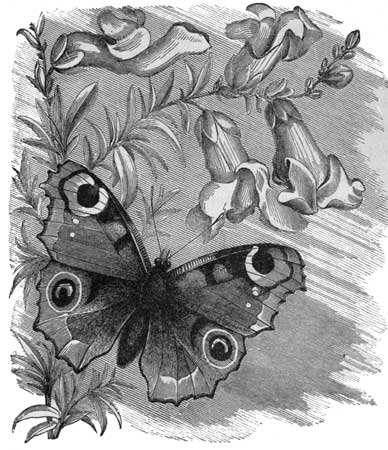 The Peacock-Butterfly.
The Peacock-Butterfly.
2. Butterflies and moths are insects; but what[Pg 92] are insects? Feel of one, and see how hard and often shiny is its body. They wear their skeletons on the outside, while birds, snakes, and fishes carry their skeletons inside their bodies. The insect has no real bones, but it has a head, a thorax, or chest, and a body, or abdomen, each protected by a case, and connected with the other parts by a movable joint. Joined to the thorax, it has six legs, and usually four wings.
3. The mouth of insects contains jaws that work toward each other horizontally, instead of up and down, as in the dog or horse. Some of them, like the cockroach and grasshopper, have jaws for crushing and chewing, and they trouble us by chewing too much. The mouth of others, like the butterfly, that sucks sweet juices from flowers, has softer jaws. And the under lip is turned into a tube, which, in some, rolls up, and, when unrolled, is long enough to reach to the calyx of a deep flower. From the sides of the mouth run out long feelers, or antennæ, which carry the sense of touch; though insects have some power of feeling in their lips and feet.
4. For breathing, the insect has holes nearly all over the whole body; and tubes connect these holes with the living organs within. But the most wonderful thing of all about them is the change of form through which they pass. First is the egg; then the living thing that is hatched from the egg, which is called the larva, or caterpillar;[Pg 93] then the pupa, or chrysalis, in which the larva is wrapped up like a baby in its blanket; and, last out of the pupa, the perfect insect. Like birds, insects live in the air, the earth, and the water.
5. Those of showy wings are grouped together. They are called scale-winged. You have noticed a fine dust, or bloom, on the wing of the butterfly, which is easily rubbed off. Under the microscope these patches of dust prove to be scales, and they give to the wing its colored and metallic hues. And, what is still more curious, these fine particles have the form of perfect scales, and they lap over one on the other like the scales of a fish. So, the butterfly, by its wings and its scales, is cousin to both birds and fishes.
6. Now for the difference between butterflies and moths. Butterflies are on the wing in the day-time, while moths fly at night. The antennæ of the former end in knots or clubs; those of the latter are pointed. When at rest, the butterfly erects its wings on its back unfolded; the moth folds its wings lengthwise, like a fan. The beauty of the wing often serves for a protection; when laid back or folded, the insect can scarcely be distinguished from the flower or leaf on which it has alighted.
7. Butterflies among insects are what hummingbirds are among feathered beings. Sporting their bright colors in the sunlight, and gamboling from flower to flower, sipping sweet juices, they live but[Pg 94] a few weeks. So, they have been thought to picture a vain life of ease and show that ends in nothing. This is all wrong. Mrs. Butterfly is a great worker. She is serious and earnest, as much so as any robin or blue-bird that builds a nest and cares for its young. Her beautiful dress is her protection. As long as she is admired, she will escape harm: and that is just what she wants, while she is busy as a bee hunting nests for her eggs, and providing for her young when born.
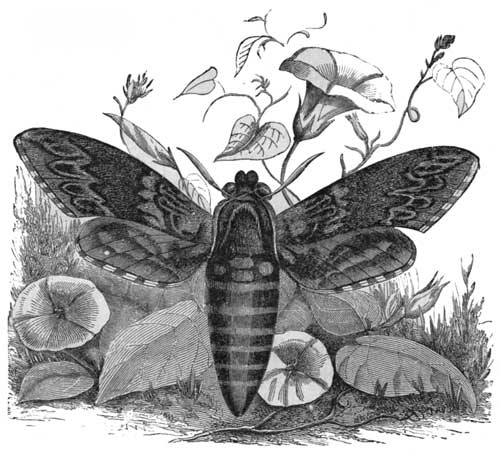 The Convolvulus Sphinx-Moth.
The Convolvulus Sphinx-Moth.
8. And this gay Mrs. Butterfly, while she[Pg 95] seems to be airing her fine clothes for the benefit of admiring eyes, is all the time, with the industry and affection of a real mother, providing, it may be, for a future brood of destroyers. Look at the crawling green or hairy caterpillars: these are the dear children of the beautiful Mrs. Butterfly. When you are gazing at these infants, the mother, perhaps, has gone to her grave. Life with her was a great success. A dozen boys tried to catch her with their hats, but failed. Little girls praised her beauty and said sweet things about her, but never thought of doing her harm—least of all that she might be doing harm.
9. In the garden she was fluttering about, and with white wings, bordered and tinged with black, she was wantonly skipping from flower to flower. Little children pursued her, and the gardener cautioned them not to kill the delicate little creatures. To-day, perhaps, the gardener is hunting over his cabbage for the little creepers that are robbing him of the fruit of his labor, wondering where the wicked pests come from. And the little girl is asking her mother to brush the horrid creature from her neck. Yet, while they were admiring the beauty of Mrs. Butterfly, she was slyly making nests for her ugly and destructive children in the gardener's cabbages. Her scheme worked well. Fifty robber caterpillars now rise up and call their mother blessed.
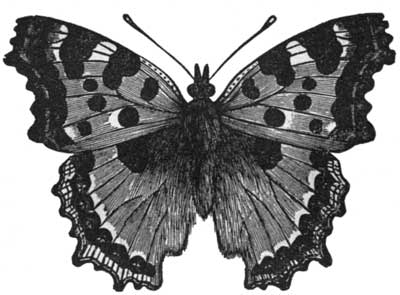 Large Tortoise-Shell Butterfly.
Large Tortoise-Shell Butterfly.
10. So, there are busy hands at work early in[Pg 96] the summer-day trying to find the great green caterpillar, that strips the plants of tobacco, potato, or tomato. It did not occur to the heads that bend over those hands that they had possibly met the mother of these detested worms. She was so beautiful, with wings extended four inches, delicate as gossamer, and glorious in colors of brown, yellow, and black. This was Mrs. Moth, or Mrs. Hawk-Moth. She was too beautiful to kill; yet she was the mother of at least sixty of those destructive infants. She was cunning. She produced just the impression she intended. How much easier to destroy the mother than to hunt for her sixty children!
11. The peacock-butterfly, however, may live, and display to admiring eyes its wings of russet-brown and black, each adorned with the mark of the peacock's tail. The tortoise-shell butterfly, with wings of yellow and brown, edged with dark bands and spots, may also live. These please the eye, and their children are harmless. But it is the duty of Mrs. Cabbage-Butterfly, Mrs. Hawk-Moth, and the more unattractive parents of cut-worms[Pg 97] and canker-worms, to die early; and it is our privilege to help them to die.
12. The way that Mrs. Hawk-Moth, or Mrs. Butterfly, becomes a citizen of the community of insects reminds us of the way Jack's house was built. Her mother laid the egg that hatched the caterpillar, that turned into the chrysalis, that brought forth Mrs. Hawk-Moth, or Mrs. Butterfly. A cluster of eggs was glued to the under side of a leaf. In about ten days the hungry infants appeared, each moving on sixteen legs. Lively infants they were. All the nursing they required was done for them by their mother before they were born. They are born on a breakfast-table, and begin at once to eat. They continue to eat. They eat continually. They eat enormously. In one month they eat ten thousand times their own weight. By and by they grow tired of eating and of life.
 The Cabbage-Butterfly.
The Cabbage-Butterfly.
13. Then each caterpillar crawls on the under side of a leaf, and spins from its mouth a tuft of silk, with which its hind legs are fastened to the leaf. Here it hangs, head downward, and seems to die. In twenty-four hours its rough coat is[Pg 98] gone, and in its place is a long case like an acorn, which is often bright-green, and sometimes covered with dots of gold. For this reason it is called chrysalis, golden. This is the pupa. It lives on what the caterpillar ate. But soon the green grows purple; the gold turns pale; the front of the chrysalis opens like the parting of curtains, and out comes the perfect creature, in robes of gorgeous velvet, with wing of gold.
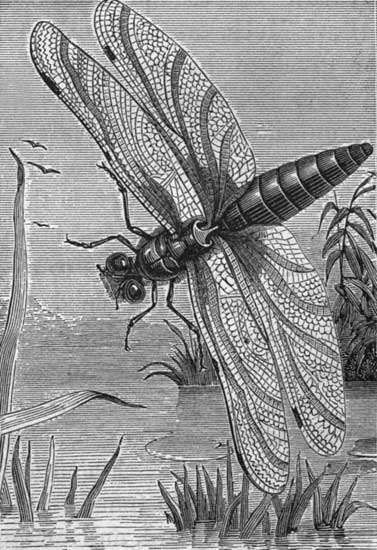 The Dragon-Fly.
The Dragon-Fly.
14. As no artist with color and brush can paint anything so beautiful as the wing of some butterflies and moths, so, no engineer has ever contrived anything so light and yet so strong as the four gossamer wings of the dragon-fly. From its long, sharp body, stretching away out behind its wings, it has acquired a bad name, and is called the devil's darning-needle. This is a slander, for the dragon-fly is one of our friends among insects. It is a dashing war[Pg 99]rior, and eats everything of the insect kind—flies, gnats, mosquitoes, and butterflies. This fact should warm our sympathies toward the dragon-fly.
15. The life of the dragon-fly is mostly about the water. In the water it deposits its eggs. Here the larvæ are hatched. They are greedy eaters, and live in this state for about a year. Then they crawl up the bank, perhaps climb a bush, and become pupas, not inactive, like the chrysalis of the butterfly, but eating all insects that come in their way. When the pupa is complete, it seizes a twig, and swings back and forth until an opening is made. Then the perfect insect, in tints of white, scarlet, blue, and green, comes forth, and is an object of great beauty.
1. The house-fly loves us better than we love her. She comes with the summer, and makes a world of trouble. But the summer would seem wrong without flies. Old Dinah, in the kitchen, finds her soul vexed when flies are many; and when they are few her face looks sad, and she says: "A heap o' trouble will come if we don't have more flies." Walter, who is just old enough to inquire about everything he sees, wonders[Pg 100] where so many flies come from, and older people too are as curious as Walter.
2. Last autumn the great host of house-flies died and disappeared. Old age and the frost took them away. Only a few remained alive, and these hid in warm nooks about the chimney, or in the wardrobe. When the spring opens, these few flies will deposit their eggs in litter and decaying substances. One of them will lay four hundred eggs. The young hatched will, when they become perfect insects, lay eggs. So that from one fly, left over from last fall, there may be produced two million, active, playful, saucy youngsters.
3. The foot of the fly is a curious thing—
"How it crawls, up the walls,
Yet it never falls."
The foot has two claws, and hollow cushions, which, with the aid of a sticky fluid, press the air out and adhere to smooth surfaces like glass. The eye is composed of a great number of small eyes; and the tongue, which anybody can see, runs out and ends in knob-like leaves or lips, which lap or suck up sweet liquids. Like the chimney-swift, the house-fly keeps close to the habitations of men. In the lonely coral island of the sea the appearance of this familiar friend indicates that human beings are near.
4. The house-fly does not injure man personally; he does not bite, but enters the house to get[Pg 101] his food. Walter understands this, but he fails to see why the flies bother him so, if they do not want to bite him. And this is a difficult point to settle. The affection the fly bears toward us must be strong. If he lights on the forehead, he takes no hint to leave. Possibly he visits the human head for the same reason as boys pelt it with snowballs—only for fun. There seems to be a great deal of boys' fun in the fly. Bring your hand down on the forehead when he lights, harder and faster, till it aches; the fly makes good use of his eight thousand eyes, his springy legs, and his active wings, and always escapes unhurt. Doubtless he is pleased at the headache he causes.
5. It is very different with the mosquito, that comes from the pupa, that comes from the little wiggler, that comes from the egg that was laid in the water. It is said that young mosquitoes purify stagnant water; but they do not, it must be said, always purify human temper. Still, there is no mischievous fun about the mosquito. He is honest. He is a sober, solemn man of business. When he approaches his victim by night, he comes for blood, and his victim knows it. He sounds a trumpet before him, giving his victim a chance to prepare for defense.
6. When he lights on the human face, the mosquito, at the peril of his life, proceeds at once to business. He introduces into the soft cheek his proboscis, takes a sip of blood, leaves a little[Pg 102] irritating saliva to raise a memorial of his work, and then withdraws in triumph or dies like a hero. Not so the fly. Like a silly, wanton boy, he runs over the skin of his benefactor, always tickling and teasing, but never biting. A white, shiny bald head is regarded by flies as a base-ball park specially provided for their amusement.
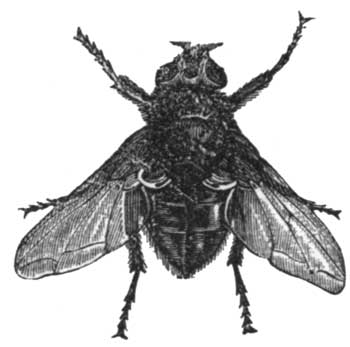 The Blue-Bottle Fly.
The Blue-Bottle Fly.
 Larva and Pupa.
Larva and Pupa.
7. The blue-bottle fly, known by its green-blue color, does not annoy our persons, but troubles our meat and other food. Besides a proboscis, it is furnished with a lancet, to cut into tough flesh. Its sole object is to find a place where to lay its eggs; and, like the butterfly, it seeks a nest for its eggs in the particular substance which its young larvæ like to eat. This is chiefly meat. Hence, in warm weather, meat can not long be exposed before it is blown by this blow-fly. Nor is this fly to be beaten by an oval cover of wire gauze placed over the food. If she can not touch the meat, she will sit on the top of the cover and drop her eggs through the holes. And from these eggs come unpleasant larvæ called maggots.
8. Walter received an impressive lesson on bees. On his third birthday he visited a friend in the country. Like most youth of his age, he felt in duty bound to investigate everything.[Pg 103] Displeased with the arrangement of things, he carried the wood-saw to the barn, and brought the horse-collar to the wood-shed. He also had the good fortune to find a green apple. In his attempt to secure it he invaded the territory of a hen with chickens, whose attack was not pleasant to Walter. However, he laid hold of his apple, and looked about for a place of safety. On one side of the orchard he saw a row of square white boxes, and it occurred to him that one of these would be an admirable seat, from which he might survey the objects about him, and eat his apple in peace.
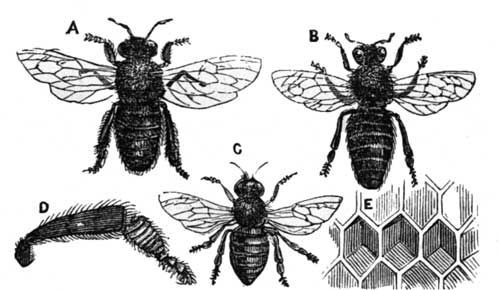 The Common Honey-Bee.
The Common Honey-Bee.
9. So he ran to the row of bee-hives, stepped upon the platform on which they rested, climbed to the top of one of the boxes, and sat down. As he began to eat his apple, he also began to knock his heels against the sides of the box—a motion of young boys that always shows they are inwardly happy. But this violence was more than the quiet workers within could bear. They rushed out and attacked the heels that were creating the disturbance; and not only the heels, but everything connected with[Pg 104] the heels—the legs, the body, the hands, the face, the head. The lad dropped his apple, sounded a loud alarm, and was with some difficulty rescued. This was Walter's introduction to bees, which was principally an introduction of the bees to Walter.
10. Since Walter has grown older he has learned many other interesting things about bees besides the sting. The queen bee is longer than the others, and is mother and ruler of the whole hive. She lays in the cells of the comb three kinds of eggs, that produce three kinds of bees: the males (A), the queens (B), and the workers (C). The drones neither work nor sting. The workers do all the work and all the stinging. Walter regrets to find that the workers and drones live in the same hive. If he is again to sit on a hive, he would prefer that it should contain only drones. Other facts he has learned, which may easily be found—how the workers make a new queen; how they make wax (E); how they feed the young (D); and how they live through the winter; and why they store their honey in a great many small cells, rather than in a few large ones.
11. Our young friend has added to his stock of knowledge something about the carpenter-bee, that lives alone and builds her nest in the body of a tree. She bores holes, and in them makes cells, one above the other, like a row of shelves. In the bottom of the cells she mixes a paste of sawdust and honey, in which she lays her egg, and then[Pg 105] closes the cell with her cement. It is remarkable that she always incloses food enough to supply her young till they change into pupæ.
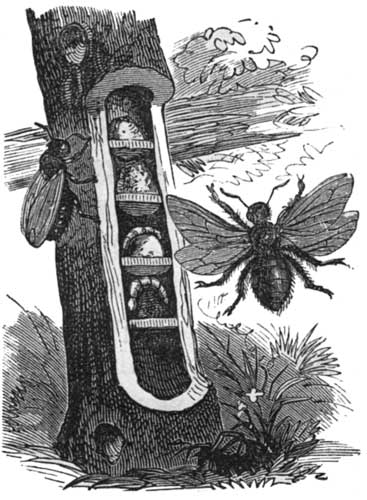 The Carpenter-Bee.
The Carpenter-Bee.
12. The humble-bee, the "yellow-breeched philosopher," Walter investigated with a stick. He found out how the old bee dug out a nest in the ground, laid eggs, and hatched larvæ, who spin little silk houses about themselves. He found that humble-bees store but little honey; but it was pleasing to know that when they gather the pollen of clover-blossoms for their young, they carry this pollen from flower to flower, so that the clover will bear its seed.
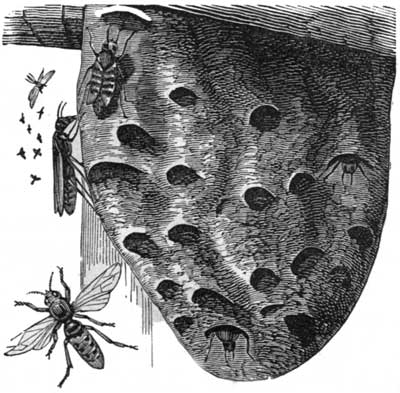 The Mud-Wasp.
The Mud-Wasp.
13. Our little naturalist[Pg 106] has learned something about wasps, without being stung by them. The mud or mason wasp brings to the place, where she builds her nest, balls of fresh mud, which she flattens and spreads out by the use of her jaws, as a mason does with his trowel. She divides the nest into cells, and in each cell places an egg. Then she hunts butterflies, caterpillars, and spiders, and stings them so as to paralyze them, and puts one of these animals into each cell for the larvæ to eat when they are hatched.
14. The paper-making wasps are more like bees. They build for a large society. They have queens and workers; but both work, and no particular one rules. Theirs is a free city, where all females are queens, and all work for the public good. Their house is built of paper. For it they pick up scraps of newspaper; but the most of their building-material is made of the fiber of wood, which they chew and work into balls. These balls are carried between their legs to the place of building, where they are rolled into thin sheets. Of this paper six-sided cells are made, which are not storehouses for honey, but cradles for babies. The wasp has an ugly sting, which it uses when interfered with; but it is peaceable and remarkably cunning, as this story shows:
15. "One morning a wasp lighted near a spider's nest, on the side opposite the opening. Creeping softly around toward the entrance of the nest, the wasp stopped a little short of it, and for[Pg 107] a moment remained quiet; then, reaching out his antennæ, he wriggled it before the opening, and withdrew it. Immediately the boss of the nest, as large a spider as one ordinarily sees, came out to see what was wrong. With a quick movement the wasp thrust his sting into his foe, killing him almost instantly. The same experiment was again tried by the wasp, and, when there was no response, he proceeded to enter the nest and slaughter the young spiders, which were afterward lugged off one at a time."
16. The little yellow horse-fly, or bot-fly, is almost as shrewd as the wasp. She wants her young to feed on the inside of a horse's stomach. How shall she get them there? She knows. While the animal is feeding she buzzes quietly over him, and now and then drops down and lays a few eggs on his shoulders and knees, places where the horse often bites and licks himself. In about twenty days these eggs, which were glued to the hair, open, and the horse takes the larvæ into his mouth and swallows them, and there they live and are happy, though by their presence the horse is not always so happy.[Pg 108]
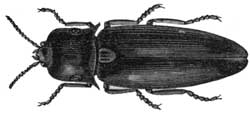 The Luminous Beetle.
The Luminous Beetle.
1. Almost everybody recognizes beetles when they are called bugs. There are the ham-bug, the May-bug, the squash-bug, the lady-bug, the tumble-bug, the pinch-bug, and the potato-bug—all familiar acquaintances. They are all beetles; and what is noticeable about them is their hard, shiny outside, or case. And it is sometimes a matter of surprise to find that one of these bugs, while crawling along, will suddenly rise and fly, though no wings are to be seen. This is because the two forward wings are not used for flying, but to cover the other two wings. So, when the animal is not flying, the wings lie down and are inclosed by these shiny covers.
2. The larva of the beetle is like that of the butterfly, and resembles a caterpillar. It has thirteen rings, or sections. But the pupa is not so perfectly covered. The beetle has two eyes, one on each side of the head; but they are compound, and, like those of the house-fly, contain many small eyes. Besides these, there are two eyes on the back of the head. None of these organs turn or move in a socket, as our eyes do. Why should they? There are so many of them, that they can see in every direction without turning.
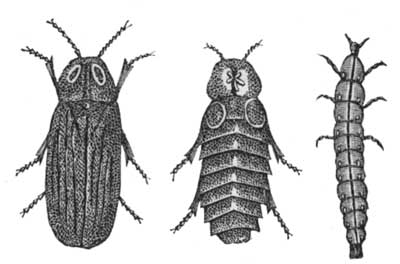 The Glow-Worm.
The Glow-Worm.
3. Some beetles are beautiful—glistening with[Pg 109] burnished green and copper color; and there are those in tropical countries that are worn as ornaments of dress. The fire-fly, that is so attractive in the darkness of a summer night, and which children capture with their handkerchiefs, and hold with their fingers, is a beetle. A cousin of the fire-fly is the glow-worm, which is also a beetle. The worm, or course, is the larva; but the eggs shine, and so do the pupa, and the perfect beetle. The larva, or worm, may be seen at night in some damp place. The green-blue light comes from near the tail; hence, one of its names is lampyris, or shining-tail.
4. The glow-worm appears to control its light. When alarmed or handled, the light often disappears. Gilbert White, in his "Natural History of Selborne," says that the glow-worms put out their lamps between eleven and twelve at night. These "stars of the earth and diamonds of the night" are very abundant in some parts of England. In the West Indies the natives have[Pg 110] employed them, or a similar insect, as lamps in performing their household occupations. In their fishing and hunting expeditions, by night, they tied glow-worms or fire-flies to their toes, and required no other light. The light emitted by insects of this class has been commonly regarded as phosphorescent; but it is supposed by some to come from real burning, like the flame of a lamp.
 The Cockchafer and Larva.
The Cockchafer and Larva.
5. Sometimes a feeling of disgust or hatred toward an insect becomes softened or changed when the hated object is found to be of some use. But here is the May-beetle, called the June-bug, or cockchafer. Coming in great numbers, it often eats off the roots of the grass, and is as destructive as a herd of mischievous pigs. It is hard to find anything good about the cockchafer, unless, as in France, it gives amusement to little children, who harness it with thread and make it draw toy carts. Or unless it be to take possession of a whole human habitation, and give healthful exercise to its inmates on some[Pg 111] warm June evening, when all are disposed to be inactive or lazy.
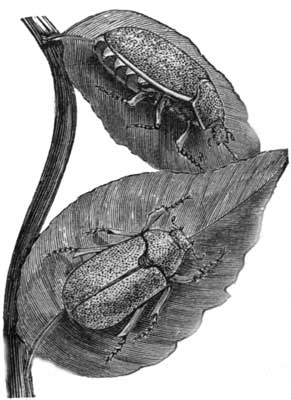 The Cockchafer feeding.
The Cockchafer feeding.
6. This ambitious insect chooses the occasion for showing its power with a wisdom worthy of the greater beings against whom it brings its harmless attacks. It is when all is quiet, and kind friends, old and young, male and female, are gathered to talk and laugh, and sing and play. Or it watches for some festive occasion, when fluttering, airy dresses abound, and those whom it specially delights to bring under its power are gathered in large numbers. Then it is that this smooth, shiny, chestnut-colored being, no larger than the end of one's thumb, dashes in at an open window, without warning, and with a buzz like the blower of a locomotive. The explosion of a lamp, the falling of the roof, or the cry of fire, could scarcely create a greater consternation. Instantly there are screams as if the house were in flames. All proprieties are forgotten, and beauty, fashion, and dignity run wildly against each other, upsetting chairs and tables in a promiscuous rush for places of safety.
7. All available weapons of defense are called[Pg 112] forth; handkerchiefs, newspapers, books, sheet-music, and fans. For a moment the attacking party is quiet, enjoying the rumpus he has raised, and can not be found. Then, unexpectedly, as at first, he rises, sounds his terrible bugle, makes a circuit of the room, causes a new fright, and another stampede, when he drops to the floor, is cornered, and suffers the penalty of death by the hand of some courageous masculine hero providentially raised up for the occasion.
8. The ancient myth tells the story of Sisyphus, a tyrant, who, as a punishment for his cruelty, was compelled constantly to roll a stone up a hill; the stone always rolling down again as soon as it reached the top. One is reminded of this story when he sees the tumble-bug with his companions moving a ball up the steep ground. This beetle was called the scarabæus, or sacred beetle, by the Egyptians, with whom it was a symbol of the world, of the sun, and of a hero.
 The Scarabæus.
The Scarabæus.
9. How many persons watch the movements of these beetles without knowing their object! Like Sisyphus, they patiently roll the ball up again and again, no matter how many times it rolls back. And for what purpose is all this tugging and patient toil? The little ball contains an egg of[Pg 113] the beetle, and, soon after it has reached the deep hole in the ground prepared for it, the beetle will die, without a sight of the infant for whom it has struggled so hard.
10. A story is told by Sir John Lubbock, of one of these intelligent beetles who had made for the reception of its eggs a pellet of manure too heavy for it to move. It went to an adjoining heap, and soon returned with three of its companions. All four now took hold together, and at length succeeded in pushing it. When the job was done, the three assistant beetles returned to their own quarters.
11. Another description says of these little black heroes: "I have attentively admired their industry, and their mutual assistance of each other in rolling these balls from the place where they are buried—usually a distance of some yards. This they perform, back foremost, by raising their hind parts, and pushing away the ball with their hind feet. Two or three of them are sometimes engaged in trundling one ball, which, on account of the unevenness of the ground, is sometimes deserted by them. It is, however, attempted by others with success, unless it happens to roll into some deep hollow or ditch, when they continue their work by rolling off the next ball that comes in their way.
12. "None of them seem to know their own balls, but an equal care for the whole appears to[Pg 114] affect the community. They form the pellets while the material remains moist, and leave them in the sun before they attempt to roll them. In moving them from place to place, both they and their balls may frequently be seen tumbling about over the little eminences in their way. They are not, however, easily discouraged, and, by repeating their attempts, usually overcome the difficulties."
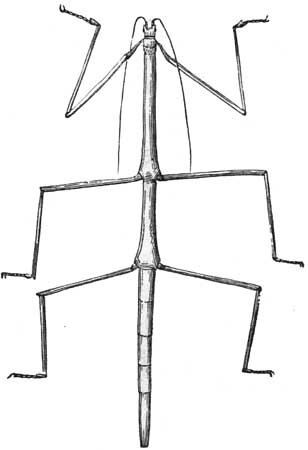 The Walking-Stick.
The Walking-Stick.
13. Another beetle is called an animated stick, or walking-stick. He is long and thin like a stick or twig, and his six legs are like smaller twigs; and because he so closely resembles the smaller limbs of a tree, it is difficult to find him. An attempt to catch one of these walking-sticks with a pair of scissors only succeeded in cutting the creature in two, when the head-end walked one way, and the tail-end walked in an opposite direction. Of the walking-stick there are several varieties, none of which are known to be harmful or destructive.[Pg 115]
1. The insect tribe is sometimes a powerful enemy, because its individuals are so small that their presence is not noticed; because their way of working is crafty, and their tools are perfect; and because their numbers are immense. A little creature half as large as a mosquito seems to be harmless, because it is so small; but, for this very reason, it can work in a head of wheat, or in the joint of a leaf, or bury itself in the stalk, and eat out its vital parts without being seen. Then, when there are so many of these invisible workers that they can furnish an artisan or two for each stalk of a whole wheat-field, the small fly grows important. And these are just the facts about a diminutive fly that destroys the crop that gives us the staff of life.
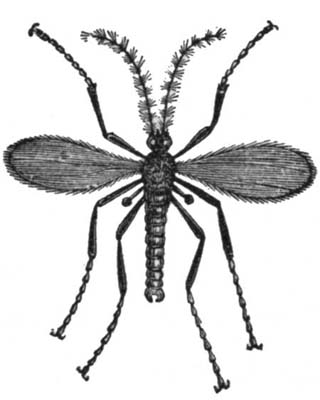 The Hessian Fly.
The Hessian Fly.
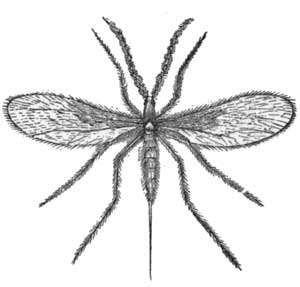 The Wheat-Midge.
The Wheat-Midge.
2. During the Revolutionary War, some Hessian troops came over to this country to join the army. In the straw they brought along for bedding were some black, two-winged, red-legged flies, that got their passage without paying their fare. It was a good trip for the future nation of Hessian flies, but a bad one for the American farmer.[Pg 116] These foreigners somehow found their way, in the early spring, into a field of young wheat. In the leaf of the wheat-plant each fly laid from twenty to thirty eggs: the eggs hatched maggots; the maggots bored into the stalks of the plants, and became pupæ, which produced perfect flies. These flies again produced maggots, that remained in the stubble of the wheat till another year. Millions of dollars' worth of precious grain did these armies of winged midgets destroy before their nature and habits were really known.
3. Then there is the wheat-midge, much like the Hessian fly, that lays its eggs in the ear of the wheat. After doing its destructive work of eating the soft grain, the orange-colored maggot descends to the earth, spins a cocoon for a house, and remains under the surface during the winter. Men of science, or "bug-hunters," as they were called, have greatly helped both the bread-raisers and the bread-eaters, by studying and describing the dark ways of these mischievous enemies. It was they who told the farmers to burn their wheat-stubble in the fall. They also found out and described those friendly insects that destroy these injurious ones.[Pg 117]
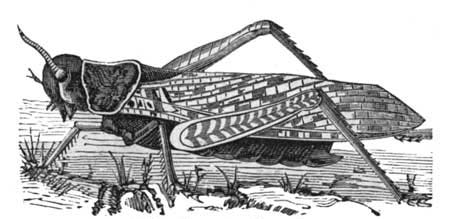 The Common Locust.
The Common Locust.
4. The name of locust carries an unpleasant sound, on account of the destruction and suffering caused by insects of this kind in the past ages of the world's history. In Asia and Africa, particularly, the visitations of locusts in ancient times were attended with wide-spread misery. They darkened the air as they flew, by their numberless hosts. One column in India extended five hundred miles in length. They devoured every green thing where they lighted. The Arabs represented the locusts as saying to Mohammed, the prophet: "We are the army of the Great God; we produce ninety-nine eggs; if the hundred were completed, we would consume the whole earth and all that is in it."
5. Of course, where such myriads of destroyers lighted, eating up all that was growing for the support of man and beast, they were dreaded as a terrible scourge. The people knew little about them, and so they resorted to all sorts of superstitious measures to get rid of them. In the Middle Ages the priests tried to drive them away by pronouncing solemn words in their ears. The Arabs caught four locusts, wrote on the wings of each a verse from the Koran, and let them go.[Pg 118] The locusts were glad to get off so easily, and went straight about their wicked work. It was found that nothing would really destroy them but a violent storm; and it is related that after such a storm a bank of dead locusts was seen four feet high and fifty miles long.
6. A locust, or cicada, not always harmful, visits us once in seventeen years. These seventeen-year locusts make themselves known when they come. Their noise, proceeding from beneath their wings, and something like the music of the tree-toad, fills the air, and has even drowned the rattling of mills. They sing when the sun shines, and the males alone sing. For this reason an ancient Greek poet has dared to sing:
"Happy are the cicadas' lives,
Because they all have voiceless wives."
The twigs of trees show regular parallel lines of punctures in which they lay their eggs; two eggs are left in each hole; the grub, or larva, falls to the ground, into which it bores to a great depth, and spends seventeen years in getting its growth.
7. The comfort and pleasure with which plums and peaches are eaten is often marred by finding in the fruit a little worm or grub, which seems to have no right there. This unpleasant occupant not only puts itself in danger of slaughter by human teeth, but it creates great disappointment by utterly destroying the crop of a whole season.[Pg 119] The work of this robber-beetle, or curculio, is done chiefly at night, when, with a long curved snout, it makes a crescent-shaped cut in the fruit, in which it lays its eggs. In this work she never thinks of any children but her own. One egg in each plum makes an insect child happy, and possibly a human child unhappy. The fruit is apt to fall before it matures, and a very small being out-wits a large one. By jarring the trees over sheets we may destroy the pests. Chickens, ducks, and pigs, running at large under the trees, also help preserve the fruit.
 The Curculio.
The Curculio.
8. Away in the Rocky Mountain region lived the potato-beetle with its ten black lines on its two-winged covers. It fed on a kind of wild potato. When men settled Colorado, and planted the common potato, these beetles, with the impudence that belongs to insects, seemed to think the nice, new, tender plant was grown for their especial benefit. So, they pounced upon the potato-fields; and, as they had more and better feed, they greatly increased. In the spring their bright-orange eggs could be seen glued to the under side of the potato-leaf. Soon came the larvæ, hungry and[Pg 120] ravenous. Three broods in a year were brought forth, and a single female would be mother and grandmother to several millions of offspring.
9. These insect savages took it into their heads that toward the rising sun were vast fields of the juicy plant provided for them, and they moved eastward at the rate of a hundred miles a year, until they reached the Atlantic Ocean, when some of them stole a passage, in ships that were loaded with potatoes, and visited Europe. Here they sampled English and French potatoes. The busy men of science quickly told us all about this enemy, and how to kill it; and they pointed out the beautiful spotted lady-bird and other friendly insects that are hostile to the Colorado tramp.
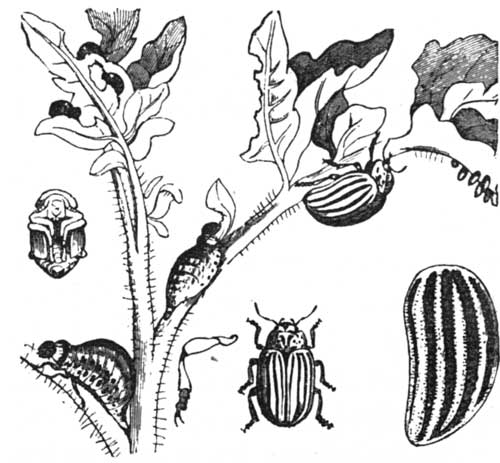 The Potato-Bug.
The Potato-Bug.
10. The people of States west of the Mississippi River remember too well another unfriendly visitor. This is the Rocky Mountain locust or grasshopper. Its home was in the high lands of the mountain regions. On those plains, when the[Pg 121] heat of summer came, the locusts hatched in numbers equal to the sands of the desert. Their food was the scanty buffalo-grass, which was not sufficient for them. So, the heat of July usually killed them off. But should they get their wings before the heated term arrived, they rose into the air like a sand-cloud; and, aided by the wings of the wind, they were borne to fruitful areas of the cultivated States. They lighted on the ground. They swept away every green thing with a devastation like a prairie-fire.
11. Are insects good for food? Why not? John the Baptist ate locusts with his wild honey. The natives of the tropics eat grubs and beetles. The Chinese eat the chrysalis of the silk-worm. The Hottentot eats white ants. Aristotle says the cicada is delicious. Intelligent Europeans eat snails. When the Rocky Mountain locusts paid their destructive visit to Western States, in 1874, scientific gentlemen had them served in the form of soup, roasted, and fried, and found them more delicious than frogs. It is prejudice alone that turns in disgust from such food. If we abhor the locust as food, so does the Arab, who eats the locust, abhor our delicious oyster as food.
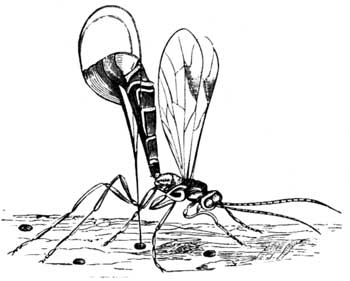 The Ichneumon-Fly.
The Ichneumon-Fly.
12. While we seek to know those insects that injure our food-crops, we should also take pains to be acquainted with those insect tribes that prey upon these robbers, and are, therefore, our friends. The most curious of these, perhaps, is the ich[Pg 122]neumon-fly. Sometimes the butterfly's chrysalis opens, and the wrong bird bursts forth. Joyous in its slender body, and its clear-veined, lustrous, steel-blue wings, this little sprite comes out as a winged practical joke upon the butterfly race, and many other harmful insects.
13. But how did it come to be in the chrysalis of the butterfly? It was in this way: The ichneumon-fly stung the caterpillar and deposited its egg. When the caterpillar and this stranger came into the golden house of the chrysalis, the ichneumon found the easiest way to get rid of his bed-fellow was to eat him up, which he proceeded to do. But the wonderful feature about the whole trick lies in the care with which this ingenious interloper laid its egg in the caterpillar. It was shrewd enough not to touch the vital organs, so that the caterpillar might live sufficiently long to get into the chrysalis, when it would serve as food to nourish the young bright ichneumon.[Pg 123]
1. Walter's fingers are to him what the antennæ are to the insect. They are his feelers, and by them he tries nearly everything that is new or strange. When he was very small, he first tested a thing with his fingers, and then, if not prevented, put it into his mouth. He was never satisfied unless he could prove things by his sense of taste. In this way he would have swallowed buttons, marbles, little stones, flies, and even spiders, had he not been restrained. But now he is contented to investigate with his hands and eyes; though his experience has taught him that, in working about insects, it is best to extend his antennæ by a stick. So, he pokes with his stick, and, if it is attacked, he can easily drop it and take to his legs.
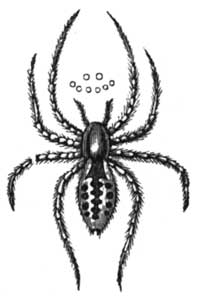 The Common House-Spider.
The Common House-Spider.
2. Walter has been deeply interested in spiders. The fact that they can not fly faster than he can run, as is the case with some other animals of his acquaintance, has given him boldness in the use of his stick. He has probed several webs and nests of Spiders rather roughly, and has found for himself that the common house-spider is harmless; that she stretches[Pg 124] her web across the corner of the room, or over a window-casing, and attaches to it a nice little silken house for herself, in which she sits and watches. He has also observed that the web of the spider is intended to catch flies; and that flies are the principal food of the spider. Indeed, he has, with great joy, seen the spider come out of her little den and drag away a fly unfortunately caught in this trap.
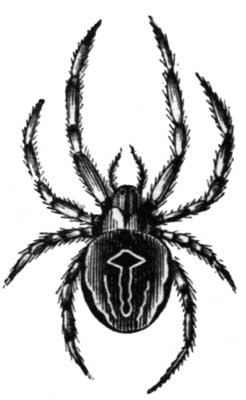 The Field-Spider.
The Field-Spider.
3. Walter's mother, who believes that a child may learn many things at home as well as at school, has encouraged his discoveries. She suggested to him not to break up the web of the spider with his stick, but to touch it gently. This he has done, with the most gratifying results. The slightest motion of the web by the touch of the stick brings the spider from her den, and she sometimes lets herself down by a silk thread. Then, when the stick threatens her, she climbs up by the same web; but, when Walter looks for the web, it can not be found.
4. He has discovered with delight the fairy wheel of the garden-spider, stretched across a window, or between two bushes, so as to catch flies on the wing. He has seen this same garden-spider trudging along with a white ball under her body. Walking in the street, on a bright autumn morning, he has[Pg 125] passed through a multitude of spider-threads, as if the little rascals who placed them there thought they could block up the way. Everywhere he looks for spiders' webs, and nearly everywhere he finds them. They are in the house, in spite of brooms and brushes, in the sheds and stables, on bushes, and trees, and fences.
5. Seeing all these things, Walter's eyes have laid eggs of thought away in his mind, which have hatched a brood of lively questions that he has turned loose upon his patient mother to feed. Much diligence has been employed to gratify this hungry crowd of questions. To satisfy them, Walter's teacher has assisted his mother, and they have gathered good things from cyclopædias and other books, some of which are here given for the benefit of Walter's friends.
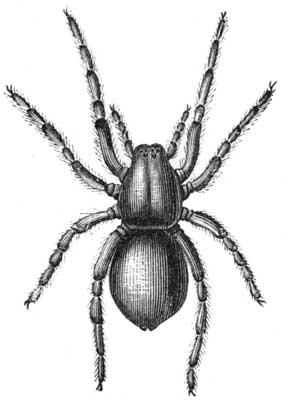 The Wolf-Spider.
The Wolf-Spider.
6. The spider is not a true insect; it appears more like a crab. An insect has three parts in its body, and six legs. The spider has but two parts; the head and thorax are one part, and the abdomen is the other. It has a soft outside of hair or fur. The jaws, as seen under the microscope, are savage-looking instruments.[Pg 126] They are like fangs. They curve in, and are edged with fine, sharp teeth, while through them run tubes that convey poison, stored away in the head, to the object they bite. All this is for catching and killing their prey; for spiders are carnivorous, and live on other insects, or, when they quarrel, devour one another.
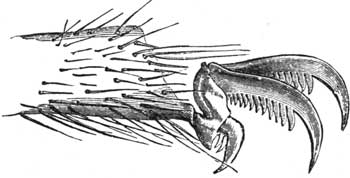 Claw of the Spider magnified.
Claw of the Spider magnified.
7. The spider has six or eight eyes, set in the back of its head. In those who work by night, these eyes are large and lustrous, like cat's eyes. It has eight legs, and it feels with its feet as well as with its lower jaws. The reason why its feet are so many is, that its weight may be so distributed that it will not bear heavily on any one point of the filmy web over which it treads. There are seven joints in the foot, and the spider does not mind losing a part of a foot, since another will soon grow. The feet have each from one to four claws, and are of great use in spinning and fastening the web. The female spider is larger than the male. Sometimes she grows angry at her[Pg 127] little mate, gives him a sound drubbing, and then usually eats him up.
8. The spider does not pass through the four changes of true insects, but from time to time it changes its outside covering. The female raises but one brood in the year. Her eggs are wrapped in a small silken cocoon. And this is what Walter saw the garden-spider carrying. When the eggs are about to hatch, the mother opens the sac and helps the little ones out. In most cases they take care of themselves and go straightway to spinning webs; though, in some varieties, they ride about for a while on the body of their mother. Spiders are neat in their habits, and often preen their dress with the fine combs attached to their jaws. Though they are severe with their prey, they rarely injure human beings, and their bite is scarcely more poisonous than that of the mosquito.
9. The web of the spider is its great wonder, and Walter's mind has long and earnestly wrestled with the question, "How is it made?" In the back part of her body she carries a glutinous substance, which hardens into a strong fiber as soon as it is exposed to the air. Then from the lower side of this part of the body there run out very small fingers, or spinners, that catch the glutinous fluid from little tubes, and work several strands into one web. The spider can start or stop the spinning whenever she chooses.[Pg 128]
10. A single fiber that comes from one of the tubes, though almost invisible, is composed of hundreds of fine fibers. This makes the compound-thread strong. It is also elastic, like India rubber. There are spiders, no larger than a grain of sand, who spin cords of which it would take millions to make the thickness of a single hair of its beard. The spinning is done too rapidly for the eye to follow. When a spider comes down from the ceiling, it descends head first. If stopped before it reaches the floor, it returns head first, and rolls the web into a ball as it ascends. This is why Walter could not find the web. Spiders are economical of their webs. The out-of-door spiders need to spin a new web nearly every day. If they perceive a storm coming, they do not spin, lest their work be destroyed. When they are at work, therefore, there is promise of fine weather.
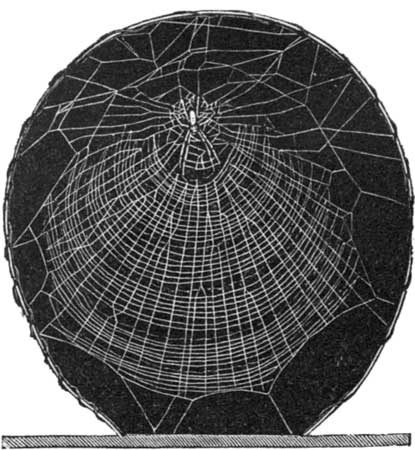 Web of the Garden-Spider.
Web of the Garden-Spider.
11. The garden or geometric spider is a wonderful little engineer. Between two bushes she stretches strong lines a few inches apart. Con[Pg 129]necting these, she runs cross-lines for the spokes of her wheel, pulling each with her foot, after the ends are fastened, to see if it is strong and light. She then carries her spiral lines round and round, uniting the twenty spokes of the wheel, and making a strong snare for her prey, as well as a nice floor for her eight feet to trip across. Over all she scatters minute globules of sticky substance, to aid in holding the feet of unwary flies. Why does she build in the form of a wheel? Because at the center of the wheel she can feel every part of the snare through the spokes. Then, from this center, she carries a telegraph-line to her watch-tower a short distance from the wheel.
1. The spinners, weavers, and builders of silk snares are of many varieties. The house-spider sits in a silken tube at the top of her net, waiting for some foolish fly to touch the floor of her pretty parlor. The tree-spider, from an outer branch, throws out a silk line, which a kind breeze carries and fastens to the next tree, when she proudly crosses, like a tight-rope walker. The jumping-spider fixes the end of its web, then leaps for a fly, and climbs backward by the thread which it spun[Pg 130] as it leaped. The little fellows that try to obstruct the street fasten the ends of their tiny cables to the fence, wait for a favorable breeze, spring into the air, and are carried by the fingers of the wind to the other side.
2. A Texas spider weaves a filmy balloon, six feet long and two feet wide, which she fastens to a tree by a single thread, and then flings to the wind. She walks on board with a half-dozen little ones, cuts the thread, and away goes the air-ship to some distant point on the prairie. The great spider of the Southern States, from one and a half to three inches long, is called[Pg 131] a tarantula, from Taranto, in Italy, where its kind abound. It is a wolf-spider, lives in the ground, but spins no web. It carries its young on its back. This animal appears more formidable than it really is. It is not disposed to attack, and its bite seldom leaves serious injury.
3. The large crab-spiders of South America make their gossamer snares so strong that they hold the feet of a humming-bird. In California is the trap-door spider. It makes a tube in the ground, silk lined, and closed at the top by a door that springs shut by an elastic web. With this tube is connected a web, spreading over the ground above. The spider sits safely at the bottom of the tube. If she is alarmed, she fastens[Pg 132] her claws into the door and holds it down, bracing herself against the walls of the hole. Beetles that are caught in the outside net are taken into this underground dining-room, their soft parts eaten, and the shells again thrown out.
4. Another, a nest-building tarantula, erects a tower over its tube in the ground. This tower is built precisely like the log-cabin of a woodsman, or like a child's cob-house. Spiders are met with in the forests of Java whose webs are so strong that it requires a knife to cut through them. And an account is given of the capture of a live snake by spiders. The snake was suspended by its tail in a web, the tail being tied in a knot. Three spinners were engaged in the feat, and they spun a large cord to connect the snake with the center of the web, securing the mouth of the reptile by winding strong threads about its mouth.
5. Down under the surface of a pond, fastened to the roots of some water-plant, the water-spider weaves a tight silken dome for her house, from which she drives out the water by air-bubbles, which she shakes from her body. From her comes the idea of the diving-bell, with which men explore deep waters for lost treasure. The silk of spiders is of finer quality than that of the silk-worm. Many years ago, in France, stockings and mittens were made of spiders' silk. These animals can live for months without food. Spiders may be tamed. A Frenchman once tamed[Pg 133] eight hundred of them. With some, spiders have been esteemed and loved as pets.
Nest-Building Tarantula.
6. Spiders are themselves affectionate. Those who carry the egg-sac with them for safety, also bear the young, after they are hatched, on their backs. It is said that when the parents become too old to care for themselves, their young feed and shelter them. Spiders are fond of music. A foreign prisoner, during his confinement, found comfort in the society of a pet spider, who was taught to come regularly, for its meal of flies, at the sound of a musical instrument. They prefer[Pg 134] the softer strains of music. During concerts they have been seen to let themselves down from the ceiling and to pause while gentle strains were played; but when heavier music began they climbed back again.
7. The music of the tuning-fork, because it is so good an imitation of the hum of the fly, is pleasing to the spider, as is shown by a sketch in the "St. Nicholas": "Now I can play a tuning-fork as well as anybody. I procured one, and then sought out a spider. I found a handsome, brand-new web, and, though I did not see Mistress Epeira, I knew she must be at home. Epeira diadema is her full name, though most persons call her garden-spider.
8. "As I have said, Madam Spider was not visible. I knew, however, she must be in her gossamer parlor, which is attached to her web. Here was a good opportunity to try tuning-fork music. I rapped the fork on a stone, and, in a moment, a soft, melodious hum filled the air. I touched one of the spokes of the web with the fork. On the instant madam flew out of her parlor in great haste, hesitated a moment at the outer edge of the web, and then, instead of going straight to the tuning-fork, ran to the very center of the web.
9. "When there, she caught hold of each of the spokes, one after the other, and gave it a little tug, as a boy does a fishing-line, to see if a fish is[Pg 135] hooked. Each was passed by until she came to the spoke upon which the tuning-fork rested. Then she stopped, and it was easy to see she was excited. She gave the web a shake, then tugged at the spoke again. Hum-m-m-m, still sang the fork, rather faintly now, however. Madam was satisfied. Her mind was made up. Down she darted, and caught the end of the fork in her arms. She tried to bite into the hard metal, and at the same time she spun a web of silk around and around the two prongs, which, by this time, had ceased vibrating.
10. "I pulled the fork away, and Madam Epeira retired in disappointment to the center of the web. Unfortunately, it was altogether too probable that she mistook the hum of the fork for the buzz of a fly—a sort of music, no doubt, very sweet to her. Time after time I repeated the experiment with the fork, touching in turn each spoke of the web, and each time Madam Spider was deluded into trying to capture the tuning-fork. It was odd that she did not learn wisdom by her disappointment."[Pg 136]
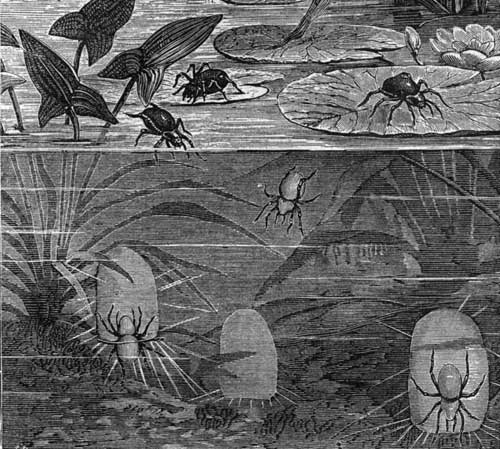 Water-Spiders.
Water-Spiders.
1. An Eastern summer is full of wonders; but there is, perhaps, nothing about it more awfully appalling than those flights of locusts which sometimes destroy the vegetation of whole kingdoms in a few days, and where they found a garden leave a wilderness.
2. I am riding along a pleasant hill-side, on the island of Mytilene, toward the end of May. There is a sharp, pattering noise, like that of April rain falling on hard ground. I look attentively toward the earth, knowing that it can not be a shower this clear, balmy morning, and I see a countless multitude of little black insects not much larger than a pin's head. They are hopping and springing about in myriads, under my horse's feet; along the hard, stony road, which is quite black with them; and far away in the fields, which are turned quite black also. I ride miles and miles, yet the ground is still darkened with these little insects, and the same sharp, pattering noise continues. They are the young of the locusts, who left their eggs in the ground last year. They have just come to life. Three days ago there was not one to be seen.
3. A little later I am passing through a Greek village. The alarm has spread everywhere, and[Pg 137] the local authorities have bestirred themselves to resist their enemies while still weak. Large fires are burning by the river-side, and immense caldrons of boiling water are steaming over them. The whole country-side has been out locust-hunting. They have just returned with the result of their day's exertion. Twenty-three thousand pounds' weight of these little insects, each, as I have said, no bigger than a pin's head, have been brought in already in one day!
4. They have been caught in a surface of less than five square miles. There has been no difficulty in catching them. Children of six years can do it as well as grown men. A sack and a broom are all that is necessary. Place the open sack upon the ground, and you can sweep it full of locusts as fast as you can move your arms. The village community pay about a half-cent a pound for locusts. Some of the hunters have earned from fifty to seventy-five cents a day. As the sacks are brought in, they are thrust into the caldrons of boiling water, and boiled each for some twenty minutes. They are then emptied into the rapid little river, swollen by the melting of mountain snows.
5. My Albanian, Hamed, watches these proceedings from his embroidered scarlet saddle with much melancholy gravity. "Ah!" he says, "if there was but one dervish or good man among these rogues, he could pray them away in an hour.[Pg 138] There are no locusts in my village, because we have a dervish, a saintly man, there."
6. It appears that no dervish comes, and the plague goes on spreading daily from village to village, from town to town. This is the fourth year since they appeared at Mytilene, whence I am writing. It is said that they seldom remain at one place much longer, but that, in the fourth generation, the race dies out unless recruited elsewhere. They show now, however, no symptom of weakness or diminution of numbers. In ten days they have increased very much in size; they are now as long as cock-chafers, only fatter.
7. They seem to be of several distinct species. Their bodies are about an inch and a half long, but some are much larger than others. They have six legs. The hind-legs of the largest kind are nearly three inches long, or twice the length of the body. They have immense strength, and can spring four or five yards at a time. The legs are terminated by sharp, long claws, and have lesser claws going about half-way up at the sides of them; their hold is very tenacious. Their heads and shoulders are covered with a kind of horny armor, very tough. Some are of a bright-green color all over, some have brown backs and yellow bellies with red legs, and are speckled not unlike the partridge. Some are nearly black all over, and have long wings.
8. The largest species have immensely long[Pg 139] feelers projecting out near the eyes. I noticed some of these feelers twice the length of the body. This locust has immense, sharp tusks, furnished with saws inside. His mouth opens on all four sides and closes like a vise. His bite is strong enough to bend a pin. His eyes are horny, and he can not shut them. He has two short, yellow wings, and a long, pointed, fleshy tail. The head is large in comparison to the body, and is not unlike that of a lobster. In moving, his scales make a noise like the creaking of new leather.
9. The locusts are on the wing; they have risen from the ground into the air; they darken the sky in their steady flight for hours, and they make a noise like the rushing of a mighty wind. Far as the eye can see, over land and water, broods the same ominous cloud. The imagination refuses to grasp their number. It must be counted by millions of millions. Count the flakes of a snow-storm, the sands by the sea-shore, the leaves of summer trees, and the blades of grass on dewy meadows. For days and days the locust-storm and the hot south wind continue.
10. At night the locusts descend on the gardens and corn-fields; they struggle for pre-eminence on the points of palings, and the topmost overlooks the rest with great gravity; they crawl and hop on fruit and flower; they get into the dishes of eggs and fish, which become uneatable in consequence. There is no help against them[Pg 140] because of their multitude. They eat holes in my bedding; they get into my pockets, and into my hair and beard. You tread upon them; they blow against you; they fly against you; they dine on the same plates, and hop on a piece of food you are putting into your mouth. And this continues for weeks.
11. So they ate up the corn-lands and the vine-yards wheresoever they fell. I counted nine on one blade of wheat. When they left it, it was as bare as a quill. "They have left your apples untouched," I said to a gardener. "Alas!" replied the man, "they have eaten up all besides; and what is the use of your eyebrows if you have lost your eyes?" Three days after, they had eaten his apples too.
12. They are a dreadful visitation. They ate holes in my clothing as I walked about; they got among Hamed's arms; they choked up the barrels of his pistols, and fed upon his sash of silk and gold; they ate away the tassel of his cap and the leathern sheath of his sword. My French dressing-gown might have been taken for a recent purchase at Rag Fair; they ate the sole of my slipper while I was asleep on the sofa; they ate my shirts in the wardrobe, and my stockings on the floor. The pasha, my host, with a touching faith in the goodness of God, goes about with a long stick, to save them from drowning when they hop into his reservoir of gold-fish.[Pg 141]
13. Perhaps the pasha is right; but I can not be so good as he is—for the locusts eat the back hair off women's heads while washing at the fountain, and the mustaches off gardeners' lips while they sleep in the noonday shadow. They strip trees till they look as if struck by lightning or burned by fire. I see the plants green and gay in the moonlight; in the morning their freshness and beauty have departed. Families everywhere sit wailing over the ruin of their little all.
14. The cadi had a little garden; he had watched it night and day, for it was his pride, and was full of far-away flowers. He kept fires surrounding it, to prevent the locusts from crawling in. When they had learned to fly, he fired guns to turn aside their course. When they came, in spite of his precautions, he turned a garden-engine upon them. Then he buried them; but every green thing and every blossom were stripped from his garden for all that.
15. Nothing will kill them but smashing or boiling them. There is no protection against them. They eat through the thickest cloths, or sacking, or matting; and glass coverings for a large extent of ground would, of course, be too expensive. The only way in which one of my neighbors was enabled to save part of his harvest was by gathering his fruits and cutting down his corn when the locusts came, and then burying his property in[Pg 142] holes dug in the ground and covered over with a heavy stone at the aperture, as I have seen the peasantry do in some parts of Western Africa. This saved him a little. No barn or room would have done so.
16. Yet another three weeks, toward the end of July, and the cloud which has hovered over the land so long is clearing away; and there arises a great wind, so that locusts are swept off in countless armies to the sea, and so drowned. It is impossible to bathe for days, or to walk by the sea-shore, because of the stench of them. But they are gone, and their bodies float over the sea like a crust, extending to the opposite coast of Asia Minor.
1. The birds must know. Who wisely sings,
Will sing as they;
The common air has generous wings—
Songs make their way.
No messenger to run before,
Devising plan;
No mention of the place and hour
To any man;
No waiting till some sound betrays
[Pg 143]A listening ear;
No different voice, no new delays
If steps draw near.
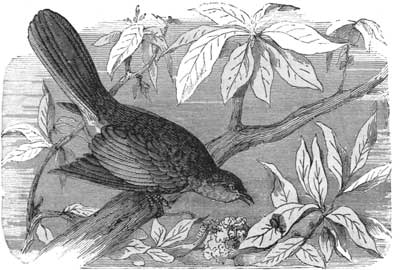 The Mocking-Bird.
The Mocking-Bird.
2. "What bird is that? Its song is good!"
And eager eyes
Go peering through the dusky wood,
In glad surprise.
Then late at night, when by his fire
The traveler sits,
Watching the flame grow brighter, higher,
The sweet song flits
By snatches through his weary brain
To help him rest.
When next he goes that road again,
An empty nest
On leafless bough will make him sigh:
[Pg 144]"Ah me! last spring
Just here I heard, in passing by,
That rare bird sing!"
3. But while he sighs, remembering
How sweet the song,
The little bird on tireless wing
Is borne along
In other air; and other men
With weary feet,
On other roads, the simple strain
Are finding sweet.
The birds must know. Who wisely sings,
Will sing as they;
The common air has generous wings—
Songs make their way.
H. H.
1. The weasel and its relations, the marten, the skunk, the ermine, the ferret, and the otter, belong to that class of carnivorous animals which, on account of their long, thin, worm-like bodies, are called vermin. They have the teeth peculiar to flesh-eaters, and most of them are unpleasantly familiar from the depredations they commit about the poultry-yard. On the other hand, they prove themselves useful in exterminating the more[Pg 145] troublesome pests of the house and farm. The fur furnished by their skins has for a long time been an important article of commerce and of domestic use.
2. The pine-marten, or American sable, is not a mischief-maker about the habitations of men and domestic animals, although it belongs to the weasel family. It is found and hunted for its superior fur, and abounds in its best conditions in the far north, where it inhabits the pine-woods, and seeks its prey chiefly on the branches of trees. The color of its body is orange-brown, and its legs and tail are nearly pure black.
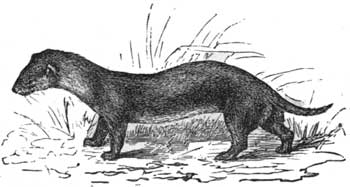 The Common European Weasel.
The Common European Weasel.
3. "The weasel is about eight and a quarter length, inches in not including the tail, which is about two inches more. The fur is soft, of a reddish brown on the back, head, and tail, but quite white on the throat and under part. The limbs are short and hairy to the extremities of the toes. Of the advantages accruing from the great flexibility of body possessed by the weasel when attacked[Pg 146] by superior enemies, Mr. Bell gives the following illustration:
4. "'A gentleman riding over his grounds saw, at a short distance before him, a kite pounce on some object on the ground, and rise with it in its talons. In a few moments, however, the kite began to show signs of great uneasiness, rising rapidly into the air, or as quickly falling, while it was evidently endeavoring to force some obnoxious thing from it with its feet. After a short but sharp contest, the kite fell suddenly to the earth, and a weasel ran away, apparently unhurt, leaving the bird dead, with a hole eaten through under the wing, and the large blood-vessels of the part torn through.'
5. "When a weasel enters a poultry-yard, it does not attack the cocks or old hens, but selects the chickens, kills them by a single wound on the head, and carries them off one after the other; it also breaks eggs and sucks them with incredible avidity. In winter it usually lives in granaries and barns, often remaining there in the spring to hide its young among the hay and straw. During this time it makes more successful war than the cat against rats and mice, because they can not escape it, as it enters their holes after them. It climbs and takes pigeons, and kills sparrows and other small animals.
6. "In summer it goes to some distance from dwelling-houses, and is found more especially in[Pg 147] low ground about mills, and along streams and rivers, hiding in the bushes to catch birds, and often takes up its abode in the hollow of an old willow to prepare for its little ones, making a bed of grass, straw, leaves, and fibrous plants. It produces its young in spring; sometimes three, usually four or five in number. The young ones are born blind, as are those of the skunk, marten, and stoat. In a short time, however, they become large and strong enough to go hunting with their mother.
7. "A French lady described to Buffon her tame weasel as playing with her fingers like a kitten, jumping on her head and neck; and if she presented her hands at the distance of three feet, it jumped into them without missing. It distinguished her voice amid twenty people, and sprang over everybody to get at her. She found it impossible to open a drawer or a box, or even to look at a paper, without the weasel examining it also. If she took up a book or a paper, and looked attentively at it, the weasel immediately ran upon her hand and surveyed with an inquisitive air whatever she happened to hold.
8. "The ermine is very nearly related to the weasel. Its length is about nine inches, exclusive of the tail. Its color in the summer-time is a beautiful brown above and yellowish white beneath, while the tip of the tail is black. In this condition it is called a roselet; but in winter the fur assumes a white color, and is then highly prized;[Pg 148] the black end of its tail, however, remains unaltered. These beautiful animals are met with in the northern regions both of Europe and America, where they are very destructive to small quadrupeds and birds, living indiscriminately upon rats, pigeons, or putrid meat; they are likewise said to be fond of eggs, and have been seen pursuing a young hare by the scent, tracking it with as much precision as a harrier. The change of color on the approach of winter, so conspicuous in the ermine, is common to many animals, birds as well as quadrupeds.
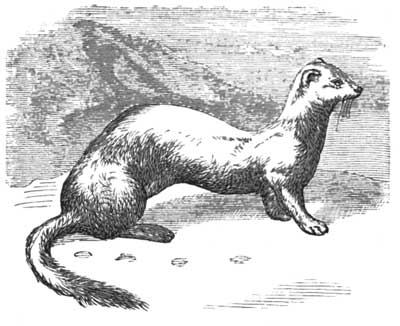 The Ermine in Winter Dress.
The Ermine in Winter Dress.
9. "On the unbroken snows of Siberia it would, in its summer hue, be conspicuously visible, and completely at the mercy of its enemies; whereas, in its winter garb of pure white, it is hidden from observation. Concealment, therefore, is one object[Pg 149] attained by the change. This, however, as Professor Bell well remarks, is not the only advantage gained by the assumption of white clothing in the winter season. It is well known that, although the darker colors absorb heat to a greater degree than lighter ones, so that dark clothing is much warmer than light-colored when the wearer is exposed to the sun's rays, the radiation of heat is also much greater from dark-colored than from light-colored surfaces, and consequently animal heat is more completely retained by a light than a dark covering.
10. "In the defense of their young, weasels have sometimes attacked man. 'I have knowledge,' says Dr. Abbott, 'of a man being attacked by several weasels, and badly bitten by them. Before he escaped from their fury, he managed to kill two of them, and I judged these at the time to be an adult male, and a young one of the summer just past. The man who passed through this novel experience believed there were "at least a dozen of them in all"; and I have no doubt but that it was a family of weasels that were then hunting or traveling in company.'
11. "The skunk is about the size of a cat, with a broad, robust body, standing low on the legs. Its fur is coarse, the hair long, the tail long and bushy; the claws on the fore-feet are long and very strong, suitable for digging. The color varies so much that it is rare to find two specimens[Pg 150] alike. It is found in the rocky and woody parts of North America. 'The skunk,' says Sir John Richardson, 'passes the winter in a hole, seldom stirring abroad, and then only for a short distance. It preys upon mice, and in summer has been observed to feed much on frogs; it has a slow gait, and can be overtaken without difficulty, for it makes but a poor attempt to escape, putting its trust apparently in its power of discomfiting its pursuers by the discharge of its noisome fluid.'"
12. It is interesting to know the pleasant relations existing between two not particularly popular animals as set forth in a story told by Dr. Abbott: "In June, 1863, I witnessed a terrific combat between a large skunk and a black-snake, which, I judge, measured fully five feet in length. The prowling skunk had evidently seized the snake by the tail and endeavored to give it a violent shake, as it would a little garter-snake. This angered the snake, and, turning like lightning, he wrapped himself about the skunk, completely encircling both neck and body. The head was so far free that the skunk could give the snake nip after nip, though it could not get a strong enough hold to disable it.
13. "Rolling over and over, hissing and snapping, the snake nearly concealed by the long hair of the skunk, the two creatures presented a strange spectacle as they struggled, the one to conquer, the other to escape. After watching them for[Pg 151] fully five minutes, I ventured to approach, and dealt the two a hard blow with a club, and then ran back a few paces, not knowing what might be the result. Turning about, I ventured to return part of the way to see whether the struggle continued. All was comparatively quiet, and, coming still nearer, I found that the snake had relinquished its hold and was slowly retiring in a disabled condition. The skunk was lying quite motionless, and proved to be dying, though not dead. Soon after, I examined the animal carefully, and found that it had been strangled, or nearly so."
14. The ferret belongs to the weasel family, and is about the size of the ermine or stoat. "It is kept for the purpose of dislodging rabbits from their warren. The ferret is also a great enemy to rats, and will not suffer one to remain alive when it is allowed to go in search of them. Although readily tamed, it seldom evinces attachment, and is easily intimidated. It emits an unpleasant odor, like all its tribe. Like the rest of the species, likewise, it is remarkable for the pertinacity with which it retains the bite which it has once taken. This circumstance is illustrated by the following occurrence: A man of the name of Isles, a bargeman, finding himself much incommoded by rats, procured a ferret to destroy them.
15. "The ferret remaining away a considerable time, he thought it was devouring some rats it had killed, and went to sleep, but was awak[Pg 152]ened early next morning by the ferret, who was commencing an attack on him. The animal had seized him near the eyebrow; and the man, after endeavoring in vain to shake him off, at length severed the body from the head with a knife—the latter still sticking so fast as to be with difficulty removed."
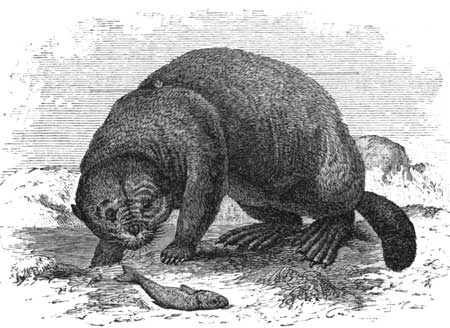 Sea-Otter. Showing the Front Paws, and the Hind Webbed
Feet.
Sea-Otter. Showing the Front Paws, and the Hind Webbed
Feet.
16. Another cousin of the weasel is the otter, whose eyes are small, neck long, legs short, and color dark, glossy brown. Otters have a singular habit of sliding down wet and muddy banks, as if for sport, and at these coasting-places hunters set their traps. The feet of the otter are webbed, and it is at home in the water, where it finds the chief article of its diet, fish. Otters have been tamed, and in this condition are trained to bring[Pg 153] their game to their masters. "The fact that otters admit of being taught to catch fish and bring them to their masters, shows no small degree of docility on the part of these animals. 'I have seen,' says Dr. Goldsmith, 'an otter go to a gentleman's pond at word of command, drive the fish into a corner, and, seizing upon the largest of the whole, bring it off in his mouth to his master.'"
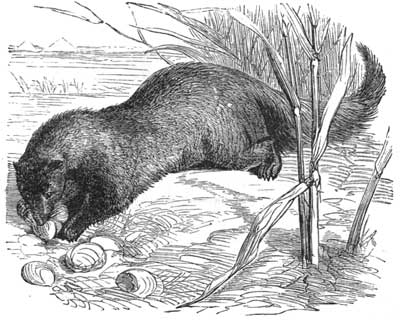 The Egyptian Ichneumon sucking Crocodile's Eggs.
The Egyptian Ichneumon sucking Crocodile's Eggs.
17. "The ichneumon, which is about the size of a cat, is chiefly known, and is highly valued in Egypt, for its agility and boldness in destroying serpents. In Egypt and India it is accordingly kept as a domestic cat. No animal has a stronger propensity for the destruction of life. It soon rids a house of rats and mice, preys upon every[Pg 154] reptile of the torrid zone, and frequently kills that fatal snake the cobra."
18. "In its conflicts with poisonous serpents, they sometimes bite the little creature, in which case, as is reported, it immediately flies to the root of a certain plant which is said to counteract the effects of the poison. This plant is called by the Indians after the animal. Mr. Percival saw an experiment tried in a closed room, where the ichneumon, instead of attacking a poisonous serpent that was presented to him, did all in his power to prevent it. On the snake being carried out of the house, however, and laid near his antagonist in a plantation, he immediately darted at and soon destroyed it. It then retired to the wood and ate a portion of that plant which is said to be an antidote to the serpent's bite."
1. The patient and industrious farmer plows, digs, plants, and hoes, to make sure of the crop which is to furnish him and his family with food. But he is beset with enemies on all sides, and his life is a perpetual warfare. The midge attacks his wheat, the Colorado bug feeds upon his potatoes, the curculio destroys his fruit, and swarms of[Pg 155] grasshoppers eat up every living thing. Little good would come of his labors were he not assisted by friends who help him on all sides. Parasitic insects feed upon the eggs of his foes, birds bag the bugs and scratch out the worms, and harmless toads and snakes catch and swallow the crawling and flying destroyers.
2. The ground is the breeding-place of many of these pests, and, deep in the soil, where neither the bill of the bird, the tongue of the toad, nor the sting of the ichneumon-fly can reach them, grubs live and thrive. They feed upon the roots of grass and grain until green fields turn to a sickly yellow from premature decay, and then they are ready to rise into the air and continue their destructive work above. But grub and worms are meat and bread for curious little animals which have the power of following them into their burrows and blind galleries. These are the moles and the shrews—"ground-mice," as they are sometimes called—found the world over.
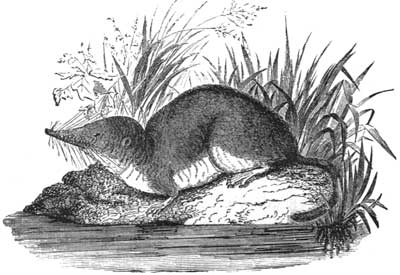 The Common Shrew.
The Common Shrew.
3. The mole has already been described. Without eyes and with imperfect ears, it has no place in the light and the air. Its instinct is to dig. Place it on the turf, and it disappears in less than a minute. Its paws are spades, and it passes through the soil with nearly as great ease as other animals along the surface. Its keen nose scents grubs, and its flexible tongue snaps them up in an instant. The trouble with the mole is that, while[Pg 156] it eats multitudes of worms, it also eats the corn and other seeds which have just been planted, and it is hard to convince the farmer that the mole is not a pest to be destroyed.
4. In England a common little insect-eater is the shrew. It is about the size of a mouse, and, unlike the mole, it lives above-ground and is furnished with eyes. It has a long, flexible nose, with which it roots in the ground, and searches for grubs in the densest herbage. It builds its nest in some hollow in the ground or hole in a bank, and is altogether a very pretty, harmless little animal, and an excellent friend of the farmer.
5. The water-shrew is amphibious, equally at home on land or in the water. It swims out to catch water-bugs, and it travels inland to nose out[Pg 157] grubs. Its fur is very soft and fine, and is so supplied with oil as to preserve the body from wet. In all its movements, whether on land or in water, it is extremely graceful.
6. Mr. Wood says: "When the water-shrew is engaged in swimming, those parts of the fur which are submerged appear to be studded with an infinite number of tiny silver beads, which gives to the animal a very singular aspect. This effect is produced by the minute air-bubbles that cling to the fur, and which exude from the space between the hairs.
7. "I have often watched a little colony of these animals within a yard or two of them without their seeing me. They are sportive little creatures, and seem to enjoy a game of play greatly; chasing each other over the ground and through the water, running up the stems of plants and tumbling off the leaves into the water, scrambling hastily over the stones around which the stream ripples, and playing a thousand little pranks with the most evident enjoyment. Then they will suddenly cease their play and begin to search after insects with the utmost gravity, rooting in the banks and picking up stray flies, as if they never had any other business in view."
8. In South Africa a very common shrew has a long, pointed nose, like the trunk of an elephant, and is hence called the "elephant shrew." Like the kangaroo, its hind-legs are much longer than[Pg 158] its fore-legs. By placing its plantigrade foot squarely upon the ground, it is able to sit up straight and hold itself in that position. Its long hind-legs give it great power in leaping, and when frightened its movements are like those of a jack-rabbit—a flash and a whiz, and the animal is out of sight. The long trunk is of great use in "nosing" out bugs.
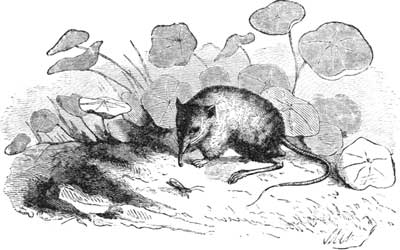 The Elephant Shrew.
The Elephant Shrew.
9. In England and other European countries the largest and most common of the insect-eaters is the hedgehog. This animal must not be confounded with the porcupine which is found in this country, and is generally called a hedgehog. The English hedgehog eats insects—our porcupine is a rodent, like the beaver and squirrel, and gets his food by gnawing the bark of trees. Like the por[Pg 159]cupine, the hedgehog is covered with sharp spines, and when attacked he rolls himself up, presenting an appearance of a ball of needles and pins with their points outward.
10. Besides protecting him from enemies, these spines or quills are useful to the hedgehog for other purposes. They are very elastic; and when he rolls himself up with his quills pointing outward, he is, in fact, in the midst of a thick cushion which protects him on all sides. A hedgehog has been seen repeatedly to throw himself from a wall twelve or fourteen feet high, striking upon the hard ground without in any way being hurt. On reaching the ground, he would unroll himself and trot off as if nothing had happened.
11. The home of the hedgehog is in some retired and protected spot, such as a crevice in the rocks, or a hollow under a heap of stones. He is very fond of hollow trees and of the vacant spaces under the roots of old trees. Here he builds a cozy nest, and here he sleeps during the entire winter, without waking or taking food. His hibernation is as perfect as that of a bear.
12. The legitimate food of the hedgehog is the insect tribe. These he consumes in vast numbers, being able not only to chase those which run upon the ground, but to dig in the earth, and feed upon the grubs, worms, and various larvæ which pass their lives underground. A hedgehog has been seen to exhume the nest of a bumble-bee, and to eat[Pg 160] bees, grubs, and honey, entirely unmindful of the anger of the survivors. It has a great liking for eggs, and has an ingenious method of eating them. He lays the egg upon the ground, holds it firmly between his fore-feet, bites a hole in the top, and, inserting his tongue, he licks out the contents. He is also a great destroyer of snakes, frogs, and other small animals, crunching them, together with their bones, as easily as a horse will eat a carrot.
 The European Hedgehog.
The European Hedgehog.
13. Mr. Wood says: "The hedgehog may be tamed and used as guardian to our kitchens, where it may be put in charge of the 'black beetles.' The rapidity with which it rids a house of cockroaches and water-bugs is marvelous, and shows that he has more speed and wariness than they. A hedgehog which resided in our house for some years had somewhat of a nomad existence; for as soon as it had eaten up all the cockroaches in one kitchen, it used to be loaned to friends for similar purposes, until his services were again needed at home.[Pg 161]
14. "The creature was very tame, and would come at any time to a saucer of milk in broad daylight. Sometimes it took a fancy to walk in the garden, when it would trot along in its own quaint style, poking its sharp nose into every crevice, and turning over every fallen leaf in its path. If it heard a strange step, it would curl itself into a ball, and lie in that posture for a few minutes until its alarm had passed away, when it would cautiously unroll itself, and peer about with its bead-like eyes for a moment or two, and then it would resume its progress."
1. In portions of South America and Africa ants are so numerous as to make the regions uninhabitable for man. The army ant of Africa and the driver ant of Central America march in columns miles long, and devour everything that has animal life which comes in their way. When the army invades a dwelling, the people flee for their lives. The fire ants of the Amazon burrow underground; but they are in such numbers that they have been known to take possession of whole villages and drive out the inhabitants. They not only eat everything that is eatable, but they at[Pg 162]tack human beings, and their bite is almost as painful as the sting of a wasp.
2. In some of the provinces of Brazil, vegetable-eating ants are in practical control of the country. The vegetation that is agreeable to them can be preserved by no human art, and the ants not only decide what the farmer must cultivate, but they also decide what kinds of plants must grow in the region. They become one of the potent forces in determining "natural selection." The white ants burrow, but they gnaw as well. They shun the light, and so eat their way into the inside of things as quickly as possible.
3. They invade a dwelling, and the timbers, the floor, the furniture, and everything that is made of wood is soon eaten out from the inside, leaving nothing but a thin outside shell untouched. A sudden wind-blast, or a heavy foot-fall, and the whole fabric collapses and is dust. Man stands a poor chance in a fight against these insects. Fire, poison, and gunpowder may keep them in check for a time, but their countless myriads at last triumph over any obstacle in their way.
4. But man has allies which, while serving him, serve themselves more directly. These are the ant-eaters, great and small, found in various parts of the world. The ant-eaters belong to the order of animals called Edentata, or toothless, and, although some of them have small back teeth, none of them have incisors on either the upper or lower jaw.[Pg 163] They all have long, pointed noses, and a tongue covered with a sticky saliva, which they can protrude to a great length. This tongue thrust into an ant-hill is soon covered with insects, the whole of which are scraped into the expectant mouth, and the trap reset for another mouthful.
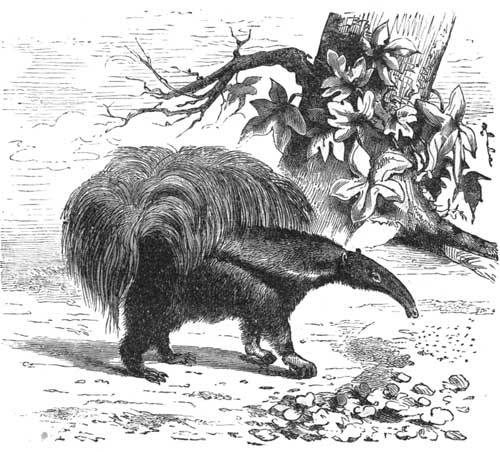 The Ant-Bear.
The Ant-Bear.
5. The largest of the ant-eaters is the great ant-bear of South America. Its body and head are about four feet in length, and the tail is about thirty inches more, if the long hair at the ex[Pg 164]tremity be included. The head itself measures about fourteen inches, and becomes exceedingly narrow toward the snout. The eyes are small, and shaded by naked lids; the fur is long, especially over the shoulders; the tail is bushy, and the hairs long and bristly. The general color of the animal is grayish brown. The great ant-eater generally inhabits low, swampy grounds, and is found frequently in dense thickets. It is unable to climb, and moves so slowly that it may easily be overtaken by a man on foot, and offers but slight resistance to its captor. The greater part of its life is passed in repose, the head being doubled under the chest, and the tail curved round so as to protect its body from the fierce heat of the sun. These animals are not numerous; they live on the ants that abound in the regions they frequent.
6. When the ant-bear meets with one of the tumuli constructed by the white ants, it immediately pulls the fabric down by means of its strong claws, and, when the ants are thus exposed, its long, slender tongue is thrust out to collect them. The movements of the tongue, as it is alternately protruded and retracted, are so rapid that it is no longer surprising how so large an animal can satiate its appetite with such minute insects. The ant-bear is, however, an economist, and does not destroy more than he wants. When he finds the termites diminish on the surface, as every one[Pg 165] seeks to escape in the numerous galleries of the ruined edifice, he uses his left foot to hold large lumps of the nest, while with the right he leisurely pulls them to pieces.
7. The ant-bear makes neither nest nor burrow, its ample tail serving as its sole protection against the inclemency of the weather. One of its favorite positions when at rest is to tuck up its feet under its belly, and bring its two extremities almost close together, in which position the tail covers the whole animal; at other times it gathers itself up like a dog, and the tail covers only the snout and part of the body.
8. Dr. Schomburgh had a young ant-bear in his possession; by its power of smell it would discover its nurse or any person for whom it had a liking at a considerable distance. It climbed expertly; and, while Dr. Schomburgh was writing, would come softly behind him and climb up his legs with great dexterity. When its Indian nurse was too busy to pet it, she would throw it her blanket, or some of the clothes she had worn, in which it wrapped itself and was pacified; it was very sportive and gentle, and became highly prized.
9. The mouth of the ant-eater is quite toothless. The jaws are of great length, giving to the animal an extremely bird-like expression; and the movements of the lower mandible, when the animal is feeding, may be clearly traced beneath the skin which covers the face. In its slow and meas[Pg 166]ured walk, the tail is stretched out in a straight line with the back, and the animal then presents a length of between six and seven feet, of which the head occupies one foot and the tail three. It cleans its face and little mouth by rubbing them with the knee-joint, slightly bent for that purpose; the viscid saliva and adhesive nature of its food rendering some such operation a matter of continual necessity.
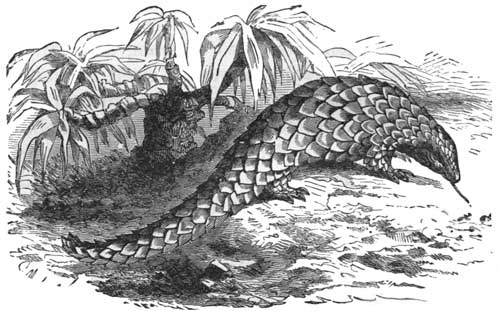 The Short-tailed Pangolin.
The Short-tailed Pangolin.
10. The phatagin, or pangolin, is an ant-eater of Africa, where it passes under the name of the "ipi." Du Chaillu gives the following description of it: "The pangolin genus, to which the ipi belongs, is a very singular group of animals. They are ant-eaters, quite destitute of teeth, and having a long, extensile tongue, the extremity of which is[Pg 167] covered with a glutinous secretion, by means of which they catch their prey. But while the South American ant-eaters are clothed with hair like the ordinary mammalian animals, the pangolins have an armament of large scales implanted in the skin of the upper surface of the body, from the head to the tip of the tail, and imbricated, or overlapping, like the slates on the roof of a house. The animals look at first sight like curious, heavy-bodied lizards; but they have warm blood, and nourish their young like the rest of the mammalia. The ipi lives in burrows in the earth, or sometimes in large holes of colossal trees which have fallen to the ground.
11. "The burrows that I saw were in light soil on the slope of a hill. There are two holes in each gallery; one for entrance, and another for exit. This is necessary on account of the animal being quite incapable of curving its body sidewise, so that it can not turn itself in its burrow. The bodies of the pangolin are very flexible vertically; that is, they can roll themselves up into a ball, and coil and uncoil themselves very readily, but they can not turn around within the narrow limits of their burrows.
12. "In hunting them, we had first to ascertain by the foot-marks, or more readily by the marks left by the track of the tail, which was the entrance and which the exit of the burrow, and then, making a trap at one end, drive them out by the[Pg 168] smoke of a fire at the other, afterward securing them by ropes. The freshness of the tracks told us that the animal had entered its burrow the preceding evening; for I must add that the ipi is nocturnal in its habits, sleeping in its burrow throughout the day. When it wanders at night, the natives say they can hear the rattling of its large scales."
13. Tennant captured and tamed this animal in Ceylon. He says: "Of two specimens which I kept alive at different times, one, from the vicinity of Kandy, about two feet in length, was a gentle and affectionate creature, which, after wandering over the house in search of ants, would attract attention to its wants by climbing on my knee, laying hold of my leg by its prehensile tail. I had always understood that the pangolin was unable to climb trees, but the one last mentioned frequently ascended a tree in my garden in search of ants, and this it effected by means of its hooked feet, aided by an oblique grasp of the tail. The ants it seized by extending its round and glutinous tongue along their tracks. Generally speaking, they were quiet during the day, and grew restless as evening and night approached."
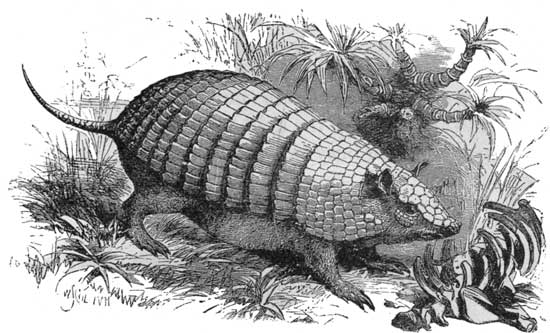 The Armadillo.
The Armadillo.
14. The armadillo is a small armor-plated animal like the phatagin. It is found in Central and South America. It is an ant-eater, but also feeds on worms, fruits, small reptiles, and carrion. It is nocturnal, sleeping in its burrow during the[Pg 169] day, and coming out at night in search of food. When pursued it makes hastily for its burrow, but if unable to gain it, or to dig a temporary retreat, it partially rolls itself into a ball, and allows itself to be turned about by its enemy without attempting to move. The nine-banded armadillo, we are told, in Nicaragua is kept not only by the people of the ranchos, but by the inhabitants of some of the little towns, to free their houses from ants, which it can follow by the smell. When searching for ants about a house, the animal puts out its tongue and licks the ants into its mouth from around the posts on which the houses are raised a little above the ground. It has been known to dig down under the floors, and remain absent for three[Pg 170] or four weeks at a time. "When burrowing," says Audubon, "this species makes a slight squeak, quite faint, however. They are said to dig down in a straight direction when they discover a subterranean colony of ants, without beginning at the mouth or entrance of the ant-hole." They are very persevering when in pursuit of ants, and, while they turn up the light soil with the mouth, keep the tongue busy taking insects.
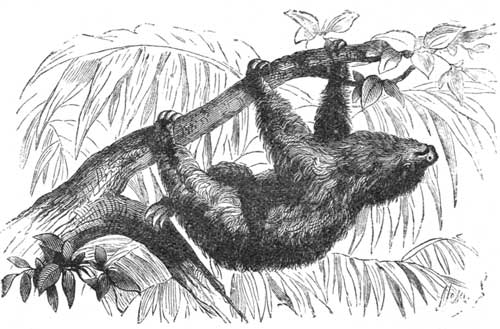 The Sloth.
The Sloth.
15. The sloth is another member of the "Edentata," although not an ant-eater. It is a tree-climber, but it hangs suspended from the under side of a branch instead of resting on top. Its food is the leaves of trees. It is so constructed that it moves slowly and with difficulty on the ground,[Pg 171] and hence the name "sloth." But upon the trees and in the thick forests its motions are quick and its rate of progress rapid. A full description of this animal is given in Book V.
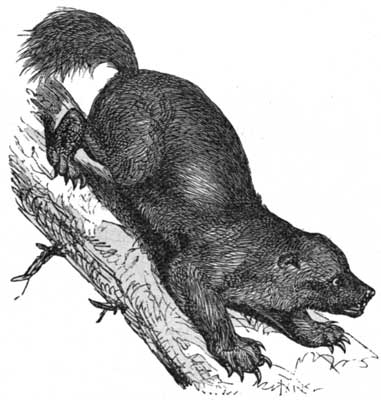 The Glutton, or Wolverine.
The Glutton, or Wolverine.
1. The bear is not the only dweller of the wilds that shuffles along with the whole foot planted squarely upon the ground. His plantigrade cousins are numerous, though many of them are his kin in little besides their manner of walking. The plantigrades are not so savage as the wolves and cats of the wilds, and some of them are quite harmless and are easily tamed.
2. The member of this family that has the worst reputation is the wolverine, or glutton. This animal is an inhabitant of the[Pg 172] cold regions of Europe and America. It is about two and a half feet long, with a large body, short, bushy tail, and stout legs, armed with long nails. It has a pointed nose, strong jaws, and sharp teeth. If we could think of a weasel that had suddenly grown to about three times the size of a large cat, and still retaining all the features of a weasel, we should get a pretty good idea of the form of the wolverine.
3. Its name "glutton" comes from its great voracity. An old Swedish writer declares that "if the glutton finds a carcass six times as big as itself, it does not leave off eating while a mouthful is left." Another writer asserts that "the glutton squeezes itself between two trees in order to get rid of the contents of its stomach, so that it may eat again."
4. While these stories may not literally be true, they express very accurately the character of the animal. It seems always hungry, is ever ready to eat, and remains forever a glutton. It feeds chiefly upon the carcasses of beasts that have been killed by accident. It catches meadow-mice, rabbits, and woodchucks. It is very destructive of martens and beavers, and is of great annoyance to trappers who are in pursuit of the fur-bearing animals. The wolverine follows around from trap to trap, eating the bait, and tearing in pieces the animals caught.
5. It never faces a man, and is easily killed by[Pg 173] a blow from a good-sized cudgel. The European glutton climbs trees, and lies in wait for the reindeer which come to graze below. It pounces down upon the back of one of them, and in vain the wounded deer tries to shake it off by rushing through the trees. It clings till its victim falls exhausted with pain and fatigue.
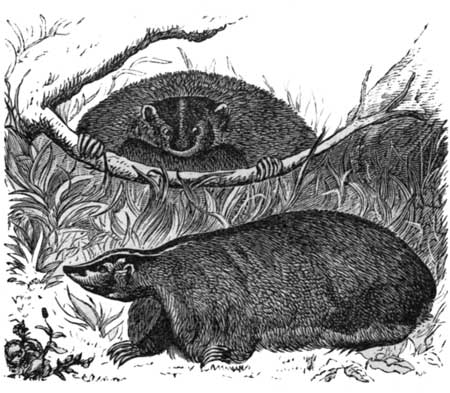 The American Badger.
The American Badger.
6. The badger is the little brother of the bear in form and feature. It is somewhat smaller than the wolverine, but has similar short legs and tail. Its coat of hair is of a sandy gray above and of a jet black below. It feeds upon mice, small animals of all kinds, roots, fruit, and honey. Unlike the glutton, it is not voracious, and it can live for weeks without food. It digs burrows in the ground, where it passes most of the time during the day, coming out at night in search of food. It is found in the northern half of America, Europe, and Asia. When taken young, the badger is easily tamed, becoming as familiar as a dog. It is very cleanly in its habits,[Pg 174] and will desert its burrow when any kind of filth gets into it. In England and Scotland a badger-hunt with dogs is considered a great pastime.
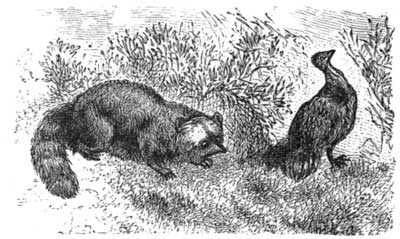 The Raccoon.
The Raccoon.
7. A still smaller member of the long-footed family is the raccoon, or the "coon," as it is commonly called. The coon is about twice the size of a large cat. Its coat is a grayish-brown fur mingled with long black hairs. Its food consists of mice, frogs, and all sorts of small animals and insects. It is especially fond of young chickens and roasting ears of corn, and its depredations upon farmers are sometimes serious.
8. A coon-hunt is a great event with the negroes of the South. It takes place in the night, when the coon is out in search of its nightly rations. The hunters assemble with torches and dogs, and when the coon is discovered all is scramble and confusion. The coon runs for dear life and takes to a tree, where he crouches upon a high branch. The dogs bark, the negroes jabber and yell, and the torches flare and toss up and down like restless spirits. An old hunter climbs the tree and peers about until he sees the coon where he is desperately hugging the limb upon which he[Pg 175] is perched. A vigorous shake breaks his hold, and he drops down among his enemies.
9. But the coon does not tamely surrender. The dogs find to their sorrow that he has sharp teeth, strong jaws, and a motion marvelously quick. The excitement is now at its height. The dogs rush in, are bitten, and retire howling. The negroes are frantic in setting on the dogs and in endeavoring to hit the coon. In the scramble heads are broken and shins hit, and yells of pain mingle with the musical chorus. At last an old experienced coon-dog watches his opportunity, seizes the victim by the neck, and shakes his life out. Frequently the coon escapes, and is foxy enough to get away from his pursuers altogether.
10. Several small plantigrades of the tropical regions have been tamed, becoming pleasant household pets. Among these are the coati-mondi, from South America, with its sharp nose and nimble legs, of which Mr. Lockwood has given such an interesting account. This little animal seems to have had a curiosity which can never be satisfied, and many a sad experience did it have from the claws of the cat, the teeth of the dog, the sting of a wasp, and the scald of a hot cup of coffee. Frank Buckland gives the following account of his pet Jemmy, a pretty little "Suricate" from Africa, a cousin of the coati-mondi.
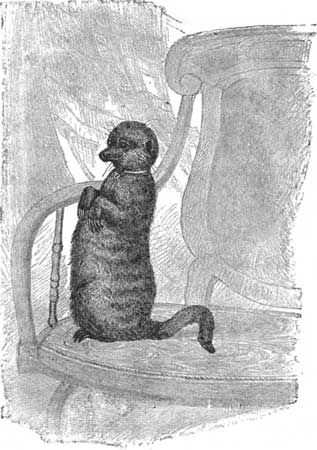 Jemmy.
Jemmy.
11. "In the engraving now presented to you, dear reader, you will see a portrait of one of the[Pg 176] prettiest, most good-tempered, amiable little animals that was ever made a pet of in a London house. Poor little Jemmy can not, unfortunately, speak. If he could, he would say: 'I am a poor little Suricate. The learned men called me a zenick; and I have a relative stuffed in the British Museum, and you will see his Latin name appended—Suricata zenick—to his mummy-like carcass. I was born in Africa; can't recollect exactly how or where. The first thing I remember was being nursed and fed by a woman; but she was not white, like the ladies who are now so kind to me; her hair was in little tufts; she had great thick lips, and she did not wear what I now know to be a chignon—by the way, a chignon makes a capital bed. I then recollect coming across the sea in a nasty, stuffy box,[Pg 177] very different from the nice warm cage I have now. I assure you I don't want to go back to Africa.'
12. "Anyhow, I am writing about little Jemmy; there he sits bolt upright, looking at me with his beautiful little black eyes and inquiring face. A clergyman friend comes in to see the new arrival. 'Mr. Adams wants to see the prairie-dog,' says the faithful 'buttons,' John. (Note.—John is an excellent servant, very fond of animals, and gives them their food regularly.) 'Why is the little animal called a dog?' says Mr. Adams. 'Dog,' I answered, 'because he is not a dog.' He might as well have been called a prairie-cat. He never saw a prairie in his life, and he is not a dog, and certainly not a cat. Yet the lady who gave him to me called him a prairie-dog. The books call him a Suricate.
13. "The kind lady who gave me little Jemmy was unwilling he should spend his life in a cage in the Zoölogical; so she offered him to me, and, of course, I took him. Jemmy is now master of the house; he runs up and down just whenever he likes and how he likes. He lives on the principle of 'early to bed and early to rise.' When the sun goes down he 'turns in' like a sailor at sea. His cage-door is always open, and he goes in and sleeps when he likes; and, poor little fellow, how he does sleep! No moving; no dreams. He looks like a ball of fur. I wish I could sleep[Pg 178] on like Jemmy. He can't have a conscience, or he could not sleep like that.
14. "When he first arrived, Jemmy had to fight his way into favor with the establishment. First of all he had to make peace with the 'Old Hag.' Now the 'Old Hag' is my pet monkey that has lived in my study for seven years, and a dear, vicious old thing she is. The Old Hag, in a most dignified manner, received Jemmy, after his credentials had been duly examined. Not so Tiney, the Old Hag's fellow-monkey. Tiney watched her chance, caught Jemmy's tail, and pulled it into the cage till Jemmy cried murder. Then came the two dogs. 'Old Danny,' of royal canine Windsor descent, bolted. She is half blind with age, but she will not wear spectacles. 'Jacky,' her son, barked and bolted also. 'Molly-dods,' the French cat, was sitting on the kitchen table, 'prospecting.' She was fool enough to come down off the table, and little Jemmy hunted the lot of them, with his tail cocked high up in the air. The dogs retired into the copper fireplace; the cat went up the chimney. Jemmy then tried to eat the old poll-parrot. He is naturally avivorous, but Polly watched, ruffled up her feathers, and looked out of one eye, till at last she gave Master Jemmy such a peck on his inquisitive little wet black nose that he never goes near Polly's cage now.
15. "Jemmy is very fond of warmth, and he[Pg 179] always sits up—in the chair, if he can—to warm himself. In this attitude he looks wonderfully pretty: he keeps turning his head, listening to the slightest noise, while he hangs his paws on his breast after the manner of an awkward charity child who does not know her lesson. When the morning sun pours into the window, Jemmy manages to get on to the dressing-table, and he sits up earnestly looking out of the window. What he is looking for, I can't tell, but, if called, he will just turn his head for an instant, and then look again up and down the street like a young man waiting for his sweetheart. In the afternoon Jemmy goes to the other window, and, if there is a bit of sun coming in, Jemmy will go and 'sit in the sun,' according to reports received from John on my return home from official duties. One day there was a shriek and a cry of alarm from Mrs. Buckland, to whom Jemmy is devotedly attached, and she to him. I rushed up-stairs. 'Whatever is the matter?' 'Oh, dear! oh, dear! Jemmy's tail's on fire!' Jemmy had been sitting too close to the fire, and a hot cinder did the Guy Fawkes for him.
16. "One day John brought Jemmy up to me decidedly ill. He spun round and round on the floor like a mad thing. 'Poor little fellow,' I said, 'what's the matter?' So I nursed him, and he grunted his gratitude. I had up all the servants and took evidence. It appears that Jemmy had[Pg 180] gone out into the garden—a London garden—out of the open window. I saw my neighbor's gardener working, and at once thought he had struck him. On inquiry, the man, who was very civil, assured us that he had never struck Jemmy at all, but as he was digging the ground Jemmy followed him, and had eaten seven huge lob-worms right off one after the other. O tempora, O mores! Enough to make anybody ill, I thought. So I brought my professional knowledge to bear, and 'Jemmy was himself again' in spite of the 'diet of worms.' Long live little Jemmy!"
1. The opossum, or Virginia opossum, as it is called, is the only representative in North America of the marsupials, or pouched animals. The pouch, it must be understood, is a folding together of the loose skin of the abdomen so as to form a kind of pocket, in which the mother carries and protects her young. "With the general proportions of the common rat," says "The Popular Science Monthly," "almost the size of the domestic cat, it presents rather a disagreeable appearance and odor. A dense coat of light-gray wool, with scattered hairs interspersed, covers the body, while[Pg 181] the short ears, the eyes, the long, pointed nose, the feet, and tail, are colored quite dark. Among the trees it manifests astonishing agility, climbing or swinging from branch to branch with perfect safety, and may be seen hanging by one or more of its feet, or by its tail alone, while busily engaged gathering and eating wild grapes, or robbing birds' nests of their eggs or young."
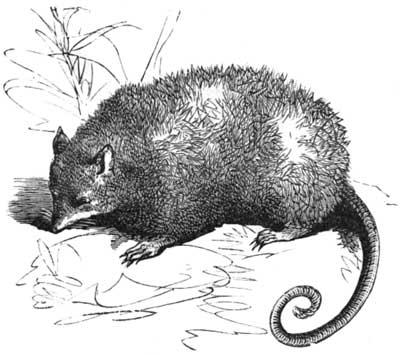 The Common Opossum.
The Common Opossum.
2. "Methinks," says Audubon, "I see one at this moment slowly and cautiously trudging along over the melting snow, by the side of an unfrequented pond, nosing, as it goes, for the fare its ravenous appetite prefers. Now it has come upon the fresh track of a grouse or hare, and it raises its snout and snuffs the keen air. It stops and seems at a loss in what direction to go, for the object of its pursuit has either taken a considerable leap or has cut backward before the opossum entered its track. It raises itself up, stands for a while on its hind-feet, looks around, sniffs the air, and then proceeds. But now at the[Pg 182] foot of a noble tree it comes to a full stand. It walks around the base of the large trunk, over the snow-covered roots, and among them finds an aperture, which it at once enters.
3. "Several minutes elapse, when it reappears, dragging along a squirrel, already deprived of life, with which, in its mouth, it begins to ascend a tree. Slowly it climbs; the first fork does not seem to suit it, for perhaps it thinks that it might be then too openly exposed to the view of some wily foe, and so it proceeds until it gains a cluster of branches intertwined with grape-vines; and then, composing itself, it twists its tail round one of the twigs, and with its sharp teeth demolishes the unlucky squirrel, which it holds all the while in its fore-paws.
4. "But suppose the farmer has surprised the opossum in the act of killing one of his best fowls, his angry feelings incline him to kill the poor beast, which, conscious of its inability to resist, rolls off like a ball. The more the farmer rages, the more reluctant is the animal to manifest resentment. At last, there it lies, not dead, but exhausted—its jaws open, its tongue extended, its eye dimmed; and there it would lie till the bottle-fly should come to deposit its eggs, did not the tormentor at length walk off. 'Surely,' he says to himself, 'the beast must be dead!' But no, reader, it is only ''possuming'; and no sooner has its enemy withdrawn, than it gradually[Pg 183] gets on its legs and once more makes for the woods."
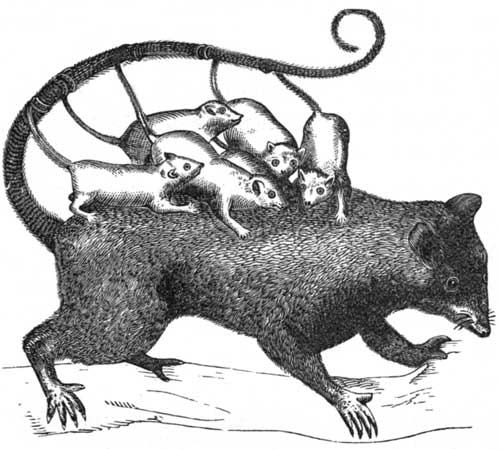 Merian's Opossum, with Young.
Merian's Opossum, with Young.
5. In foreign lands there are many marsupials, among which is the wombat of Van Dieman's Land and Australia. "The wombat," says Mr. Bass, "is a squat, thick, short-legged, and rather inactive quadruped. Its figure and movements strongly remind one of those of the bear. Its pace, too, is hobbling or shuffling, and not unlike the awkward gait of that animal." The bandicoot is found only in Australia. It has much the appearance of a rat, lives in burrows, and feeds upon small animals, insects, and roots. It is smaller than the rabbit, and is regarded as a great deli[Pg 184]cacy for the table. A marsupial has been found in Queensland no larger than the common mouse.
6. The dwarf phalanger of Van Dieman's Land is a small, pouched animal with soft, thick, dark fur and a prehensile tail like that of our opossum. It rests and sleeps during the day, and hunts its nuts and other food by night. In New South Wales is found the long-tailed flying phalanger, characterized by the same general habits, but living chiefly in the tops of trees, and passing from tree to tree in the manner of the flying squirrel. The spotted dasyure, or Tasmanian devil of Van Dieman's Land, is about the size of the badger, and is the enemy of poultry and sheep. The largest of the carnivorous marsupials is the Tasmanian wolf, nearly the size of the common wolf, but with shorter legs.
7. Varieties of the phalangers and flyers are found in Australia, as is also the koala. It is larger than the cat, dark-red, and tailless. It is easily tamed, and shows strong personal attachment and superior intelligence. The pouch is small, and when the young leaves it, it clings to its mother's neck. Mr. Niccols describes a young koala which he placed among a family of kittens to be nursed by the cat. The latter received her new charge kindly, and it thrived well, but "pussy" was destined to an altogether new experience in nursing, for, whenever she moved, the koala clung to her most pertinaciously.[Pg 185]
8. "She ran about the house, with this pigmy Sinbad sticking to her back, in a state of agitation and astonishment most comical to behold, rolling over and over in her attempt to get rid of her burden. But an animal accustomed to be carried on its mother's back through the dense foliage of an Australian forest was not to be shaken off, and the cat, though grievously inconvenienced, never resented the pain which the sharp nails of its adopted child must have inflicted by scratching or biting it. Side by side lay the kitten and the koala, drinking at the same fountain, and being licked and caressed by the cat with the utmost impartiality. But feline and marsupial milk are very different in character, and on the third day this interesting relationship was severed by the death of the koala, to the great regret of all who witnessed the cat's solicitude for this waif of the Australian bush."
9. The kangaroo of Australia is the most prominent of all the marsupials. Its diminutive fore-legs, its long hind-legs, and immense tail, as well as its queer attitudes, have made it an interesting animal. The average weight of an adult kangaroo is one hundred pounds. The wallaby is a smaller species, and there are, besides, rock kangaroos and kangaroo rats. On account of the decrease in the native population, and the killing of the dingoes, both of whom were its natural enemies, the kangaroo multiplied prodigiously, and[Pg 186] became a dreaded pest. One animal would eat as much grass as two sheep, and it would also destroy the grass for the sake of the roots. Hence, to protect the industry of sheep-raising, the Government offered a bounty for kangaroo scalps, and this reward stimulated the battue, or kangaroo hunt, a spirited sketch of which is given by Mr. Inglis:
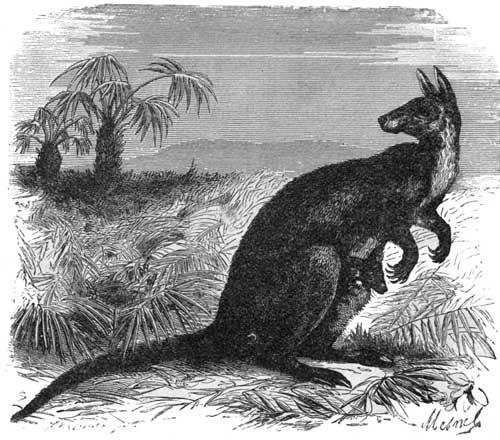 The Great Kangaroo.
The Great Kangaroo.
10. "The silence is almost depressing. Occasionally your horse behind the line kicks up the[Pg 187] gravel, or a stray shot at some solitary kangaroo, unconscious of your proximity, breaks the stillness for a moment; but, as a rule, the utmost quiet prevails. There is no distant
11. "'Boom of the waterfall far in the forest land';
no chirping of birds; no lowing of kine; nought is heard but the low sighing of the gentle breeze among the green trees. A flock of magpies or parrots may dart past, or a silent little bird flit rapidly by; but otherwise no sight or sound of animated life breaks on the eye or ear. You are hovering on the confines of dream-land, when, lo! the first faint crack of the distant whip, the first faint far-distant halloo. The sound electrifies you. You grasp your gun, strain your ear to catch the slightest sound, and eagerly peer forth to see if the expected victims are approaching.
12. "The sounds slowly and gradually draw near. Then 'an old man,' a veritable tough, old, bounding brigand, jumps slowly past you, along the ridge, just keeping beyond range. After him comes a black wallaroo. He is coming right up to you, when your next neighbor, with his far-reaching gun, levels his deadly hail, and over rolls the wallaroo, taken from your very teeth. Now they appear in twos and threes over the ridge. You have ample time to watch their every motion; they cock their ears for the sounds of the beaters behind, leisurely lick their fore-paws, nib[Pg 188]ble at a tuft of grass, and then jump on a few paces farther. Crack! goes the gun to your right; over topples a flyer; the rest hop about in truly comical bewilderment.
13. "One comes your way. Bang! goes your piece, and you score your first kangaroo. The rest, now fairly frightened, bound along, and the guns go Bang! Bang! down the line as each shooter gets his chance. Like an advancing flood, the tide of kangaroos flows swiftly on. You can not fire fast enough. Before, behind, on every side, the bounding forms go swiftly past. All is noise, bustle, mad excitement. No time now to watch your neighbor. On they come, faster and faster. Suddenly you hear a faint, subdued thump, thump. A solitary 'old man' kangaroo, all unconscious of danger, is approaching you at a steady pace. The echoes of the rocky hills ring again as you discharge your piece, and the kangaroo topples over before you, scattering the stones, dried sticks, and leaves.
14. "Far to the right another shot echoes back your own. Everyone is now on the alert. Shots ring out at intervals. On the slope before you, and along the crest of the ridge, you see numbers of marsupials, in groups, in clusters, and in dusky lines, hopping about in comical confusion. The cries and shouts of the beaters, the cracking of the stock-whips, and thunder of horse-hoofs, now come to your ears, carried by the wind[Pg 189] over the ridge. There is a rush of frightened animals past. On come the lines of kangaroos without cessation. You are now fairly warming to your work; you are getting your eye in; you glance at your neighbor. You fire to right, to left, front and behind, as some terrified flyer breaks the lines. Occasionally a sharp patter of shot against your tree, or overhead, cutting off twigs or leaves, reminds you that your neighbor is not very mindful of his line of fire, and that the element of danger is not wanting to the sport."
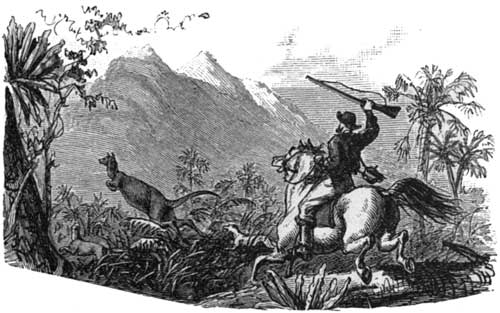 Hunting the Kangaroo.
Hunting the Kangaroo.
1. The whale is not a fish, although it swims, lives in the element of the fish, and is fish-like. It belongs to the class of quadrupeds and milk-givers. It is true that it possesses but two legs or arms, its hind-legs being undeveloped. But it breathes the air, is warm-blooded, and brings forth its young alive, and not through the hatching of eggs. Of the large whales there are two species, the whalebone-whale and the sperm-whale. The former have no teeth, and the latter have teeth only in the lower jaw. These animals are surrounded by a great amount of fat, or blubber, as it is called, which serves to protect both against cold and injury from enemies.
2. The whalebone-whale is found only in the northern seas. It feeds upon the most minute marine animals, which move in immense shoals many square miles in extent. The mouth of this animal may be imagined when it is said that the lower jaw makes an arch high enough for a man to pass under on horseback. To the roof of this mouth is attached the hard substance we call whalebone. It is arranged in the form of a grate, and constitutes an immense sieve, which catches the food referred to. The sperm-whale contains more blubber and no whalebone. This fat lies[Pg 191] chiefly in the enormous head, which forms about one third of the whole body. "It is impossible from any description," says a writer, "to form any clear idea of the magnitude or shape of the whale; nor can we be made to comprehend it by any familiar comparison. The hugest beast by its side makes little more impression than the tiny mouse; for the largest-sized whales have within themselves the fat, the bone, and the muscle of a thousand head of cattle.
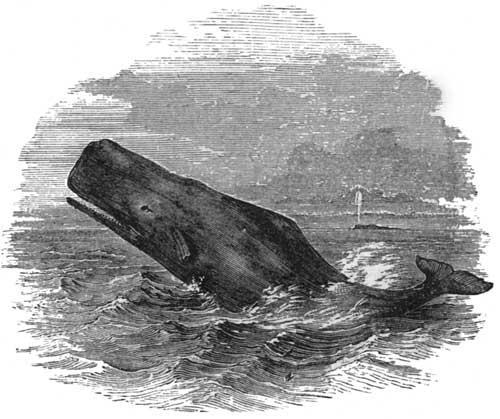 The Sperm-Whale.
The Sperm-Whale.
3. "Sporting upon the surface of the ocean, it is as graceful as the trout of the mountain stream; it skims along the water with rapidity; it disports in the sun; it stems the mountain wave;[Pg 192] and, in its joyous exultation, leaps into the air; but, like the hull of the noble ship, if stranded upon the shore, it becomes a wreck in form, helpless, and totally unlike the thing it was in life. The family of the cetacea are wonderful for their swiftness in the water, and yet their sole propelling power is in the tail. Unlike the fish, instead of being perpendicular, this important member lies horizontally upon the water, and is used with an up and down motion, instead of from side to side. It not only drives the animal through the water, but is its weapon of defense. The ordinary speed of the whale is ten miles an hour, but when alarmed he will go fifteen.
4. "The whale rarely brings forth more than one young at a time, which the mother nurses with the greatest care, even after it has attained the length of thirty feet. At its birth the 'calf' is twelve feet long and weighs a ton. The intense affection displayed by the cow-whale for its progeny has ever been the theme of admiration. Captain Scoresby relates that, having struck a calf, in hopes of securing the mother, a plan often most cruelly pursued, she rose and wrapped her fins, or rather 'flippers,' around it, as a mother would fold her child in her arms, and instantly dived, dragging about a hundred fathoms of line from the boat.
5. "Suddenly she came to the surface, furiously darting to and fro, and charging in every[Pg 193] direction, exhibiting all the while the signs of the most intense agony and solicitude. For some time she thus continued to act, and, although closely pursued by the boats, her care for her young made her entirely regardless of the danger that menaced on every side. After several fruitless trials, she was finally harpooned, but even then, in spite of her sufferings, she made no effort for her own protection, but clung to her young until the cruel harpoon put an end to her solicitude by death.
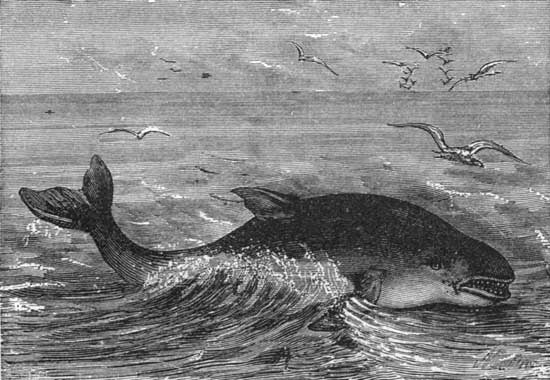 The Porpoise.
The Porpoise.
6. "To the cetacea, or whale family, belong the dolphin, the porpoise, and the narwhal. The dolphins have had the fortune of being idolized by the poets, and at the same time they have been cruelly distorted by the painter and sculptor.[Pg 194] Their length varies from six to ten feet, and they are among the most expert swimmers of the sea. The porpoise is quite familiar, as it frequents the bays and inlets of our coast. It is active, fleet, and voracious. When the shoals of herring and other fish periodically visit our shores, they are harassed by the porpoise, which at these times revels in a perpetual feast. Their momentary appearance above the surface of the water is for the purpose of breathing; this accomplished, they plunge down again in search of food."
7. The narwhal is an inhabitant of the Arctic seas, and is from twenty to twenty-five feet long, with a beautifully marbled skin, and a small, toothless mouth. Its most remarkable feature is a single tooth or horn that runs out from the head in a line with its body to the length of eight to ten feet. This horn is not only capable of piercing the body of the whale, but has also been known to drive through the oaken side of a British man-of-war, mistaking the ship, it may be, for a living whale. It has been thought by some that the narwhal's horn is used to break the ice which in some cases may obstruct its access to the air which is necessary to its life.
8. The capture of the whale always produces a scene of great excitement. When the leviathan is first sighted by the watch, the cry "There she blows!" brings all on deck. The whale, on seeing the approaching danger, dives below the surface,[Pg 195] and swims for a long time and a long distance, the time often reaching an hour and twenty minutes. But with each individual the time under water is so regular and exact that the whaler can depend on it to a minute.
9. Mr. Beal gives an interesting narrative of such a scene, the whale having plunged beneath the surface on seeing his pursuers, consisting of four rival parties: "True to his time, the leviathan at length arose right ahead of the boats, and at not more than a quarter of a mile distant from them. The excitement among the crews of the various boats when they saw his first spout was tremendous; they did not shout, but we could hear an agitated murmur from their united voices reverberating along the surface of the deep. They flew over the limpid waves at a rapid rate; the mates of the various boats cheered their respective crews by various urgent exclamations.
10. "'Swing on your oars, my boys, for the honor of the Henrietta!' cried one. 'Spring away, hearties!' shouted another, and yet scarcely able to breathe from anxiety and exertion; 'It's our fish!' vociferated a third as he passed the rest of his opponents but a trifling distance. 'Lay on, my boys!' cried young Clark, our first mate, as he steered the boat with one hand and pressed down the after-oar with the other; 'she'll be ours yet; let's have a strong pull, a long pull, and a pull all together!' he exclaimed, as he paused from[Pg 196] his exertions at the after-oar, which brought up his boat quite abreast of the foremost.
11. "But the giant of the ocean, who was only a short distance before them, now appeared rather 'gallied' or frightened, having probably seen or heard the boats, and, as he puffed up his spout to a great height and reared his enormous head, he increased his speed, and went along quite as fast as the boats, but for only two or three minutes, when he appeared to get perfectly quiet again, while the boats gained rapidly upon him, and were soon close in his wake. 'Stand up!' cried young Clark to the harpooner, who is also the bow-oarsman; while the same order was instantly given by his opponent, whose boat was abreast of our mate's, with the rest close to them. The orders were instantly obeyed. The monster plunged through the main quickly, but the boats gained upon him every moment, when the agitation of all parties became intense, and a general cry of 'Dart, dart!' broke from the hindmost boats, who urged their friends, fearful of delay.
12. "The uproar became excessive, and while the tumult of voices, and the working and splashing of the oars, rolled along the surface of the deep, both the harpooners darted their weapons together, which, if they had both struck the whale, would have originated a contention between them regarding the claims. But, as it happened, neither of them had that good fortune; for, at the mo[Pg 197]ment of their darting the harpoons, the whale descended like a shot and avoided their infliction, leaving nothing but a white and green looking vortex in the disturbed blue ocean to mark the spot where his monstrous form so lately floated.
13. "Our captain, feeling irritated at the ill-success of the mate, now ordered his own boat to be lowered, intending to make one in the chase himself; but, just as he had parted from the ship, a tremendous shout arose from the people in our own boats, joined with a loud murmuring from the rest of the boats' crews; for the whale, not having had all its spoutings out, had now risen to finish them, and was coming to windward at a quick rate right toward our ship. The captain saw his favorable situation in a moment, and stood to waylay him as he came careening along, throwing his enormous head completely out of the water. He soon came, and caught sight of the boat just as he got within dart. The vast animal rolled himself over in agony of fear, but it was too late; the harpoon was hurled with excellent aim, and was plunged deeply into his side near the fin.
14. "After an hour's exertion, six of the ten boats got fast to him with their harpoons, but not one could get near enough to give him a fatal lance. He towed them all in various directions, taking care to descend below the surface the moment a boat drew near; but at last, becoming weak from his numerous and deep wounds, he grew less[Pg 198] capable of avoiding his foes, which gave an opportunity for one of them to pierce him to the life!"
15. The huge body is now towed to the ship, a hole is cut into the blubber of the head, into which a hook is inserted, the head is cut open, the spermaceti dipped out; the remainder of the head and the blubber are stowed away in casks in the ship's hold, the oil to be afterward extracted by exposure to heat.
1. A strange kind of animal, called the "manatee," inhabits the Amazon and its tributaries. It seems to be a connecting-link between the cetacea and the pachyderms, having a whale's tail and flippers, and a cow's stomach. It lives in the water, but eats the grass and tender herbage that grow along the banks of the stream it inhabits. It is from fourteen to sixteen feet in length, and weighs from 1,000 to 1,500 pounds.
2. It is not a very intelligent animal, but is something between a mole and a pig. Take a pig, tie his hind-legs and curly tail together, flatten them into a tail like that of a beaver, turn his two fore-feet into paddles, like the flippers of a turtle, give him nostrils with valves like those of the seal, reduce his eyes to mole's eyes, and you have the[Pg 199] manatee. The tail is fan-shaped, and is placed flat side downward, instead of edgewise, as in fish. When the manatee is quiet he is seated at the bottom of the river, and sits upon his tail. It is a true herbivorous animal, and is sometimes called the "water buffalo."
3. It has been compared to the seal, which it somewhat resembles in shape, but in habits there is a marked contrast between the two animals. The manatee lives perpetually in the water, and, when alone by himself, his little eyes are so sharp, and his hearing so acute, that the hunter finds it a difficult matter to approach him. In calm weather they swim in great droves near the mouth of the river, but during the flood they come so near the land that a person can stroke them with the hand. They live in families, and when one has been captured, its mate will follow to the very shore, and for many days will keep watch near the place where the hunters landed.
4. The manatee's principal means of propulsion is its tail, which is flat, rounded in outline, three or four feet broad, and very powerful. But in addition to this it possesses two pectoral fins or armlets, and these enable the animal to raise himself out of the water to reach the herbage high on the banks. The armlets also serve the female to hold her young—always two in number—until they are old enough to eat grass; and it is a curious fact that although the mother often delights[Pg 200] in gambols, and jumps several feet out of water, yet she never loses hold of her twins.
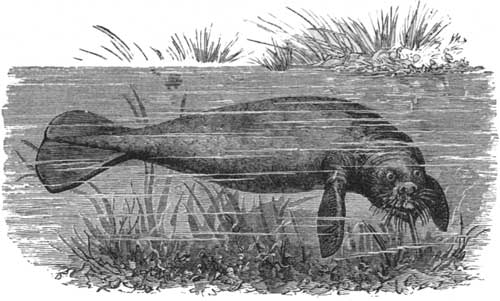 The Manatee or Sea-Cow grazing.
The Manatee or Sea-Cow grazing.
5. The manatee abounds in the interlaced tributaries of the Amazon and Orinoco, and in the lagoons formed by these rivers during the rainy season, where he finds abundance of his favorite food. Of this habit of the animal the Indians take advantage to secure a large amount of game, choosing some particular lagoon for their work. When the water begins to drain off as the rivers fall, they construct across the channel a strong barricade. This consists of large stakes driven closely together, allowing the water to slowly drain through, but stopping the passage of any large body. This dam is strengthened in every possible way to resist the weight of the enormous mass of manatees, turtle, and fish on their way to the river. The lagoon then becomes[Pg 201] a fish magazine. It is scarcely credible the number and size of the creatures secured in this way, whole Indian tribes subsisting for months together on the supply afforded by one of these reservoirs.
6. But as the lagoons will drain off toward the close of the rainy season, and the Indians can not exhaust the supply of fish within, they are compelled at last to remove the barricade and let the last of the imprisoned creatures swim off to the rivers. It is related that, on one occasion, the Indians haying neglected this precaution until too late, more than three thousand manatees, and a still greater multitude of fish, perished. Of all the inhabitants of the lagoon, the turtles alone found themselves in favorable conditions.
7. The address displayed by an Indian of the Orinoco in capturing one of these monsters with a harpoon, his only assistant, his wife, to paddle and steer the canoe, is something wonderful. While the woman propels the canoe the man stands erect at the bow, watching the moment when the manatee comes up to the surface to breathe, which it does every few minutes. Off flies the double-barbed harpoon from the hands of the fisherman, and implants itself in the thick hide of the doomed monster. The manatee no sooner feels the piercing blow than away he darts with fearful rapidity, dragging along after it the frail canoe, to the bow of which is attached one end of the thong, while the other is firmly secured in the iron head of[Pg 202] the harpoon. This thong is made from the hide of a manatee, and is long enough to give the monster some play.
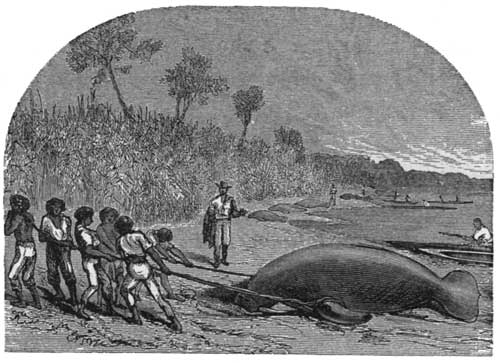 Capturing a Manatee or Sea-Cow.
Capturing a Manatee or Sea-Cow.
8. After vain endeavors to avoid the danger that threatens it, now dashing rapidly against the stream for an hour, now seeking the calm surface of a neighboring lagoon, during which time the sporting couple manage with difficulty to keep their seats at the bottom of the canoe, holding fast to the sides with both hands, the monster, bleeding and exhausted, slackens its pace and finally stops altogether.
9. Now the hunter commences to pull toward it with much caution; but no sooner does the manatee see the dreaded canoe than off it sets anew at the same lightning speed, but of shorter duration.[Pg 203] Again the hunter pulls the game toward him, and again it endeavors to get away; but, having lost nearly all its strength, it stops, rolls on its back, and awaits its fate on the surface of the water. The canoe is now brought alongside of the captive, and, without further ceremony, the Indian cuts it open with his knife.
10. And now what shall he do with it in the midst of a river or lagoon four or five miles broad? How can this carcass, weighing a thousand pounds, be safely landed on the shore? Nothing easier, as we shall see. Having secured their game, the hunters plunge in the water, swimming all the while with one hand and foot, while with the other they turn over the canoe until it partly fills with water, which brings it on a level with the carcass of the manatee. This accomplished, the rest is easily done by sliding the canoe under the carcass, and then bailing out the water by means of the calabash-cups which they wear on their heads in place of hats.
11. As the water goes out, the canoe rises above the surface, and, when sufficiently high, the husband leaps on to the head of the animal and calmly takes his seat. The wife finds a seat on the broad tail of the fishy monster, and the two slowly paddle toward the shore. They are eagerly welcomed by numerous friends and relatives, and the flesh is soon cut up and distributed among them.[Pg 204]
1. The seal, like the whale, claims a place with the four-footed tribes. "The seal family," says Hartwig, "forms a still nearer approach to quadrupeds, as here hind-feet begin to make their appearance. The shortness of these extremities renders their movements upon land generally awkward and slow, but they make up for this deficiency by an uncommon activity in the water. Their body, tapering fish-like from the shoulders to the tail; their abundance of fat, the lightness of which is so favorable to swimming; the position of their feet, admirably formed for rowing, paddling, and steering—their whole economy, in a word, is calculated for the sea. Although citizens of two worlds, their real element is evidently the water, from which their food is exclusively derived.
2. "Seals are found in almost all seas, but they particularly abound on the coasts of the colder regions of the earth, and diminish in size and numbers as they approach the torrid zone. Small seals are found near Surinam, but the giants of the family—the huge sea-elephant, the sea-lion, the sea-bear—belong exclusively to those higher latitudes which the sun visits only with slanting rays, or where the winter forms a dreary and continuous night. How wonderful to see the desolate coasts[Pg 205] of the icy seas peopled by such herds of great, warm-blooded mammalia! But there, where the dry land produces only the scantiest vegetation, the beautiful sea teems with fishes, affording abundance to the hungry seals.
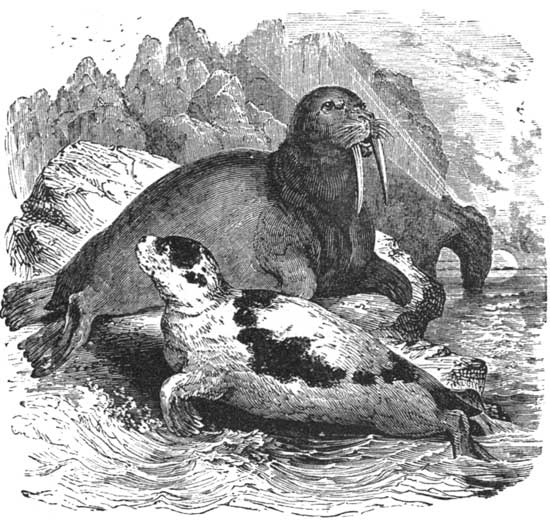 Harp-Seal and Walrus.
Harp-Seal and Walrus.
3. "The Greenland Esquimau, whose icebound fatherland affords no food but berries, is also obliged to look to the sea for his subsistence; and the seal plays as important a part in his humble existence as the reindeer among the Laplanders, or the camel among the Bedouins of the desert. Its flesh and fat form his principal food; from its[Pg 206] skin he makes his boat, his tent, his dress; from its sinews and bones, his thread and needles, his fishing-line, and bow-strings. Thus, on the frozen confines of the Polar Sea, as in many other parts of the world, we find the existence of man almost entirely depending on that of a single class of animals.
4. "But the Bedouin who tends the patient dromedary, or the Laplander who feeds on the flesh and milk of the domestic reindeer, enjoys an easy life when compared to the Esquimau, who, to satisfy the cravings of his sharp appetite, is in all seasons obliged to brave all the perils of the Arctic Ocean. Sometimes he waits patiently for hours in the cold fog, until a seal rises to the surface, or else he warily approaches a herd basking or sleeping on the ice-blocks, for the least noise awakens the watchful animals. Sometimes he has recourse to stratagem, covers himself with a seal-skin, and, imitating the movements and gestures of the deceived phocæ, introduces himself into the midst of the unsuspecting troup.
5. "We read in the 'Odyssey' how the dark-featured hero Menelaus deigned to conceal his royal limbs under a fresh seal-skin in order to surprise Proteus, the infallible seer; and what sufferings his olfactory organs underwent from the
'Unsavory stench of oil and brackish ooze,'
until the fair sea-nymph Erdothea, whom the gallant chief implored in his distress,[Pg 207]
'With nectar'd drops the sickening sea restored.'
Fortunately for the Esquimaux, his nose is less sensitive than that of a son of Atreus, and, without ambrosia, he willingly dons a disguise which affords his unsophisticated taste the pleasure of a theatrical entertainment, combined with the profit of a savory prize.
6. "Physical strength, dexterity, caution, quickness of eye, and acuteness of hearing, are the indispensable qualities of the Esquimaux, and require to be exercised and developed from the tenderest years. The boy of fifteen must be as perfect a seal-catcher as his father, and be able to make all the instruments necessary for the chase. In these inhospitable regions every one is obliged to rely on himself alone; then, when all the powers of body and mind are taxed to the utmost for the mere sustenance of life, weakness and want of dexterity must evidently succumb."
7. The sea-elephant, inhabiting the coasts of Chili, Terra del Fuego, and the shores of New Zealand, is one of the ugliest of all beasts. It is from twenty to twenty-five feet long, and, seen at a distance, it might be taken for an enormous snail. Its head is wide and short, with bristles over the eyes; the upper lip is longer than the lower, and the snout stands out like a short proboscis. Its fore-feet are small, ending in five long claws; the hind-feet are longer, with clawless toes. The tail is thick, and shaped like a cone.[Pg 208] Its value consists in the oil obtained from its carcass.
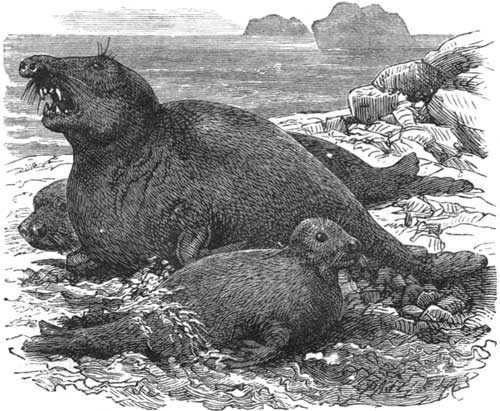 The Sea-Elephant.
The Sea-Elephant.
8. "Though not uniform in size," says Charles Lauman, "they not infrequently attain a length of thirty feet and a circumference of fifteen or eighteen feet, the blubber of a single individual sometimes yielding three hundred gallons of oil, which is considered more valuable than that of the whale. The grown males have a lengthened snout, which gives them the name they bear; their teeth are short and deeply rooted, the molars small and pointed, and the power of their jaws so great that an angry male specimen has been known to seize a dead comrade, weighing a ton, and[Pg 209] toss him a considerable distance as a dog would a mouse.
9. "When quite young they are called silver-gray pups from their color, but as they mature they become brown, the males inclining to a dark blue, and the females to a yellow shade; their home is in the sea, but they have a fashion of spending much of their time upon the shore, occasionally going inland two or three miles and luxuriating in fresh-water marshes; they are sluggish in their movements and somewhat stupid, and in certain localities they congregate in large herds or corrals. Their tongues are used by the sailors as a welcome delicacy, and by the Yankee boys frequently worked into mince-pies; the scraps which are left after the blubber has been tried out are employed as fuel with which the trying process is carried on. Their food is supposed to consist chiefly of cuttlefish and sea-weed, and the instrument employed in killing them is a sharp lance, which penetrates the throat and causes them to bleed to death.
10. "The mothers usually remain in charge of their young about two months, and during all that time the male occupies a convenient eminence, with his head generally toward the sea, and acts as sentinel to prevent the mothers from abandoning their young. In former times the men who hunted them invariably spared all the cubs they met, but in these latter days the young and old are slaughtered indiscriminately." The sea-lions, so common in our[Pg 210] zoölogical gardens, are cousins of the seal, and abound along the coast of the Pacific as far as the Straits of Magellan, where they are most numerous.
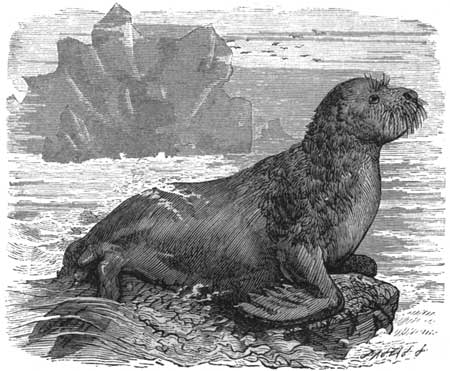 The Sea-Lion.
The Sea-Lion.
11. Another relative of the seal is the walrus, which has been described at length by Dr. Kane: "The head of the walrus has not the characteristic oval of the seal; on the contrary, the frontal bone is so covered as to present a steep descent to the eyes, and a square, blocked-out aspect to the upper face. The muzzle is less protruding than the seal's, and the cheeks and lips are completely masked by the heavy, quill-like bristles. Add to this the tusks as a garniture to the lower face, and you have for the walrus a grim, ferocious aspect, peculiarly his[Pg 211] own. I have seen him with tusks nearly thirty inches long; his body not less than eighteen feet. When of this size he certainly reminds you of the elephant more than any other living monster."
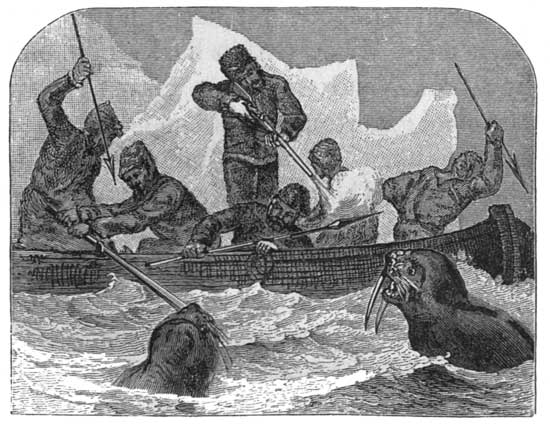 Hunting the Walrus.
Hunting the Walrus.
12. In his description of an Esquimaux hunt for the walrus, Dr. Kane writes: "After a while Myouk became convinced, from signs or sounds, or both, that the walrus were waiting for him in a small space of recently open water that was glazed over with a few days' growth of ice; and, moving gently on, they soon heard the characteristic bellow. The walrus, like some of the higher order of beings to which he has been compared, is fond of his own music, and will lie for hours listening to himself. His vocalization is something between[Pg 212] the mooing of a cow and the deepest baying of a mastiff—very round and full, with its barks of detached notes repeated rather quickly seven to nine times in succession.
13. "The party now formed in single file, following in each other's steps, and wound behind hummocks and ridges in a serpentine approach toward a group of pond-like discolorations, recently frozen ice-spots, but surrounded by firmer and older ice. When within half a mile of these, the line broke, and each man crawled toward a separate pool; Morton, on his hands and knees, following Myouk. In a few minutes the walrus were in sight. They were five in number, rising at intervals through the ice in a body, and breaking it up with an explosive puff that might be heard for miles. Two large, grim-looking males were conspicuous as leaders of the group.
14. "Now for the marvel of the craft. When the walrus is above water, the hunter is flat and motionless; as he begins to sink, the hunter is alert and ready for a spring. The animal's head is hardly below the water-line before every man is on a rapid run; and again, as if by instinct, before the beast returns, all are motionless, behind protecting knolls of ice. They seem to know beforehand not only the time he will be absent, but the very spot at which he will reappear. In this way Myouk, with Morton at his heels, has reached a thin plate of ice, hardly strong enough to bear[Pg 213] them, at the very brink of the water-pool the walrus are curveting in.
15. "Myouk, till now stupid, seems to waken with excitement. His coil of walrus-hide, a well-trimmed line of many fathoms' length, is lying at his side. He fixes one end of it in an iron barb, and fastens this loosely by a socket upon a shaft of unicorn's horn; the other end is already looped, or, as sailors would say, in a bight.' It is the work of a moment. He has grasped the harpoon; the water is in motion. Puffing with pent-up respiration, the walrus is within a couple of fathoms, close before him. Myouk rises slowly, his right arm thrown back, the left flat at his side. The walrus looks about him, shaking the water from his crest. Myouk throws up his left arm, and the animal, rising breast high, fixes one look before he plunges. It has cost him all that curiosity can cost; the harpoon is buried under his left flipper."
1. Most people, if asked the question, What is a bat? would be likely to say that it is a kind of bird. But there is nothing about the bat that likens it to a bird, except that it flies in the air. In its structure and habits it is a mammal; it lays[Pg 214] no eggs, it brings forth its young alive, and for flying it has no regular wings. "In general form," says Mr. Wood, "the bats are clearly separated from any other group of animals, and, by evident peculiarities of structure, can be recognized by the most hasty glance. The first peculiarity in the bat which strikes the eye is the wide and delicate membrane which stretches round the body, and which is used in the place of the wings with which birds are furnished. In order to support this beautiful membrane, to extend it to its requisite width, and to strike the air with it for the purposes of flight, the bones of the fore-part of the body are specially formed.
2. "The finger-bones are strangely disproportioned to the remainder of the body, the middle finger being considerably longer than the head and body together. The thumb is very much shorter than any of the fingers, and furnished with a sharp and curved claw. By means of this claw the bat is enabled to walk along a level surface, and to attach itself to any object that may be convenient. The lower portions of the body and limbs are singularly small in proportion to the upper limbs. The legs are short and slender, and so arranged that the feet are rather turned outward, for the purpose of using the claws freely.
3. "One of the most common, and at the same time the most elegant, of the Cheiroptera, or wing-handed animals, is the well-known long-eared bat.[Pg 215] I have possessed several specimens of this bat, one of which was captured under peculiar circumstances. It had entered a grocer's shop, and, to the consternation of the grocer and his assistant, had got among the sugar-loaves which were piled on the upper shelf. So terrible a foe as the bat (nearly two inches long) put to rout their united forces, and, beyond poking at it with a broom as it cowered behind the sugar, no attempts were made to dislodge it. At this juncture my aid was invoked, and I accordingly drew the bat from its hiding-place. It did its best to bite, but its tiny teeth could do no damage even to a sensitive skin.
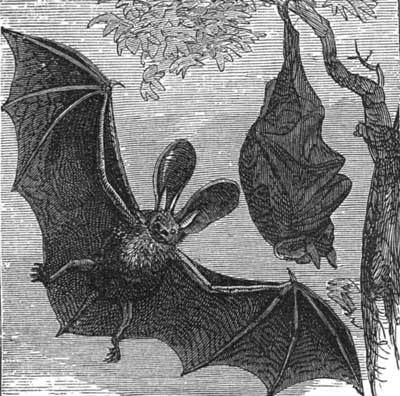 The Long-eared English Bat.
The Long-eared English Bat.
4. "The bat was then placed in an empty mouse-cage, and soon became sufficiently familiar[Pg 216] to eat and drink under observation. It would never eat flies, although many of these insects were offered, and seemed to prefer small bits of raw beef to any other food. It was a troublesome animal to feed, for it would not touch meat unless it was freshly cut and quite moist, forcing me to prepare morsels fit for its dainty maw six or seven times daily. It spent the day at the top or on the side of its cage, being suspended by its hinder claws, and would occasionally descend in order to feed and drink. While eating, it would lower itself from the cage roof, and crawl along the floor until it reached the piece of meat. The wings[Pg 217] were then thrown forward so as to cover the food, and under the shelter of its wings the bat would drop its head over the meat and then eat it.
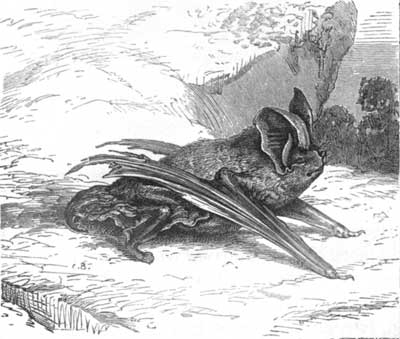 A Bat walking.
A Bat walking.
5. "On account of the sharp surface of its teeth, it could not eat its food quietly, but was forced to make a series of pecking bites, something like a cat in similar circumstances. It would drink in several ways, sometimes crawling up to the water-vessel and putting its head into the water, but usually lowering itself down the side of the cage until its nose dipped in the liquid. When it had thus satisfied its thirst, it would reascend to the roof, fold its wings about itself, and betake itself to slumber once more.
6. "I kept the little animal some time, but it did not appear to thrive, having, in all probability, been hurt by the broom-handle which had been used so freely against it, and at last was found dead in its cage from no apparent cause. Although dead, it still hung suspended, and the only circumstance that appeared strange in its attitude was that the wings drooped downward instead of being wrapped tightly around the body."
7. It is well known that bats fly only by night, and that their chief diet is flies, although the flying foxes of South America eat fruit. They also spend the winter in that peculiar state of sleep called hibernation. For this purpose they assemble in large numbers in caverns, hollow trees, or the roofs of buildings, and hang by their claws[Pg 218] with their heads downward. During this period they breathe slightly, and the blood circulates very slowly. The flight of the bat is fluttering, but it is a true flight and not like the spring of flying-fish and flying-squirrels. The human expression in the head of the bat has often been noted.
8. The flying-fox, fox-bat, or kalong of Java, is dull black in color, except the upper part of the neck, which is reddish. It is a giant of its kind, measuring, from tip to tip of its wings, five feet. "They pass the greater part of the day in sleep, hanging motionless, ranged in succession, with the head downward, the membrane folded about the body, and often in close contact. They have little resemblance to human beings, and are easily mistaken for a part of the tree, or for a fruit of uncommon size, suspended from its branches. In general these societies preserve perfect silence during the day, but if they are disturbed they emit sharp, piercing cries. Soon after sunset they gradually quit their hold and pursue their nocturnal flight in quest of food, which consists chiefly of the fruits of plantations and villages.
9. "They direct their course by unerring instinct to the forests, villages, and plantations, attacking and devouring every kind of fruit, from the abundant and useful cocoa-nut which surrounds the dwellings of the meanest peasantry to the more rare and delicate productions cultivated with care by princes and chiefs. Delicate fruits[Pg 219] are only secured by means of a loose net or basket skillfully constructed of split bamboo."
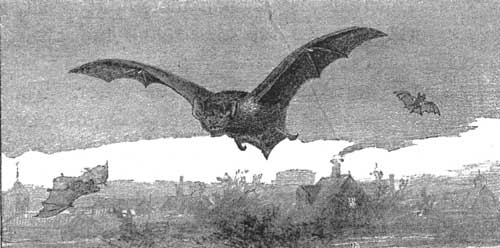 The Common Bat.
The Common Bat.
10. The vampire-bat has its home in South America, covering a vast extent of territory from Paraguay to the Isthmus of Darien. The length of its body is only six inches, including its tail, and the spread of its wings about two feet. The color of its fur is like that of the mouse. Strange stories have been told of these specter vampires, and it has been a much-debated question whether or not they bite human beings. The fact, however, is settled by Mr. Watterton: "As there was a free entrance and exit to the vampire in the loft where I slept, I had many a fine opportunity of paying attention to this nocturnal surgeon. He does not always live on blood. When the moon shone bright, and the fruit of the banana-tree was ripe, I could see him approach and eat it. He[Pg 220] would also bring into the loft, from the forest, a green, round fruit something like the wild guava, and about the size of a nutmeg.
11. "There was something also in the blossom of the nut-tree which was grateful to him, for, on coming up the creek on a moonlight night, I saw several vampires fluttering round the sawarri-tree, and every now and then the blossoms which they had broken off fell into the water. They certainly did not drop off naturally, for, on examining several of them, they appeared quite fresh and blooming. So I concluded the vampires pulled them from the tree, either to get at the incipient fruit, or to catch the insects which often take up their abode in flowers.
12. "The vampire, in general, measures about twenty-six inches from wing to wing, extended, though I once killed one which measured thirty-one inches. He frequents old, abandoned houses and hollow trees, and sometimes a cluster of them may be seen in the forest hanging head downward from the branch of a tree. Goldsmith seems to have been aware that the vampires hung in clusters, for, in the "Deserted Village," speaking of America, he says:
"'And matted woods, where birds forget to sing,
But silent bats in drowsy clusters cling.'
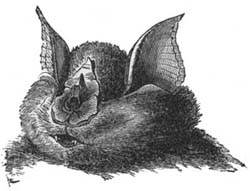 Head of Horseshoe Bat.
Head of Horseshoe Bat.
13. "The vampire has a curious membrane, which rises from the nose, and gives it a very[Pg 221] singular appearance. There are two species of vampire in Guiana, a larger and a smaller. The larger sucks men and other animals; the smaller seems to confine himself chiefly to birds. I learned from a gentleman high up on the river Demerara that he was wholly unsuccessful with his fowls on account of the small vampire. He showed me some that had been sucked the night before, and they were scarcely able to walk.
14. "Some years ago I went to the river Paumaron with a Scotch gentleman. We hung our hammocks in the thatched loft of a planter's house. Next morning I heard this gentleman muttering in his hammock, and now and then letting fall an imprecation or two just about the time he ought to have been saying his morning prayers. 'What is the matter, sir?' said I, softly; 'is anything amiss?' 'What's the matter?' answered he, surlily; 'why, the vampires have been sucking me to death.' As soon as there was light enough I went to his hammock, and saw it much stained with blood. 'There,' said he, thrusting his foot out of the hammock, 'see how those infernal imps have been drawing my life's blood!'[Pg 222] On examining his foot, I found the vampire had tapped his great toe; there was a wound somewhat less than that made by a leech. I conjectured he must have lost from ten to twelve ounces of blood."
1. I tell you I have a smart dog of my own,
His name, sir, is Fido;
The cunningest canine that ever was known
To "cut up a dido!"
His hair it is long, and as soft as fine silk,
It is a sort of a yellow;
He's so dainty, he likes only sweet cake and milk,
The dear funny fellow!
2. He comes when he's called, and he does what he's bid;
Not all boys will do so!
And he'll stand up and wear a fur cap on his head,
Like Robinson Crusoe!
He barks at all beggars, but persons well dressed
He treats more politely—
In which he resembles, it must be confessed,
[Pg 223]Some other folks slightly.
3. Throw a ball, and he'll chase it along everywhere,
Nor stop at your calling;
Toss it up in the air, and he's sure to be there
To seize it when falling;
Throw a stick in a pond, and at once, with a bound,
He will jump in the water—
Little Tilly fell in once, and would have been drowned
If he hadn't caught her.
4. He's so wise that when bad boys once managed to tie
To his tail a tin kettle,
He turned, picked it up in his mouth, and so high—
Being put to his mettle—
He jumped o'er the palings and made so much noise,
The sound reached the kitchen;
And the servants ran out and soon caught both the boys,
And gave them a switchin'.
5. He knows me so well that whenever he hears
The tone of my voice, sir,
You might think him human, so much he appears
[Pg 224]At the sound to rejoice, sir.
So I can't treat him ill, and I'm certain that he
Loves me well and sincerely;
And he's always so good and so gentle to me,
That I love him most dearly!
L. J. Cist, in St. Nicholas.
[A] Pronounced hela.
THE NATURAL HISTORY SERIES. By James Johonnot, author of "Principles and Practice of Teaching," "Geographical Reader," "How We Live," etc.
No. 1. Book of Cats and Dogs, and other Friends. For Little Folks. 12mo. 96 pages. Deals with the familiar animals of the house and farm-yard.
No. 2. Friends in Feathers and Fur and other Neighbors. For Young Folks. 12mo. 140 pages. Gives an account of the chickens, ducks, and geese about home, and of the birds, squirrels, rabbits, and other animals found near home.
No. 3. Neighbors with Wings and Fins and some others. For Boys and Girls. Interspersed with interesting stories, it gives descriptions of birds, reptiles, and insects, in such a way as to lead to scientific classification.
No. 4. Neighbors with Claws and Hoofs and their Kin. For Young People. Begins with the familiar animals of house and field, and reaches out to a general description and classification of mammals.
No. 5. Glimpses of the Animate World: Science and Literature of Natural History. For School or Home. 12mo. 414 pages. Treats of special topics, and is made up of the literature of natural history. The articles are from the pens of some of our most distinguished scientists and literary writers.
The publication of this series marks a distinct and important advance in the adaptation of special knowledge and general literature to the intelligent comprehension of pupils of all grades of attainment. The importance of this movement and its value to the present generation of school-children can not be overestimated. While in no wise tending to do away with the regular school-readers, philosophically constructed in accordance with correct educational principles, the "Instructive Reading-Books" introduce suggestive and valuable information and specific knowledge, covering many of the subjects which will eventually be more minutely investigated by the maturing of the pupil's mind.
Natural History in the Instructive Reading Course is to be followed by History, Geography, Science, and the Industries—all topics to arouse attention in their turn, and to fill the mind with knowledge of the greatest use. These are now in preparation, and will be announced in detail from time to time.
New York: D. APPLETON & CO., 1, 3, & 5 Bond Street.
How we Live; or, the Human Body, and How to take Care of it. An Elementary Course in Anatomy, Physiology, and Hygiene. By James Johonnot, author of "Principles and Practice of Teaching," "Geographical Reader," "Natural History Reader," etc., Eugene Bouton, Ph. D., and H. D. Didama, M. D.
Thoroughly adapted to elementary instruction in the public schools; giving special attention to the laws of Hygiene (including the effects of alcohol and narcotics on the human system) as ascertained from a careful study of Anatomy and Physiology; containing also a full Glossary of Terms, complete Index, etc.
The Essentials of Anatomy, Physiology, and Hygiene. By Roger S. Tracy, M. D., Sanitary Inspector of the New York City Health Department.
This work has been prepared in response to the demand for a thoroughly scientific and yet practical text-book for schools and academies, which shall afford an accurate knowledge of the essential facts of Anatomy and Physiology, as a scientific basis for the study of Hygiene and the Laws of Health, the applications of which are clearly and carefully stated throughout. It also treats of the physiological effects of alcohol and other narcotics, fulfilling all the requirements of recent legislative enactments upon this subject.
Teachers and School-Officers should correspond with us before introducing a new work upon this subject.
D. APPLETON & CO., Publishers,
NEW YORK, BOSTON, CHICAGO, SAN FRANCISCO.